He Can Dig It
Soil health, climate change and the effect on humans p24
Tribe and Timber
How a UW professor learned from the Yakama Nation p28
Making Waves
UW women’s crew has its own rich history p30
Spin Class
It’s 1988. Welcome to the future of industrial design
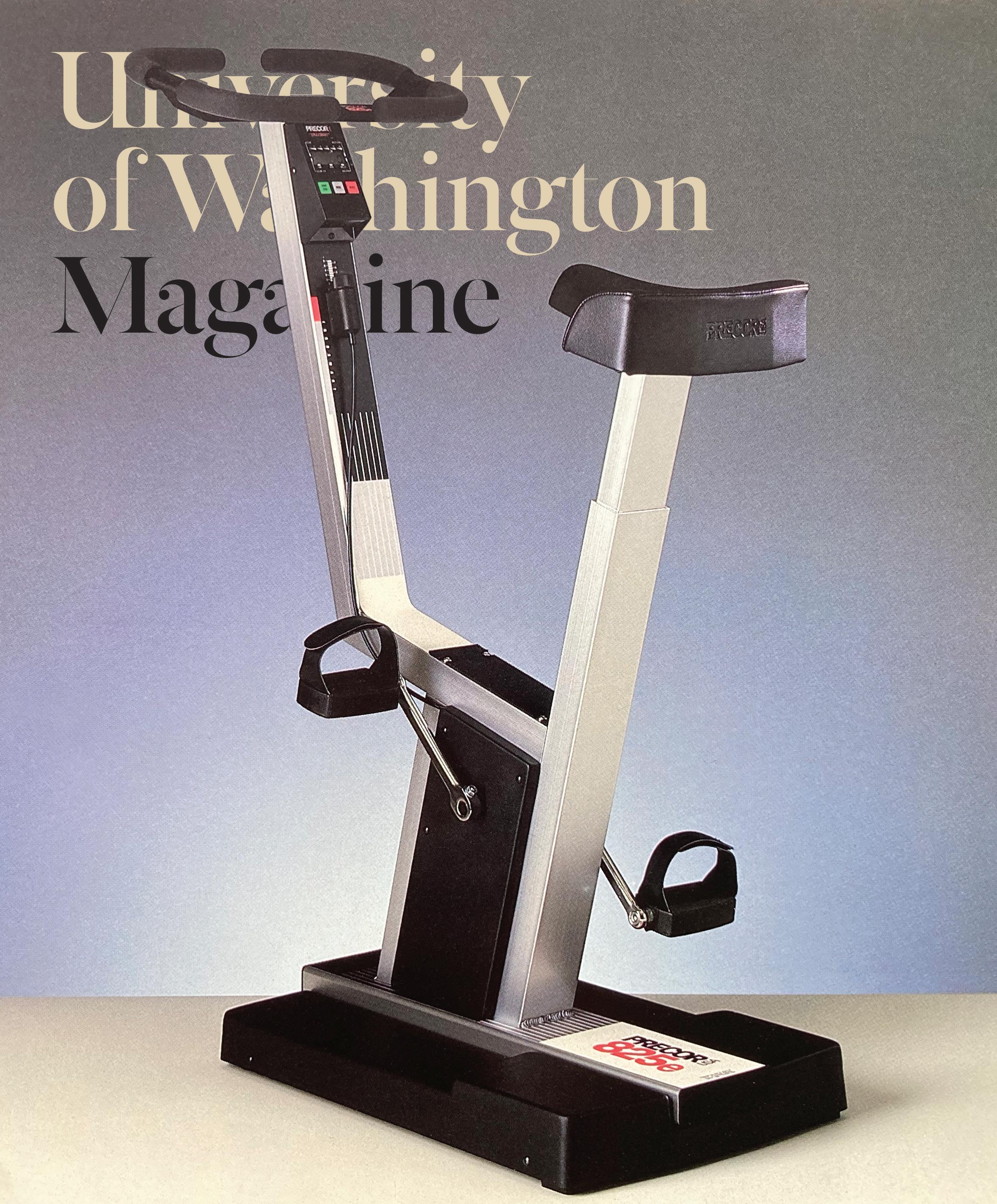
Bucking Tradition
Kittitas Valley, home to ranches, orchards and waving fields of Timothy hay, is every bit as bucolic as it was a century ago when, in 1923, the Ellensburg Rodeo first sprang from the gates. The area had long been a meeting place for Columbia Plateau tribes. Local bands of the Yakama relied on the valley for trade, pony racing and other competitions and celebrations. Ranchers first ran their cattle here in the 1850s, bringing roundups, fiestas and local ranch contests, all of which culminated in the town’s first rodeo. Professor Emeritus Mike Allen, ’85, is a founding member of the Ellensburg Rodeo Hall of Fame. While not the first in the state, Ellensburg’s rodeo was the first to gain national significance, he says: “By 1924, it was on the map and became one of the
most important rodeos in the Pacific Northwest.” Today, professional cowboys like Clay Stone, pictured here in 2022, come back to compete every September. But it has never lost that small-town feel, thanks to volunteers and organizers like Rick Cole, ’70, who serves on the rodeo’s board of directors, and former student Davis/Yellowash Washines, a Yakama elder as well as a member of the Native American Advisory Board at the Burke Museum. Tradition has it that the rodeo doesn’t start until several members of the Yakama Nation have ridden their horses down Craig’s Hill and into the arena. “That’s the moment you’ve got to be in the grandstands for,” Allen says. “Then the rodeo can begin.” Photo by Evan Abell/ Yakima Herald-Republic
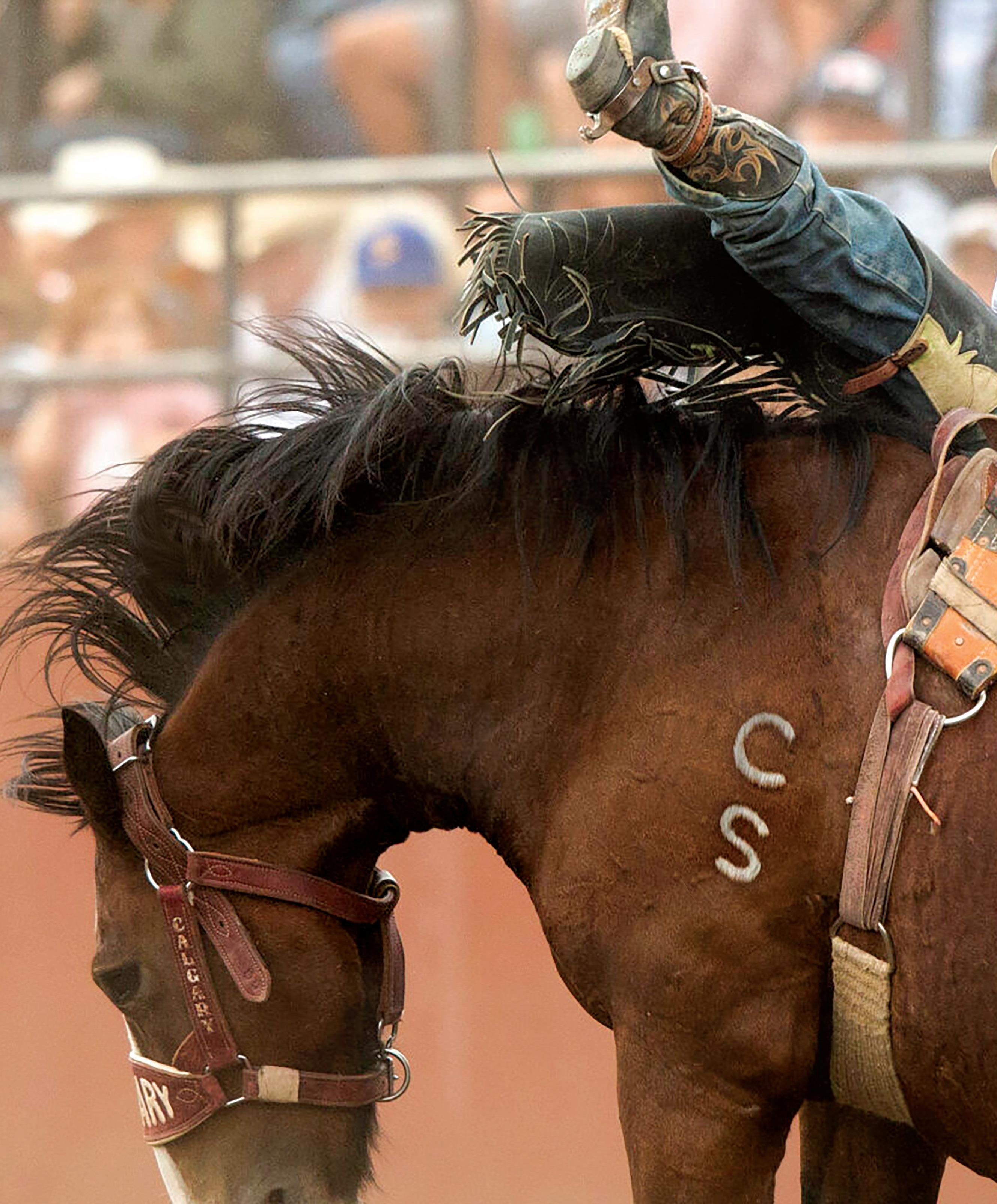

OF WASHINGTON ELLENSBURG
RODEO



SAILGATING HUSKIES FOOTBALL. FIRST WEDNESDAY CONCERTS. SHOPPING AT U VILLAGE. Not an offer or solicitation to sell real property. Thomas James Homes is a registered trademark of Thomas James Homes, LLC. ©2023 Thomas James Homes. All rights reserved. Brokerage: TJH SEATTLE LLC. License #:2101251. General Contractor: SEA HOME BUILDERS LLC. License #: SEAHOHB806DO Discover the convenience, connectedness, and financial potential of a new TJH cottage-style home near University of Washington. From thoughtfully-designed plans to walkable, near-campus locations, our cottage-style homes offer a smart investment opportunity and one-of-a-kind university lifestyle. Find yours at tjh.com/cottages Southern California | Northern California | Pacific Northwest | Colorado | Arizona tjh.com | @ThomasJamesHomes | (877) 381-4092 Invest in the ultimate UW lifestyle with a new TJH cottage-style home. 2 UW MAGAZINE
At the University of Washington, our students and our community have a rich legacy of striving toward a common goal, and we don’t stop at the finish line. When we all combine our individual passions with a shared purpose, we go further, faster — together.

uw.edu/boundless
For pushing yourself. For pulling together. BE BOUNDLESS.
24 He Can Dig It
UW soil scientist David Montgomery shows how systems in nature and those created by humans affect us and the climate.
By Rachel Gallaher
28 Tribe and Timber
Forestry Professor Tom Hinckley learned from the Yakama Nation as they shared their approach to managing forests.
By Caitlin Klask
30 Making Waves
As the opening of “The Boys in the Boat” movie nears, we honor the dedication, hard work and success of UW women’s crew.
VOLUME 34
NUMBER 3
FALL 2023
ONLINE magazine.uw.edu
Coxwain Marilyn Goo, ’73, holds the trophy for the Lightweight 8 rowing team at the 1972 National Women’s Rowing Championships. �he UW women’s crew had formed just a few years earlier and their resources were so limited they had to buy their own uniforms.
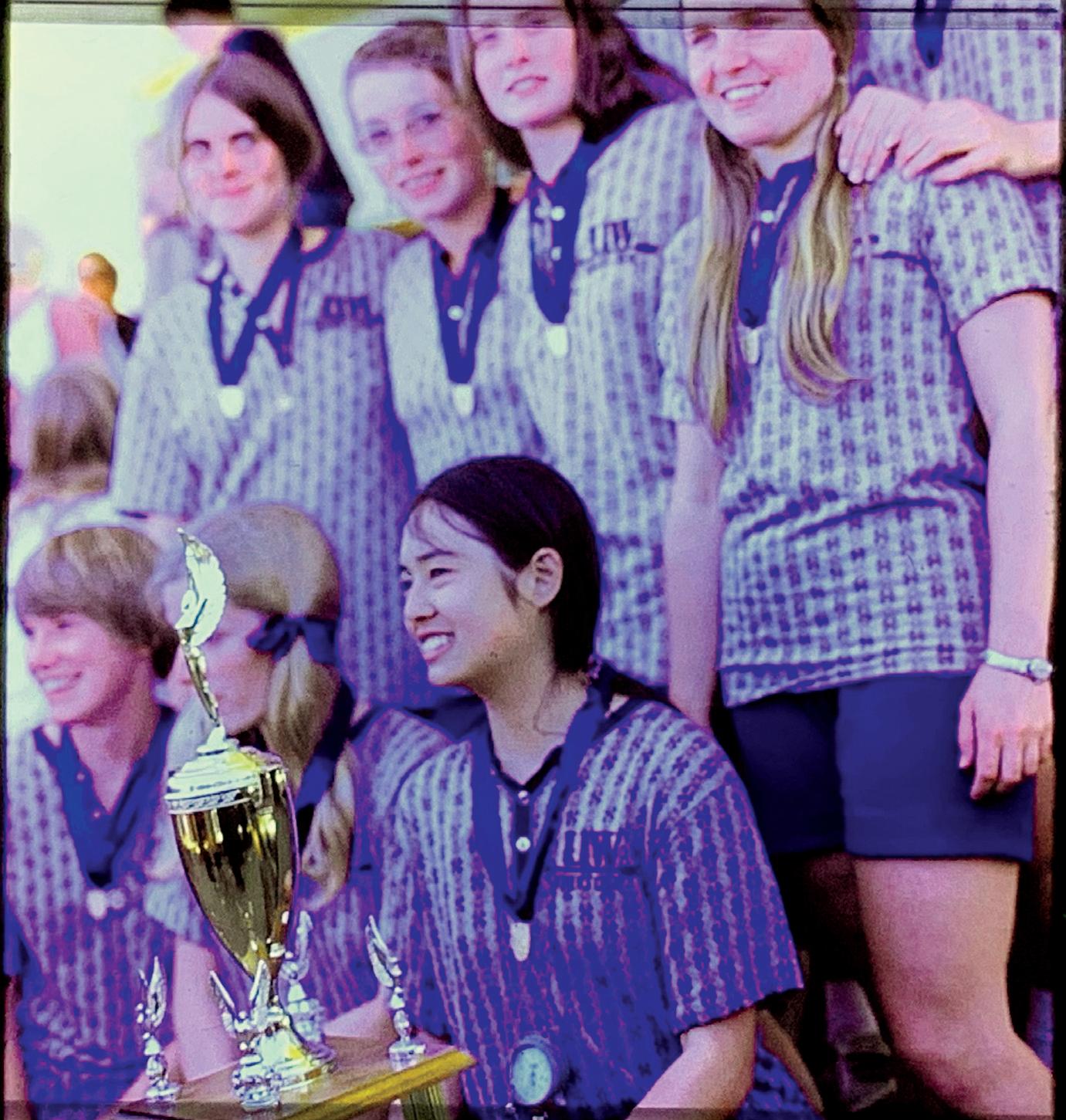
EYE FOR POSITIVES
Author, film photographer, bus driver Nathan Vass, ’09, finds inspiration in the everyday. Meet the Husky behind the lens (and the wheel) at uwmag.online/vass.

FINE JEWELER
From a hobby jeweler to a full-time entrepreneur, Valerie Madison, ’09, champions representation in the fine-jewelry industry. Find out how she got started at uwmag.online/madison.
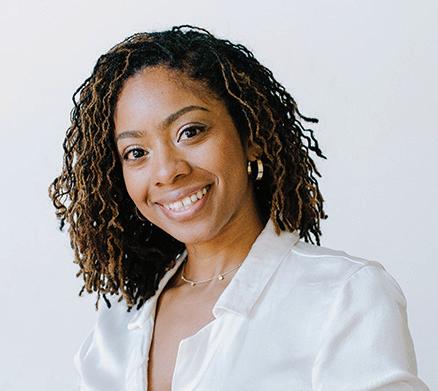
STORIES OF
We’ve rounded up our stories of UW alumni veterans. Be inspired by their bravery at uwmag.online/veterans.
 By Hannelore Sudermann
By Hannelore Sudermann
32 Dandy Design
The field of industrial design has grown thanks to the innovative students and faculty in the School of Art + Art History + Design.
By Steve Kaneko
ON THE COVER
The popular Precor 714/718 Low Impact Climber was designed by industrial designer David Smith, ’70, ’72.
4 UW MAGAZINE
6 Campus and Community 8 A Better Building Block 10 Roar of the Crowd THE HUB 12 Smart Tech 13 State of the Art 18 Research 22 Athletics COLUMNS 38 George Counts’ Legacy 39 Sketches 41 Media 50 New UWAA President 53 Tribute 54 In Memory IMPACT 44 Be REAL 46 Philanthropy’s Finest 48 Night Sky UDUB 56 Peace Corps Legend KIM ILINON
FORWARD
SERVICE
COURTESY NANCY NORDHOFF NATHAN VASS
COURTESY MARILYN GOO
IN WITH THE OLD
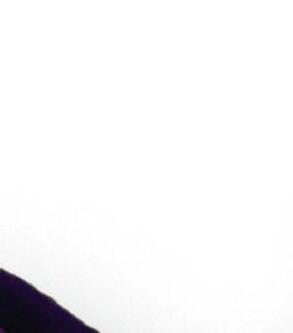









Husky fans, your retro favorites are back in style! Claim these special-edition Rivalry Low sneakers at adidas.com.

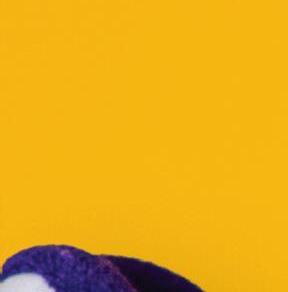
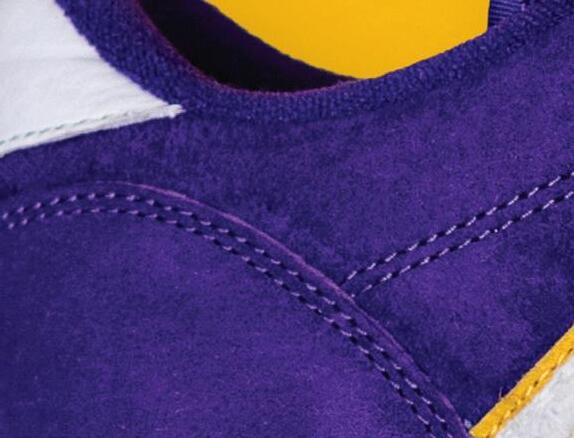
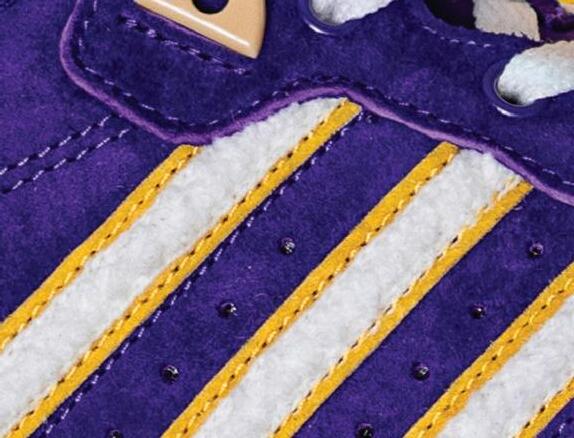
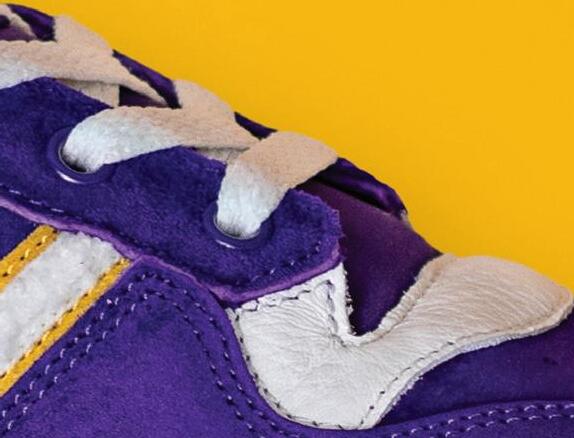



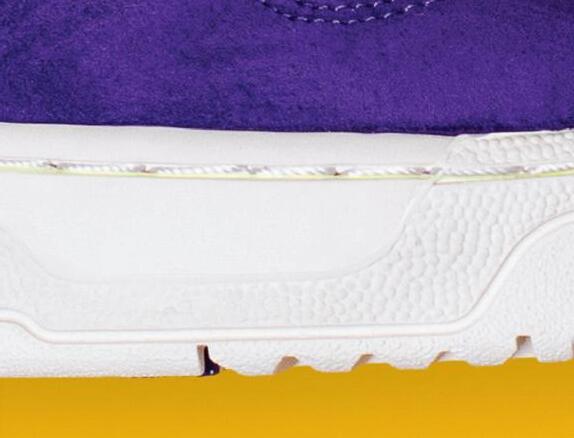
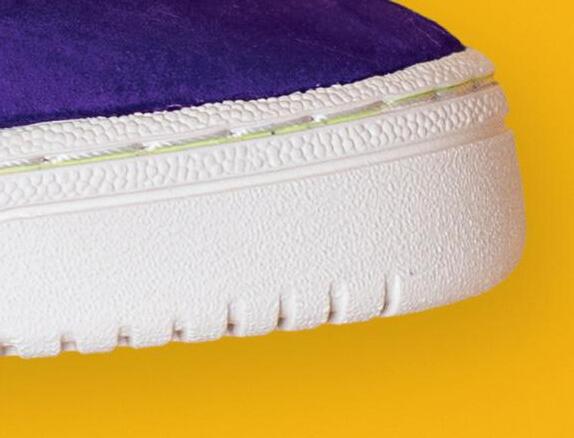
realdawgswearpurple wearpurple real_dawgs
Creating a Campus That Welcomes the Future
By Ana Mari Cauce
When we talk about how the University of Washington can make a meaningful, positive impact in the world—the purest expression of our public mission—we often invoke the notion of our “power to convene.” But what do we mean by this? And how does it shape our role in the communities with which we are engaged?
Serving as a convener means that we can bring diverse stakeholders together in service of shared goals, like leading innovative collaborations that leverage the
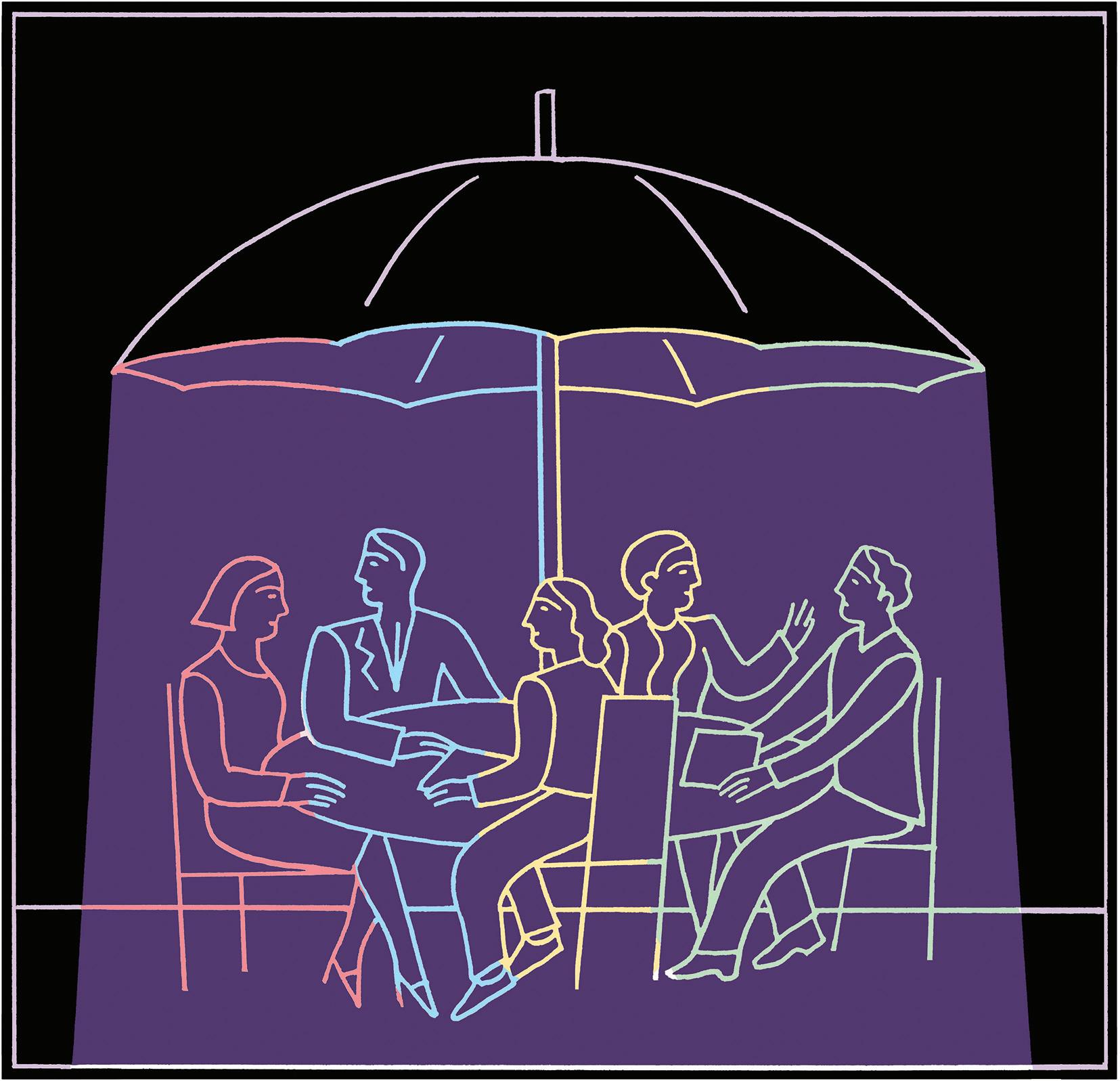
strengths of community members, faculty, students and the public and private sectors. But it also means building community through shared experiences that spark joy and passion, like the annual Bothell Block Party sponsored by our UW Bothell campus in partnership with community leaders, and UW Tacoma’s long-standing collaboration with the local YMCA to create a recreation center that serves students and the public. And shared experiences happen when we come together to root for our
student-athletes and by restoring the historic ASUW Shell House—where the Boys in the Boat launched their 1936 Olympic bid—to host community gatherings.
To meet the needs of our community, including our neighbors, alumni, supporters and fans, we are working to create a truly welcoming campus where people live, play, work and learn. On our campus in Seattle, we are creating actual convening spaces to welcome new ideas and voices to our community.
Several years ago, the Seattle City Council approved the UW Seattle Campus Master Plan, a long-range vision that enables us to develop 3 million square feet west of the current campus from the U District to the waterfront, creating what will be known as Portage Bay Crossing. This area will be a mix of gathering spaces, academic and research facilities, affordable housing units and green space. There, students and faculty from disciplines including public health, clean energy, medicine, social work, public policy, the arts and humanities will be able to partner with business, government, nonprofits and the broader community to work on the big challenges we face.
In planning for the future, we know that our city urgently needs more affordable housing. That’s why the UW and the Seattle Housing Authority are developing a mixed-income high-rise of about 240 units west of campus. The building will provide childcare space as well as much-needed housing near the UW and transit options.
In tandem with Portage Bay Crossing, we are also developing a UW Welcome Center in the U District. It will be the outcome of an innovative partnership between the University Book Store, the UW Alumni Association and the University. We envision it as a front door to the UW—a place for new friends to learn about the University and for old friends to gather and connect.
This is all happening at a pivotal time, as we look forward to the release of the “Boys in the Boat” feature film this winter and prepare to join the Big Ten Conference in August 2024. Our vision of creating welcoming new spaces will help us make the most of these extraordinary opportunities. By cultivating an urban landscape in which the UW is a welcoming place for everyone, we will build on our commitment to collaboration and public service. We look forward to seeing you there.
6 UW MAGAZINE OPINION AND
ILLUSTRATION BY ANTHONY RUSSO
THOUGHT FROM THE UW FAMILY
MESSAGE FROM THE PRESIDENT
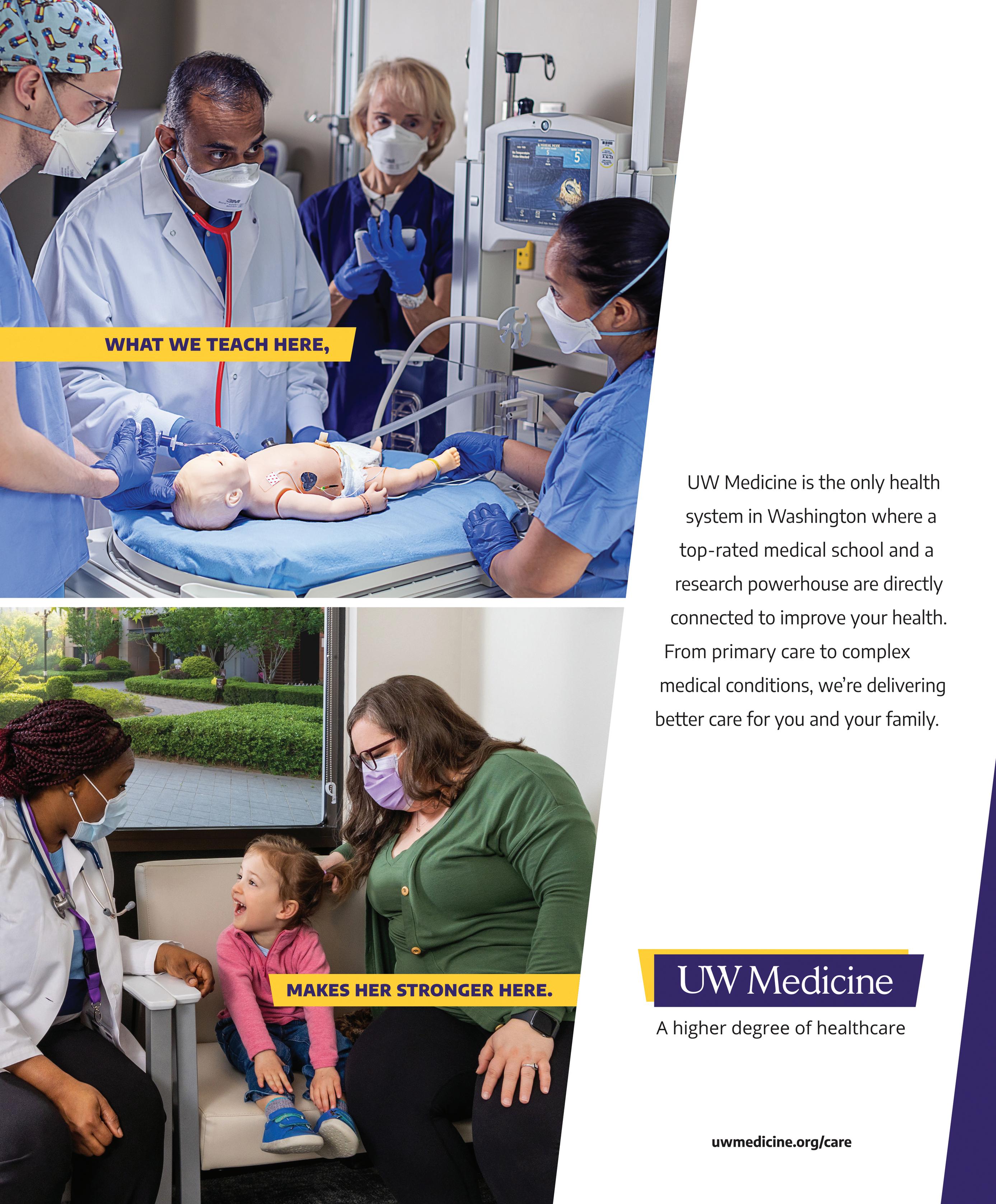
A Better Building Block
By Jon Marmor
Founders Hall, the spectacular recent addition to the Michael G. Foster School of Business, is much more than a space for learning and community building. Forget for a moment that this year-old, privately funded, 85,000-square-foot facility provides some of the most state-of-the-art classrooms, conference rooms and social spaces on the campus in Seattle. It is the only University building fully constructed of mass timber. This sustainably sourced composite hardwood has the promise of reducing the costs of construction while increasing a building’s sustainability and reducing carbon in the atmosphere.
As the first UW building that meets the University’s Green Building Standards to reduce its carbon emissions by more than 90%, Founders Hall employs cross-laminated timber decking. The new technology means Founders Hall sequesters more than 1,000 tons of carbon.
It is a monument to innovative, lesscostly and healthier structures that could benefit the environment. And it shows how the UW is helping lead the way in making this innovation a regular part of our lives.
The College of Engineering, College
of Built Environments and the College of the Environment are some of the UW units currently exploring the possibilities for mass timber, to great result. Jeffrey Berman, professor of civil and environmental engineering, was the principal investigator on a project testing a 10-story mass-timber building designed to withstand Seattle-area earthquakes. Then there is the College of Built Environments’ Carbon Leadership Forum. The UW team works with architects, designers and industry to measure and reduce the carbon footprint of building materials. They are exploring how mass-timber buildings can have a positive impact on the environment. And a team from the School of Forest Resources developed regionally specific life-cycle assessment models to evaluate the environmental impact of potential cross-laminated timber production in the Olympic Peninsula—a region that lives by timber production.
The National Science Foundation recently awarded a $1 million grant to the UW, the University of Oregon and Oregon State University to explore expanding the use of mass timber. It looks to be a great building block for the future.

STAFF
A publication of the UW Alumni Association and the University of Washington since 1908
PUBLISHER Paul Rucker, ’95, ’02
ASST. VICE PRESIDENT, UWAA MARKETING & COMMUNICATIONS Terri Hiroshima
EDITOR Jon Marmor, ’94
MANAGING EDITOR Hannelore Sudermann, ’96
ART DIRECTOR Ken Shafer
DIGITAL EDITOR Caitlin Klask
CONTRIBUTING STAFF Karen Rippel Chilcote, Kerry MacDonald, ’04
UWAA BOARD OF TRUSTEES PUBLICATIONS
COMMITTEE CO-CHAIRS
Chair, Sabrina Taylor, ’13 Vice Chair, Roman Trujillo, ’95
CONTRIBUTING WRITERS
Rachel Gallaher, Genevieve Haas, Steve Kaneko
CONTRIBUTING PHOTOGRAPHERS
Matt Hagen, April Hong, Anil Kapahi, Kris Ladera, Meryl Schenker, Ron Wurzer
CONTRIBUTING ILLUSTRATORS
Joe Anderson, Olivier Kugler, David Plunkert, Anthony Russo
EDITORIAL OFFICES
Phone 206-543-0540
Email magazine@uw.edu
Fax 206-685-0611
4333 Brooklyn Ave. N.E.
UW Tower 01, Box 359559
Seattle, WA 98195-9559
ADVERTISING
SagaCity Media, Inc.
509 Olive Way, Suite 305, Seattle, WA 98101
Megan Holcombe mholcombe@sagacitymedia.com
703-638-9704
Carol Cummins ccummins@sagacitymedia.com
206-454-3058
Robert Page rpage@sagacitymedia.com
206-979-5821
University of Washington Magazine is published quarterly by the UW Alumni Association and UW for graduates and friends of the UW (ISSN 1047-8604; Canadian Publication Agreement #40845662). Opinions expressed are those of the signed contributors or the editors and do not necessarily represent the UW’s official position. �his magazine does not endorse, directly or by implication, any products or services advertised except those sponsored directly by the UWAA. Return undeliverable Canadian addresses to: Station A, PO Box 54, Windsor, ON N9A 6J5 CANADA.
8 UW MAGAZINE
ILLUSTRATION
BY DAVID PLUNKERT
MESSAGE FROM THE EDITOR


Mirabella Seattle is a resident-centered, not-for-profit Pacific Retirement Services community and an equal housing opportunity. According to the data, Seattle is the most well-read city in the country. And, according to our residents, Mirabella is the most well-read senior community in Seattle. Professor? Scholar? Bookworm? You’ve found your place. Call today to schedule a tour. 116 Fairview Ave N • Seattle • 206.337.0443 www.mirabellaseattle.com It was soul mates at first simile. Find Your People in South Lake Union
Professor Frey’s Finest
I was saddened to read of the passing of Professor Charles Frey. I was in Professor Frey’s Shakespeare course in 1994. In a required seminar with 50 students, Professor Frey had the magical ability to transform the room into a creative and intimate space. The encouragement he gave me shaped my writing and teaching. He taught us that the study of literature makes us all better humans.
Alison E. Kreiss, ’97, Marion, Montana
A Sad Loss
Your “Pulling Together” and “Paint Ain’t Free” pieces (Summer 2023) reminded me of one the most famous and tragic rowers in Husky history, John Bracken. John never lost a race, freshman, JV or varsity, in his five-year career. Oddly, he never learned to swim. One day in 1942, while sailing on Lake Washington, he was knocked overboard by a swinging boom and drowned. Sad loss of a marvelous person.
Bill Galbraith, ’44, Fernandina Beach, Florida
Britain’s Glory
Please allow me to correct the record in the article “Pulling Together” (Summer 2023). The author is forgetting that Britain also won a gold medal at the 1936 Games. The great rower and Olympian Jack Beresford and Dick Southwood won the final in the double sculls. The U.S. took the gold in the eights, and Germany took gold in five other boat classes. One final was rowed on Aug. 13, the six other finals on Aug. 14.
Goran Buckhorn
Dr. Copass’ Contribution
In the article about Leonard Cobb (“Back From the Brink,” Summer 2023), I miss the mentioning of Dr. Michael Copass, who was very involved in the creation of MedicOne. Years ago, I volunteered with Dr. Cobb on a MedicOne Foundation project, remembering him telling me how much they all worked together to bring the organization to the highest standard and is recognized in many states. There are books written about their endless efforts. It would be great to remember the rule to recognize all creators or none.
Petra H. Walker, Mercer Island
Corrections
Arreguin’s Greatness
I was at the UW while Alfredo Arreguin (see page 54) was getting both of his degrees. I did not realize that our lives during that tumultuous time had several touchpoints. I too had Michael Spafford as a professor in a humanities class. Later, I was in a Seattle AAUW Spanish conversation group with Spafford’s mother-in-law, who had been the librarian at the U.S. Embassy in Mexico City while I was a student there. While I was student-teaching in my last quarter at the UW, Roberto Maestas taught Spanish, and I was privileged to observe him teaching. Maestas and the rest of us had an interesting spring. On April 4, 1968, Martin Luther King Jr. was assassinated. A few days later, partly as a reaction to the tumultuous times, an activist who later became a politician led a group of about 100 students into the school. We were under lockdown that day, and the rest of the year there were plain-clothes police officers in the building. Two days before I graduated from the UW, Robert F. Kennedy was assassinated. I ate lunch almost every day with Maestas, and you could see and hear his outrage growing, which led to his leadership that resulted in the creation of El Centro de la Raza. I wish I could have afforded to buy one of Arreguin’s paintings, and, as a Spanish teacher, I would have loved to have met him. What a loss his passing is.
Carolyn Edwards on Facebook
Missing Our Joe
Joe Jarzynka (“Small in Stature, Big in Our Memories,” Summer 2023) worked for us after college at UW in our parts department at Rood Nissan-Volvo in Lynnwood. He was a great worker (no surprise) and learned to love his enthusiasm. He was a great UW punt returner and will be sorely missed. Godspeed, Joe.
Marty Rood, ’57, Lake Forest Park, on Twitter
Great People
In response to a long-form UW Magazine Instagram post: “Love that you guys are highlighting stories of the outstanding alumni of the University of Washington … some of the greatest people you’ll find anywhere! Great work @uwalum.”
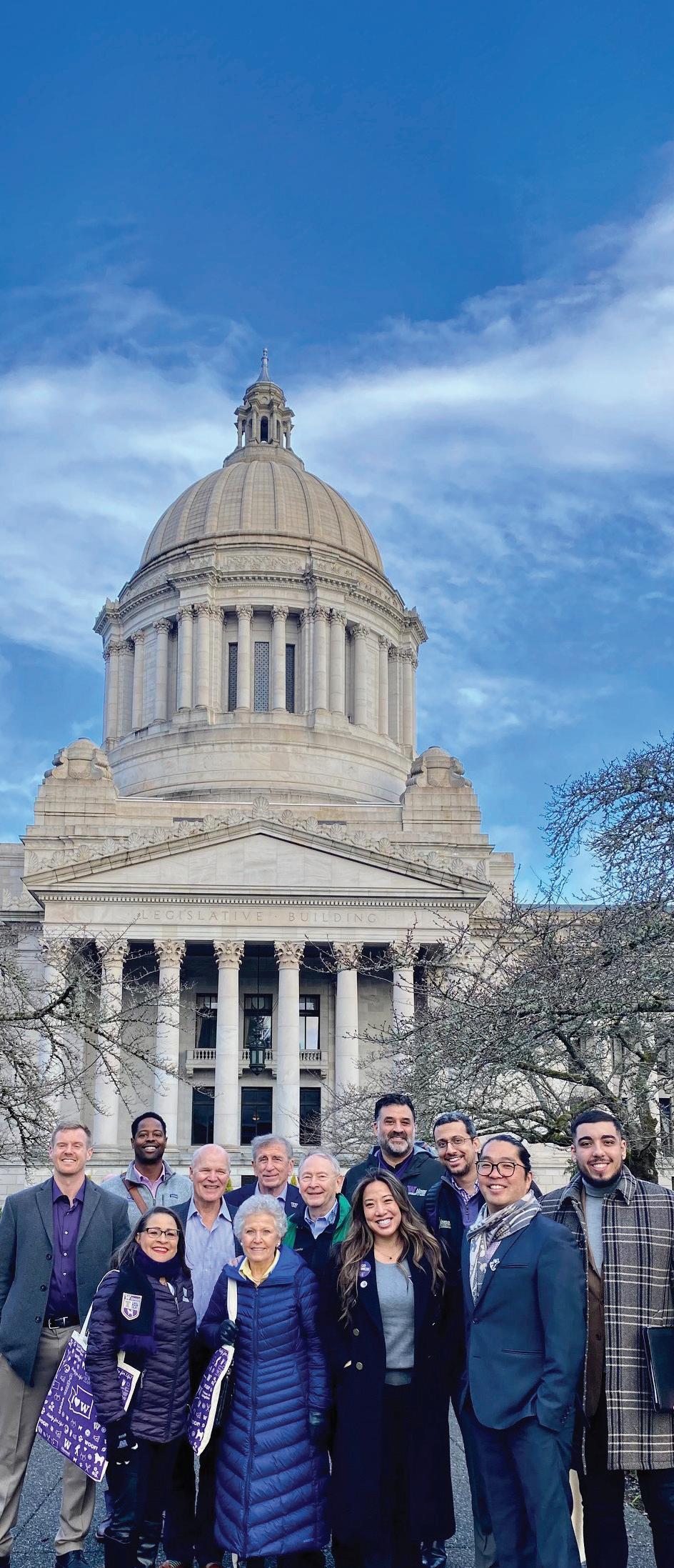
Ron Hoon, ’79, Mesa, Arizona, on Instagram
Joyce Gibbs was misidentified in our story about the Desert Scholarship Patron Committee in the Summer 2023 issue. The gallery in the School of Art + Art History + Design is the Jacob Lawrence Gallery. The museum is no longer referred to as The Jake.
ADVOCATE A program of the UW Alumni Association Become an advocate today HIGHER ED NEEDS YOUR VOICE UWIMPACT.ORG 10 UW MAGAZINE
JOIN THE CONVERSATION EMAIL YOUR COMMENTS TO: magazine@uw.edu (Letters may be edited for length or clarity.)
ROAR FROM THE CROWD
A FUTURE WHERE YOUR PAYCHECK DOESN’T IMPACT YOUR PREGNANCY.
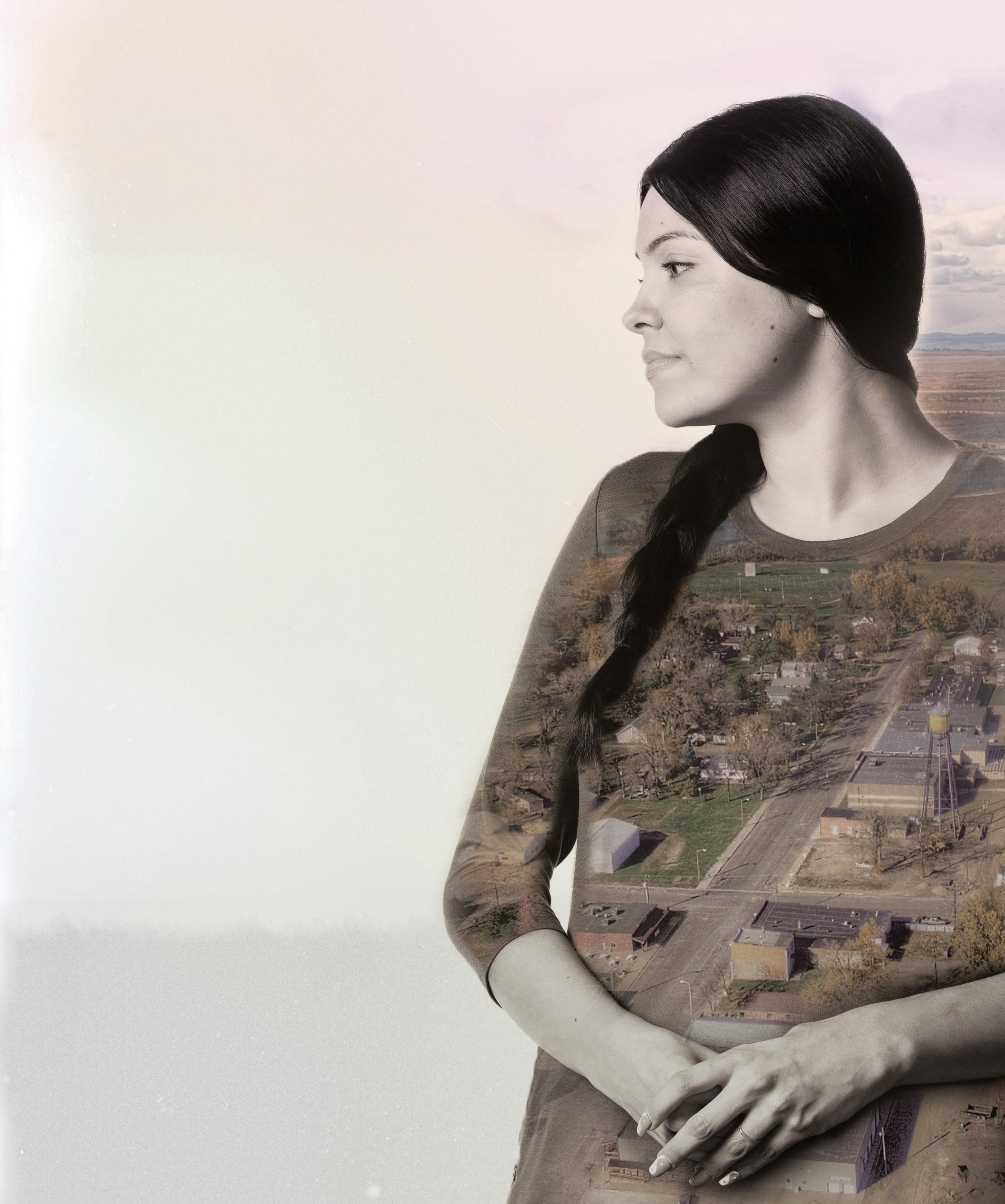
People who can’t afford or access prenatal care are more likely to suffer pregnancy-related complications.
Healthier communities make healthier people. The University of Washington is leading the way in addressing the interconnected factors that influence how long and how well we live, from poverty and health care to systemic inequities and climate change. In partnership with community organizations, the UW transforms research into concrete actions that improve and save lives across the country — and around the world.
LEARN MORE
uw.edu/populationhealth
Smart Students, Clever Tech
Smartphones and fitness trackers record student behaviors to predict grades
By Hannelore Sudermann
Smartphones are amazing. Besides functioning as telephones, cameras and interactive maps, they can track a person’s exercise, monitor their sleep and discover their habits.
And as a new batch of students steps foot on campus this fall, the device will collect information that can be used to predict their grades.
Over the past few years, hundreds of UW students passively provided data from their smartphones and Fitbit trackers so researchers could study both their health and behavioral outcomes. “We collect information about where the students are, how they are sleeping, what apps they use, where

they go and who they communicate with,” says computer scientist Anind Dey. “With only the data from Week One of the quarter, we can accurately predict what their GPA will be on the 12th week and, in particular, whether the GPA will be above or below the University average.”
Dey, the dean of the Information School and an adjunct professor in the Department of Human-Centered Design and Engineering, works with an interdisciplinary team of students and colleagues. They are exploring ways to identify at-risk students in hopes of helping them navigate the challenges of their first months on campus.
Information collected by the smart
devices can contribute to an understanding of an individual’s mental well-being, substance use and even experiences of discrimination, Dey says. Starting with known scientific findings (for example, how poor sleep affects grades and is linked to substance abuse and mental-health issues) and pairing them with device data, the researchers can compute thousands of statistics to see what patterns emerge.
In addition to collecting data, the researchers survey the students in the study “sometimes monthly, sometimes weekly, sometimes even hourly to understand their grades, their demographics, how they’re feeling, their sense of anxiety and whether they are using illegal or legal substances at that very moment,” Dey says. They use the sensor and survey data to build behavioral images that allow them to describe, detect and predict.
It’s uncanny—and maybe a bit unsettling—just how much information a smartphone can track, Dey says. The accelerometer, for example, collects information about how you’re holding the phone and how you’re moving through space. The smartphone also records data about how often you’re on your phone, and whether you’re being physically or socially active. “Most of that information is thrown away,” Dey says. But there is a tremendous, mostly untapped, opportunity for data collected from the devices around us to help us. Time spent on your phone at night is time spent not studying or sleeping, for example, and will likely result in a lower GPA, Dey says. “Even a fleeting interaction like unlocking your phone can be a window into who you are and what your future might hold.”
Through the data collected—like heart rate and sleep patterns—the devices can also measure stress, Dey says. By collecting and modeling the data now, the team may someday build predictive models to help understand what will happen to a student—whether in the next few minutes or the next few months. “These predictive models can be very powerful, but what excites me the most is that they allow you to avoid a negative outcome through targeted interventions or directly support a positive outcome.”
Dey cautions that using these tools to collect data and make inferences also raises challenges around the users’ privacy. “Despite the challenges that exist with this kind of technology, the opportunities to do good in the world are huge,” he says.
NEWS AND RESEARCH FROM
12 UW MAGAZINE APRIL HONG
With data from smart devices, researchers are exploring ways to identify and help at-risk students.
THE UW
Salish Scene
Imagine a jellyfish as wide as Dubs, with tentacles as long as the bell tower atop Gerberding Hall . The lion’s mane jellyfish, one of the world’s longest creatures, is part of the rich marine life within the Salish Sea, along with two iconic, interdependent endangered species: Southern resident orcas and Chinook Salmon. The Burke Museum exhibit “We Are Puget Sound” aims to inspire its preservation. It runs through Dec. 31. Photo by Drew Collins.

STATE
THE ART CREATURES
OF
OF THE SEA
Happiness is Just One Bus Away
Two graduate students seeking a better transit experience invented an app that puts cities within easy reach
By Genevieve Haas
The OneBusAway icon is at the top of my screen. I can find it the instant I unlock my phone. The app, which uses GPS data to tell transit riders when a bus or train will arrive at any given stop, is an indispensable tool for Seattleites like me who rely on public transportation to get virtually everywhere.
OneBusAway is the brainchild of Brian Ferris, ’06, ’11, and Kari Watkins, ’11, who were pursuing their doctorates at the UW in the mid-aughts, Ferris in computer science and Watkins in civil engineering. Unknown to each other and working in
meet a friend for dinner, I opened OneBusAway and began to strategize. The restaurant was easy to access by bus, and in the transit-dense U District, there were actually three routes that would get me there. The 372 stopped closest to my office, but OneBusAway informed me that I had just missed it, and the next one wouldn’t arrive for 15 minutes. By walking a few blocks west, I could catch the 45, which the app told me was just five minutes away. If I missed that, I’d still have nine minutes to hoof it a few more blocks to catch the 67. I stepped up my pace, ar-
invisible to riders. “I [was able] to improve the utility of the existing tracking data and combine that with a free service that hooked up a telephone number to a textto-speech engine,” Ferris says. “I hacked together all this stuff into a demo where I could call in and enter a bus stop ID [number] and … it would read to you when the bus was coming.”
In those pre-smartphone days, Ferris’ tool connecting ordinary riders to transit data was novel, and as his side project gathered momentum, he started sharing it with colleagues and other transit enthusiasts. Eventually, a friend in the UW’s civil engineering department connected him with Watkins.
As the mother of two young children who needed a way to get around Seattle that minimized bus transfers, Watkins was already interested in a transit-data project of her own. “I wanted there to be a tool where I could literally plug in some type of place I wanted to go, like a park, and get a list of places that were just one bus ride away,” she says. When she met Ferris and they began exploring how to create better access to transit information, Watkins’ coinage of “One Bus Away” took hold.
Ferris and Watkins brought distinct and complementary skills to the project. Ferris knew how to write code and implement it, and Watkins had a deep understanding of riders’ transit behavior and transit agency operations. Soon, they were working with all of the major Puget Sound area transit agencies, which recognized the potential for a tool that would make their services more usable to the public.
However, as doctoral students, Ferris and Watkins weren’t just building a useful consumer application, they were also earning Ph.Ds, and both are quick to credit Alan Borning, now professor emeritus in the Paul G. Allen School of Computer Science & Engineering, for his mentorship and support not only in realizing OneBusAway, but in guiding their work within an academic framework.
different departments, they nevertheless shared a love of public transit and a desire to make it more usable, accessible and predictable.
They soon found each other and, to the benefit of millions of riders, created OneBusAway. Launched in 2008 and currently operated by the nonprofit Open Transit Software Foundation, the app now serves more than 100,000 riders a day in the Puget Sound region, and millions more worldwide. Transit agencies from New York to Buenos Aires have adopted the opensource code to deploy local versions.
Recently, as I was leaving campus to
riving in time to catch the 45, which—to my delight—pulled up exactly when OneBusAway had predicted.
Such a calculation would have been impossible in 2004, when Ferris came to the UW as a graduate student. He planned to study robotics, but as a frequent publictransit user, he couldn’t help but turn his problem-solving nature to reducing the time he spent waiting for a bus with little to no idea of when it might actually arrive. And so, a side project was born.
Ferris gained access to the existing—if rudimentary—bus-tracking data that was collected by transit agencies but was
Borning served as co-adviser on Ferris’ doctoral thesis and serves on the Open Transit Software Foundation Board of Directors, along with Watkins. From an academic perspective, the project presented a research opportunity to explore how transit behavior could be changed, and to apply the theory of value-sensitive design to this innovative technology, leading to a few unexpected discoveries. “[We learned that people] would walk more … sometimes because OneBusAway showed them a bus that would get them home sooner a few blocks away … or if the bus was going to be a while, they
Before white settlement, the land where the
14 UW MAGAZINE
As a frequent public-transit user, Brian Ferris couldn’t help but turn his problem-solving nature to reducing the time he spent waiting for a bus.
might walk upstream to the next stop.”
Today, Ferris and Watkins continue to improve transportation and urban mobility. Ferris joined Google, where he works on transportation and urban-mobility technology, and Watkins is an associate professor in civil and environmental engineering at the University of California, Davis, specializing in transit planning and behavior. Both say that their time at the UW and the development of OneBusAway did a lot to shape their lives and careers.
“I’m a transit nerd at heart,” Ferris says. OneBusAway “has definitely been one of the most impactful things that I’ve worked on, and I think most people would be lucky
to have anything like that in their lifetime. It has opened up a lot of doors for me career-wise, and it’s why I’m still in the transportation space.”
Since creating OneBusAway, “crazy things have happened to me,” Watkins says. She once met a mother and her teenage son from Seattle while on a wine tour in France. “So we’re chatting, and I tell them I’m a professor and I work in transit. And that I went to the University of Washington. The kid says, ‘Oh, there’s a really great transit app that I use in Seattle, have you heard of it?’ So then it comes out, and this kid is like, ‘Wait, you’re Kari Watkins?!’”
Within the small world of public-transit nerdery, Ferris and Watkins’ achievement as graduate students does confer a certain amount of cachet. But for millions more people who may never know their names, their influence is felt every time someone opens an app that tells them how long until the next bus or train takes them where they want to go.

FROM WASHINGTON TECH AND TRANSPORT
JOE ANDERSON
Seeing the World from a Remote Location
A UW Bothell global public health class visits villages in Guatemala
By Hannelore Sudermann
Student Leylani Blanco demonstrates how to take blood pressure measurements to health promoters and lay midwives. She was among 10 undergraduates and six master of nursing students who provided primary care and public health promotion in Guatemala this summer..

Outfitted with boxes of medical supplies and purple T-shirts, students from UW Bothell traveled through Guatemala this summer, popping up clinics in rural Mayan villages and providing medical care and education to nearly 400 Indigenous people. Spending a few weeks in the villages, this contingent from a global public health class gained a precious understanding of rural health care in the developing world.
Students trekked to mountain and coastal villages, places where months could pass between visits from medical professionals. Arriving in trucks and SUVs to find residents lined up and waiting, they toted tubs of supplies into schoolrooms where they
performed screenings and assessments and provided health education.
Guatemala has one of the world’s highest rates of child malnutrition, according to the United Nations Children’s Fund. Part of the UW group’s work centered on malnutrition assessments for babies and toddlers, providing nutritional supplements and health information to families.
“Clinic day is a bustling and dynamic environment, where patients receive personalized attention and care across a range of medical services,” says Leylani Blanco, a postpartum nurse who is completing her bachelor’s degree at UWB. While working with patients, Blanco gained insight into the health-care system of a different country
and how the conditions where people are born, live, work and play affect their well-being.
Mabel Ezeonwu, ’03, ’08, a nurse practitioner and professor of nursing at UW Bothell, developed the class and led the trip. “This intensive hands-on service-learning course is designed to expose students to the policy contexts in which health care is delivered in remote resource-limited environments,” she says. With the community as the classroom, the students are challenged “to view global health-care issues holistically in order to understand how in-country health policies are influenced by local and global determinants.”
At each site, the students are assigned to a team that includes a doctor, nurse practitioner and other nurses. Each station is well-prepared to educate patients about their health conditions, perform medical assessments and administer treatments. The collaboration between different health-care professionals allows for a comprehensive approach to patient care.
The class works with Guatemala Village Health, a Seattle-based nonprofit cofounded by Dr. Jennifer Hoock, who completed her master’s in public health at the UW in 2008. The outreach organization has a mission to improve health in rural villages by providing access to medical care and health education, training health-care workers and implementing public health improvement projects. It brings teams of medical professionals from the U.S. to work with their local nursing team and train local health workers.
Community-based caregivers in southeastern and central Guatemala have long sought resources to train more health workers and midwives, but their local and regional governments haven’t come through. Through Guatemala Village Health, Hoock helped create a training program as well as the volunteer outreach health clinic that the UW students staffed.
“It is really a wonderful match,” says Ezeonwu of working with GVH. “The nonprofit gets engaged and experienced volunteers and the UW team gets community-centered experience and a chance to learn in another part of the world.”
“ This class and trip have been an incredibly meaningful and beautiful experience for me,” says Blanco . “ Collaborating with fellow nurses and individuals from various fields and backgrounds, each with unique values and interests has been eye-opening. Despite our differences, we came together as a team and forged genuine friendships.”
16 UW MAGAZINE
UW BOTHELL
REAL DAWGS WEAR PURPLE

JANE WONG, ’16 POET AND MEMOIRIST



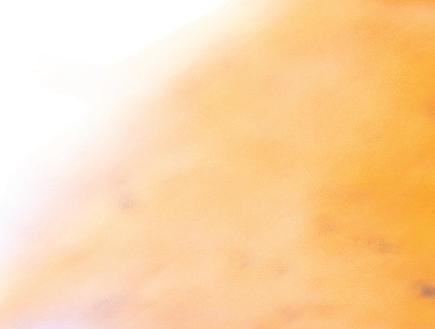


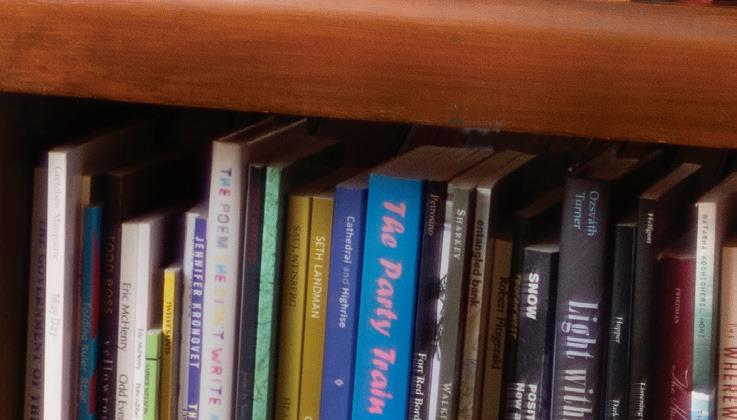



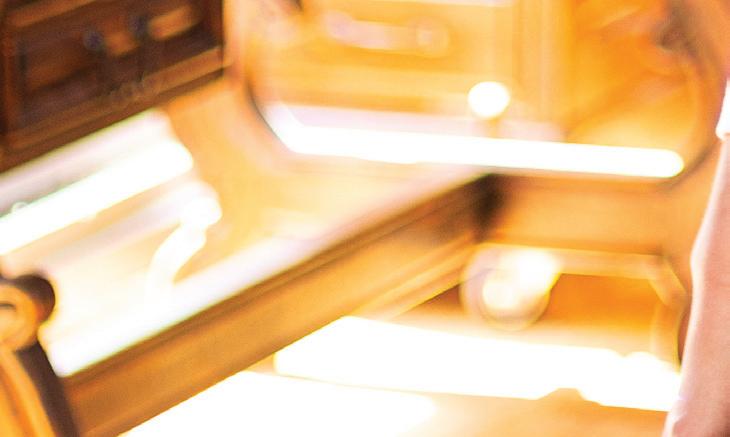
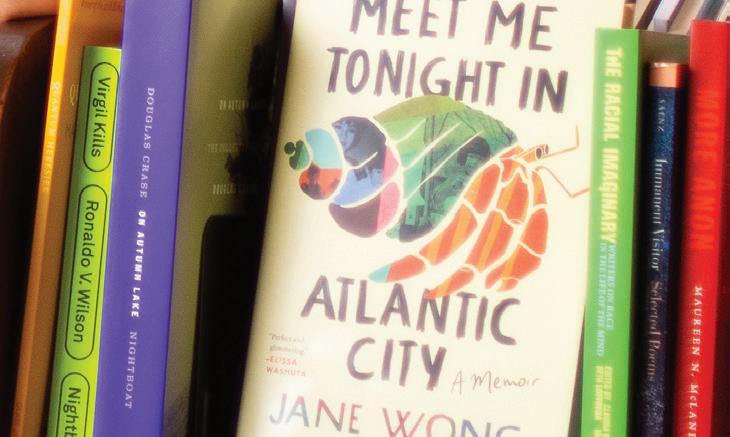



As a child, Jane Wong wrote alternate versions of her library books — an early sign of the writing career to come. In college, Wong was drawn to the freedom in poetry and pursued a Ph.D. in the subject at the UW. The proud Husky penned her debut poem collection, “Overpour,” while writing her dissertation on Asian American poets.

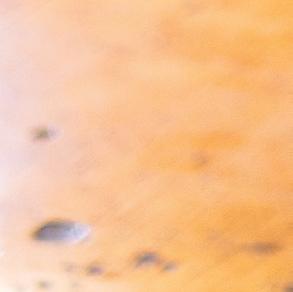

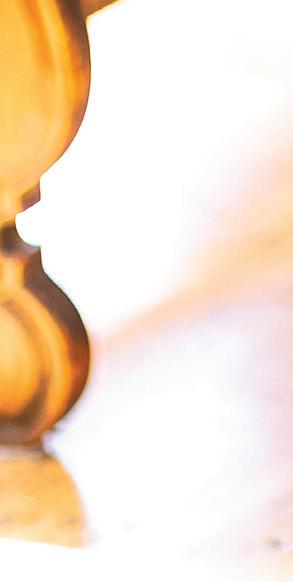

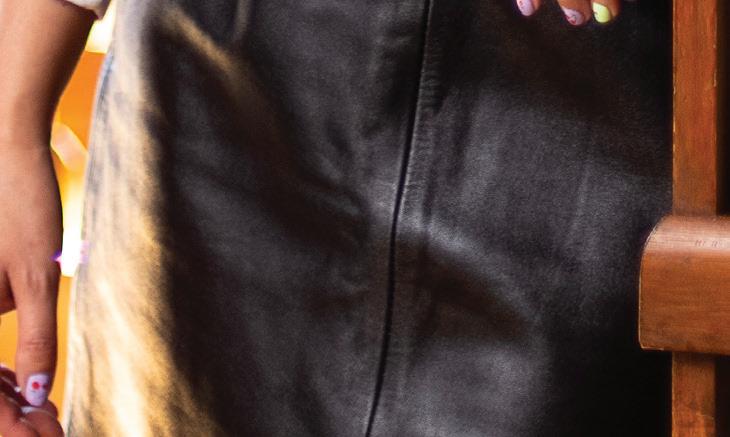


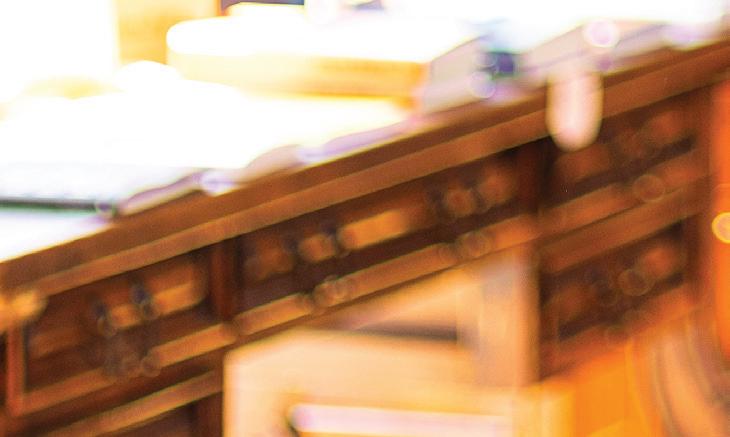
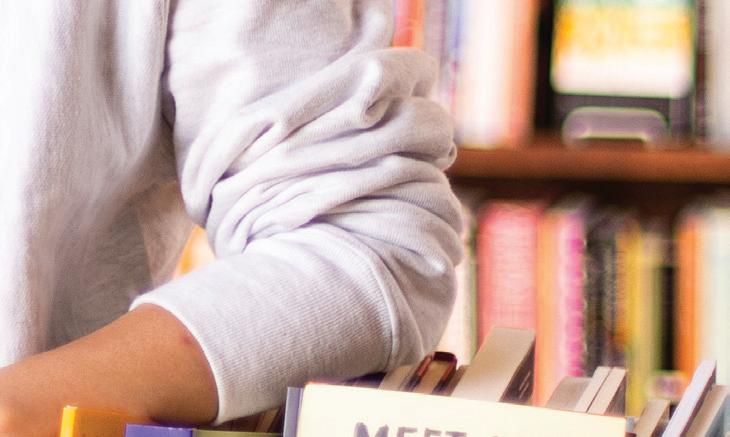

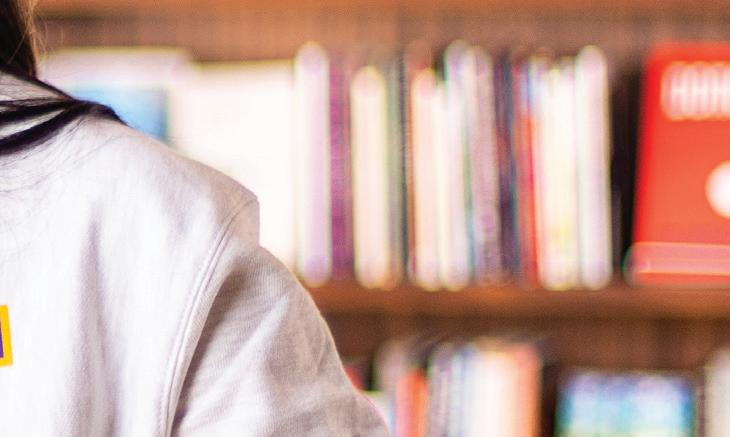

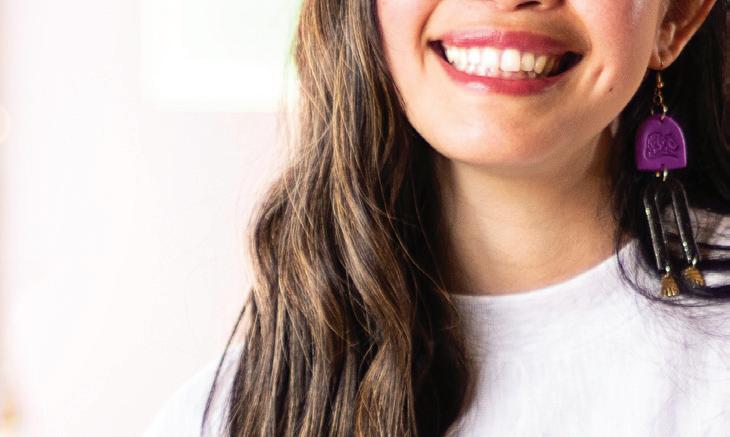

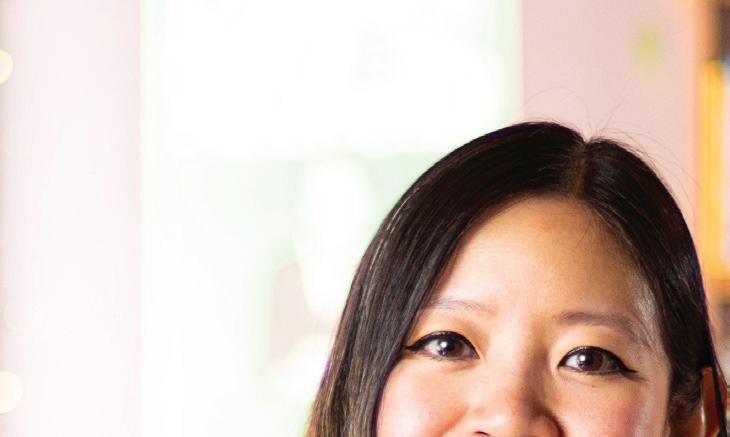
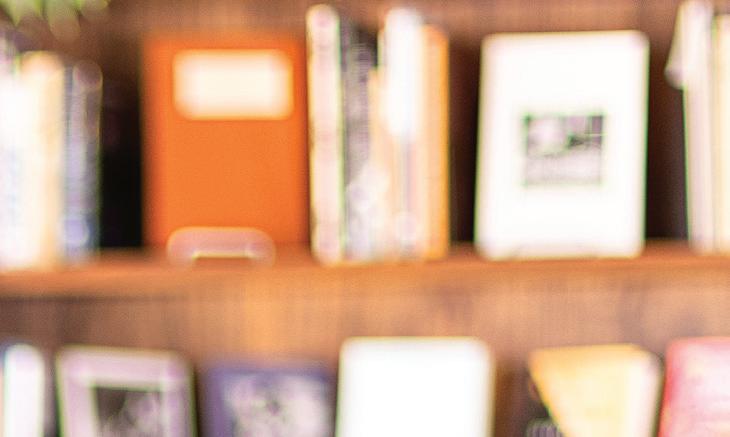

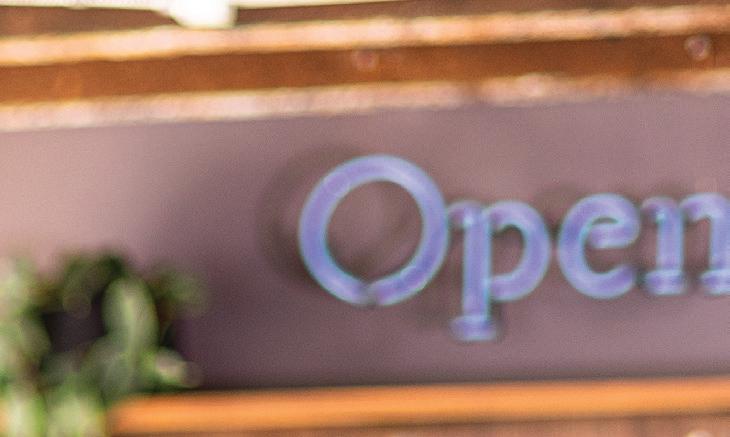

Wong’s award-winning poems weave through time and space, exploring themes of migration, ancestors, resistance and food. Food is also central to “Meet Me Tonight in Atlantic City,” Wong’s recent memoir of growing up on the Jersey Shore in her family’s Chinese restaurant, and the aftermath of its loss. Now a creative writing professor as well, Wong credits her time at the UW for fueling her passion for teaching.
 Jane Wong browses the shelves at Open Books: A Poem Emporium, a poetry bookstore in Seattle’s Pioneer Square neighborhood.
Jane Wong browses the shelves at Open Books: A Poem Emporium, a poetry bookstore in Seattle’s Pioneer Square neighborhood.
realdawgswearpurple wearpurple real_dawgs
Bioplastics to the Rescue
UW-created materials can degrade in a backyard compost bin
By Jon Marmor
We smile when we remember the great line from the movie “The Graduate,” when Dustin Hoffman’s character is told that the best bet for the future was one word: “plastics.” Well, plastics have completely revolutionized our lives, being durable, inexpensive to make and incredibly stable. But we’ve also become all too aware that disposing of them isn’t easy. They persist in the environment for years. Over time, when they finally do begin to break down, the result isn’t good, either: smaller fragments called microplastics, which can pose significant environmental and health challenges. But leave it to a team of UW researchers to develop new bioplastics that degrade on the same timeline as a banana peel in a backyard compost bin. These innovative materials are created entirely from powdered blue-green cyanobacteria cells,
known as spirulina. The UW team’s bioplastics have mechanical properties that compare to single-use plastics derived from petroleum.
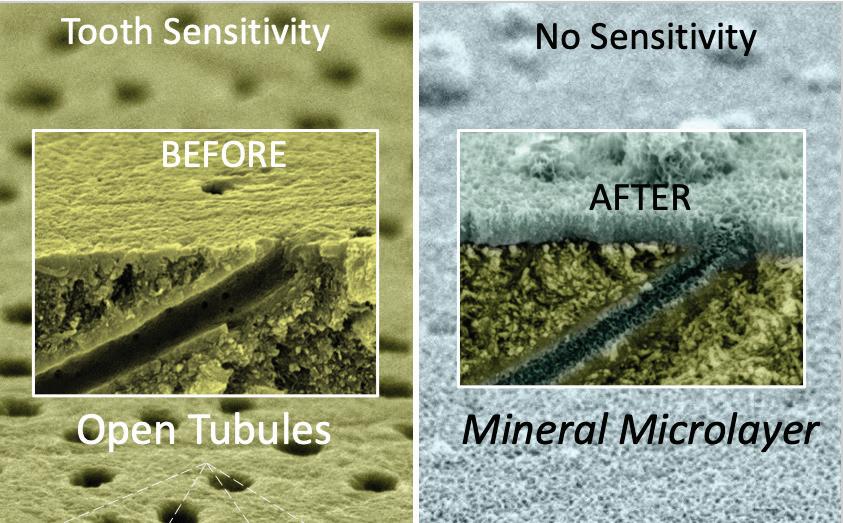
“We were motivated to create bioplastics that are both bio-derived and biodegradable in our backyards, while also being processable, scalable and recyclable,” says Eleftheria Roumeli, assistant professor of materials science and engineering. “The bioplastics we have developed, using only spirulina, not only have a degradation profile similar to organic waste, but also are on average 10 times stronger and stiffer than previously reported spirulina bioplastics. These properties open up new possibilities for the practical application of spirulina-based plastics in various industries, including disposable food packaging or household plastics, such as bottles or trays.”
COLD COMFORT
Tooth sensitivity to hot, cold or acidic food is no fun. And until now, dentists couldn’t do anything about it. The UW has come up with a dental lozenge that builds new mineral microlayers that penetrate deep into the tooth to create effective, long-lasting natural protection. The next time you bite into an ice cream cone and don’t wince, be sure to thank Sami Dogan, UW professor of restorative dentistry, and the team of UW materials engineers who devised the solution.
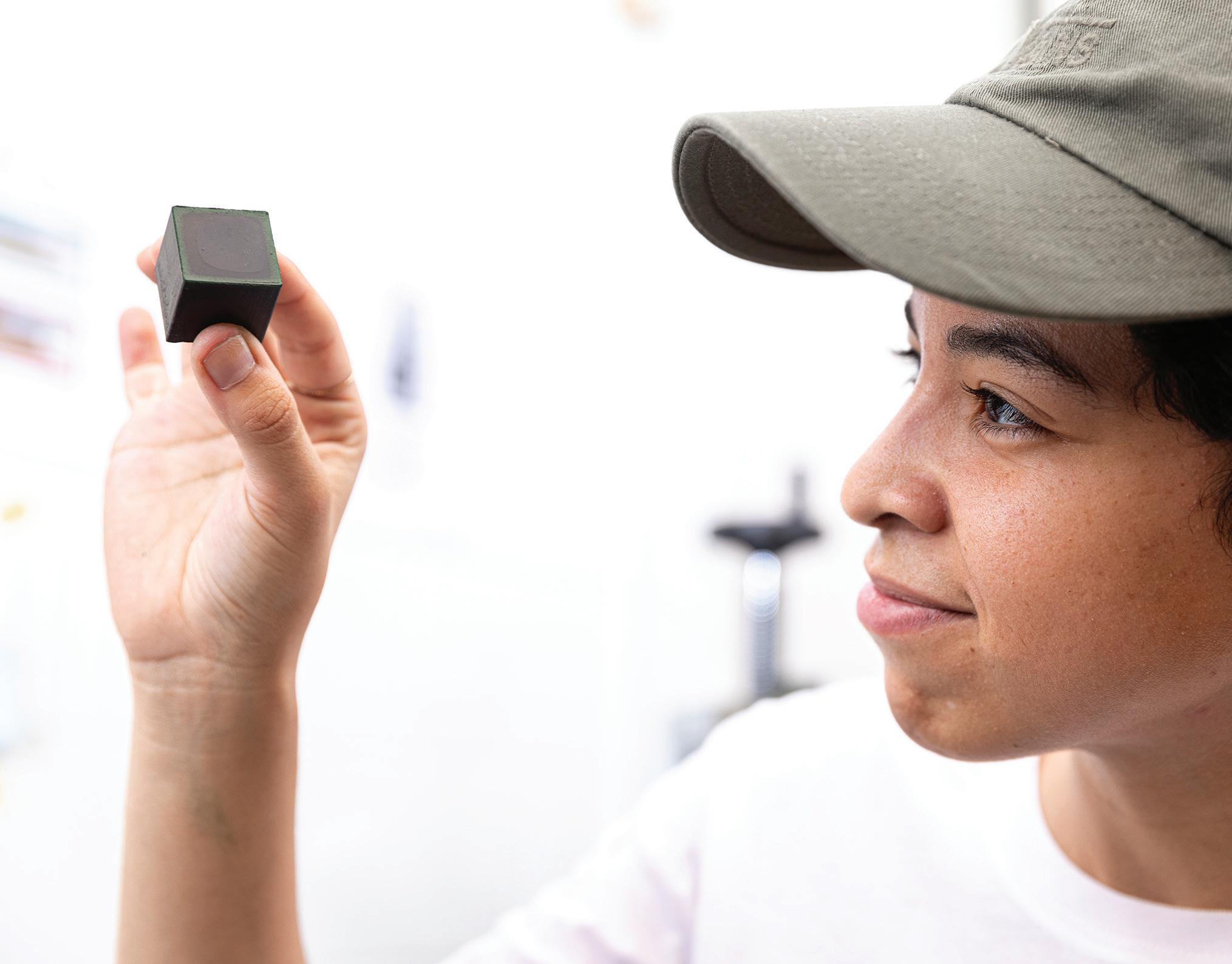
FEVER FIND
If you’ve ever wondered whether you were running a temperature but couldn’t find a thermometer, you aren’t alone. A fever is the most common symptom of COVID-19 and an early sign of many other viral infections. And a temperature check can be crucial for a quick diagnosis and to prevent viral spread. Enter a team of UW researchers, who created an app called FeverPhone, which transforms smartphones into thermometers.
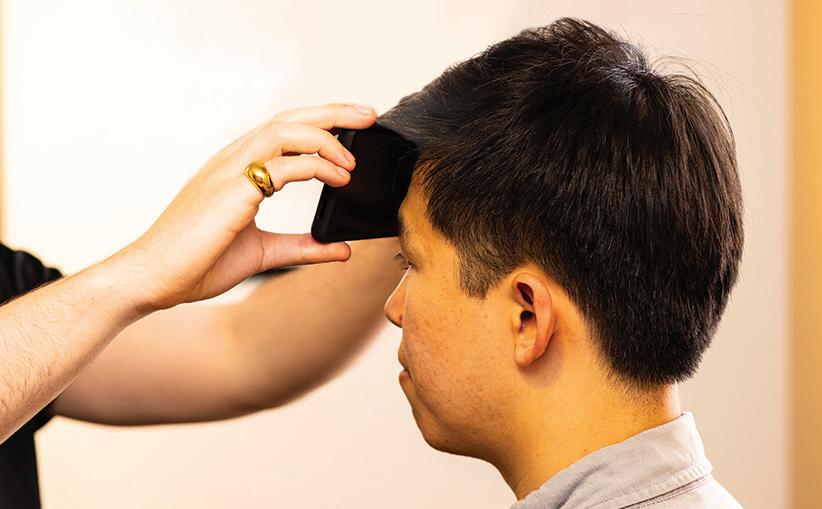
HOT AND HAZARDOUS
Warmer oceans might be pleasant to swim in, but they are wreaking havoc on the lives of seabirds. Using data collected by coastal residents along beaches from Central California to Alaska, new UW research has confirmed that persistent marine heat waves lead to massive seabird die-offs months later. “This type of massive die-off can be compared to a catastrophic storm,” says lead author Timothy Jones, a UW research scientist in aquatic and fishery sciences.
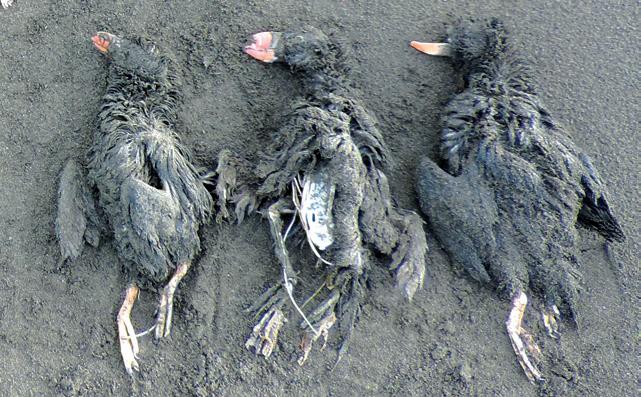
RESEARCH COURTESY MEHMET SARIKAYA, UW SCHOOL OF DENTISTRY DENNIS WISE 18 UW MAGAZINE
Mallory Parker, a UW materials science and engineering doctoral student, holds a bioplastic cube made from spirulina.
MARK STONE ALEUT COMMUNITY OF ST. PAUL ISLAND
ECOSYSTEM CONSERVATION OFFICE
Meet the Nation’s New Top Infectious Disease Specialist
Dr. Jeanne Marrazzo succeeds Anthony Fauci
By Jon Marmor
Her mom was a nurse and her role model. That’s why Jeanne Marrazzo decided to go into medicine. After medical school in Philadelphia, she came to the University of Washington, where she earned a master’s degree in public health, and had a residency and a fellowship. After a successful career in academic medicine—including two decades on the UW faculty—she has become the director of the National Institute of Allergy and Infectious Diseases, succeeding Anthony Fauci, who retired after nearly five decades in December.

Marrazzo frequently appeared on television as an expert during the height of the COVID pandemic. She also made an impact during her time as a professor on the UW faculty from 1996 to 2015.

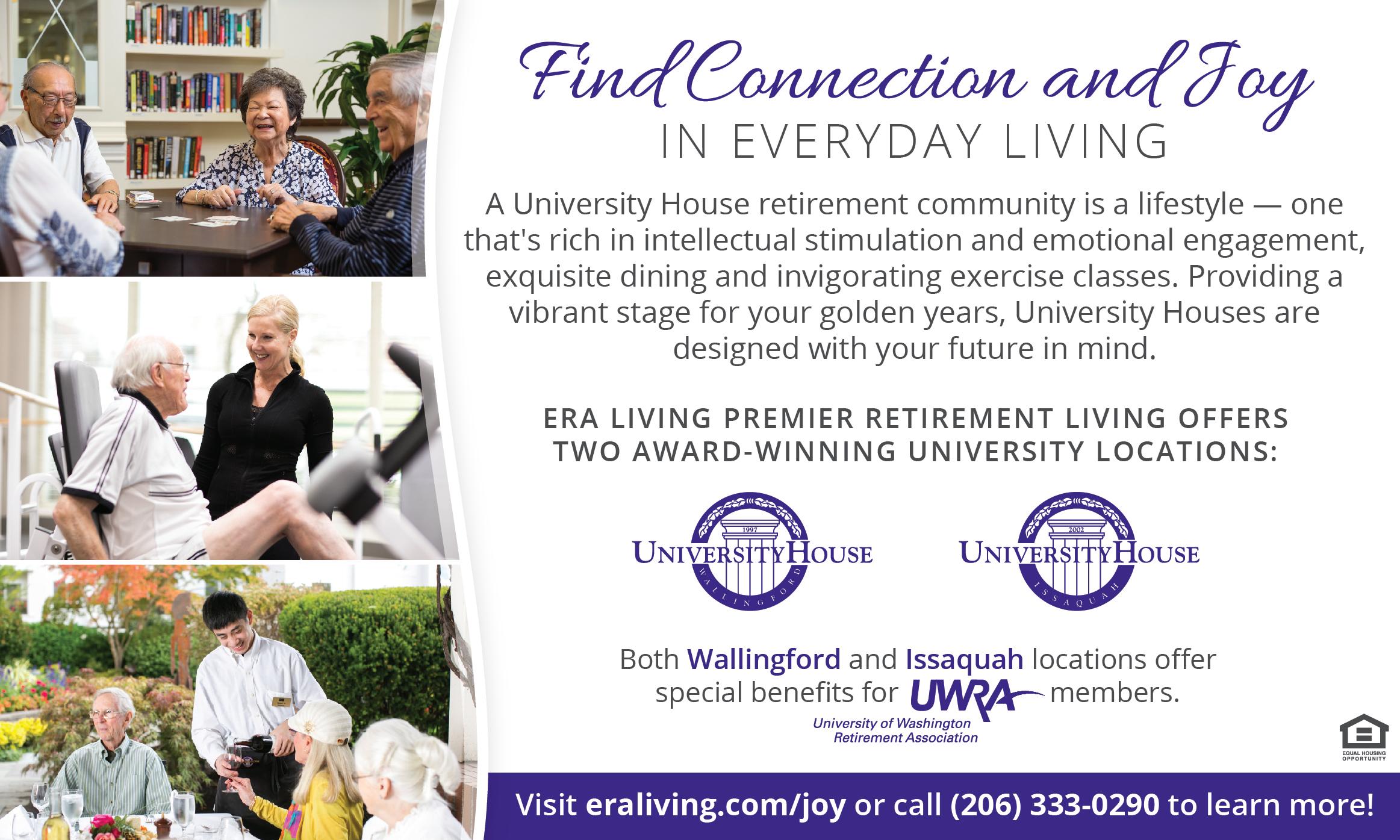
“She finds these ways to encourage and push and foster growth and development in people,” Jennifer Balkus, an epidemiologist with Public Health—Seattle & King County, told NPR recently. A former colleague from the University of Pittsburgh described Marrazzo as “an exquisite clinician and an exquisite teacher.”
Marrazzo will head an agency with a $6.3 billion budget that supports research to advance the understanding, diagnosis and treatment of infectious, immunologic and allergic diseases. Marrazzo is an expert in HIV and sexually transmitted diseases and is known for building relationships between basic and clinical scientists to find new methods for preventing and managing common diseases.
FALL 2023 19
UAB / LEXI COON
The Magic of Museums
Treasures and community await, says the Henry’s recently retired director
By Hannelore Sudermann
If there’s anything to know about art museums, says Sylvia Wolf, it’s that they’re good for us. They improve our sense of well-being, stimulate and inspire us, and strengthen our communities. The research backs it up, adds Wolf, who recently retired after 15 years as director of the Henry Art Gallery, Washington’s original art museum.
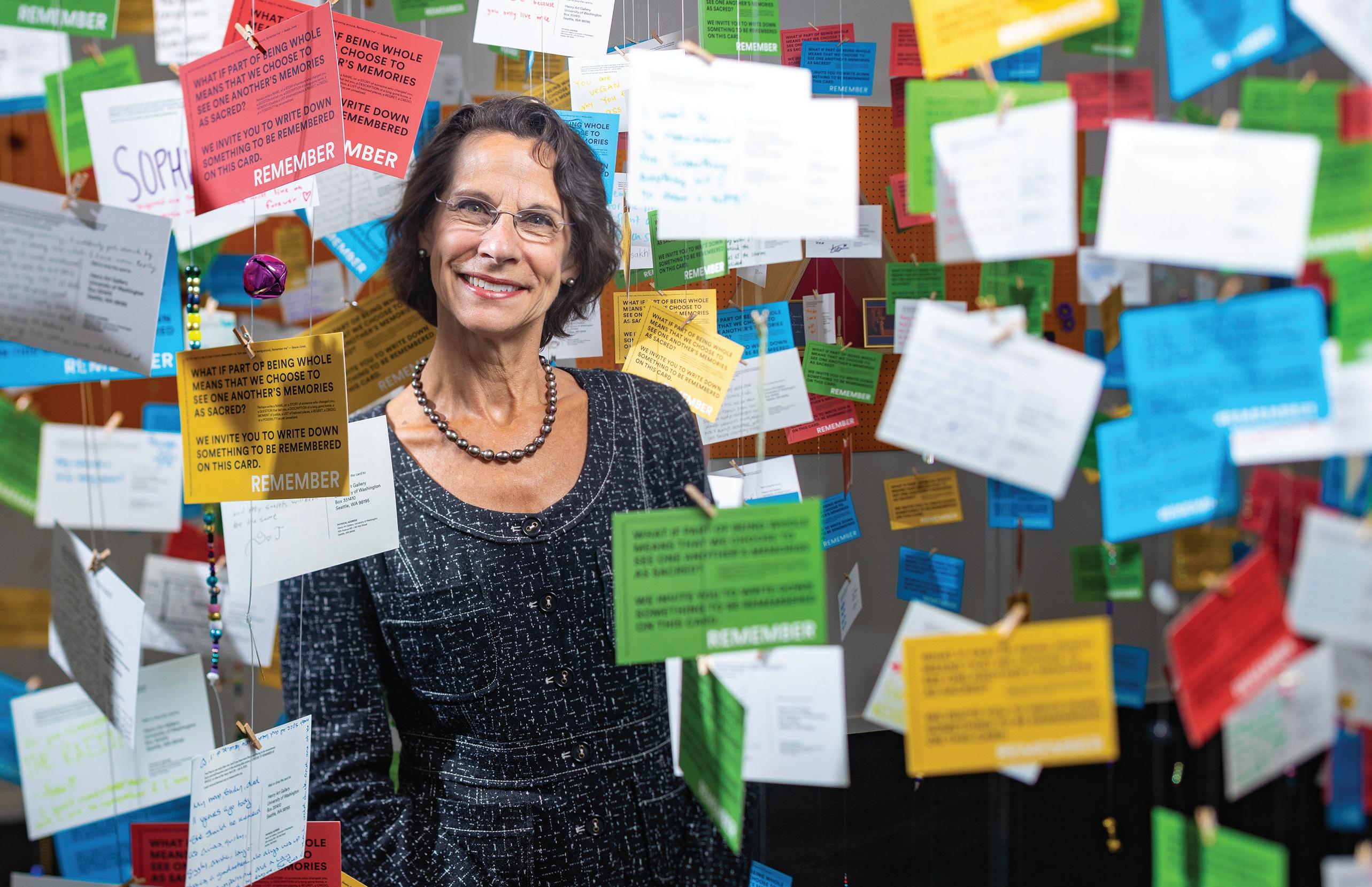
This summer, as Wolf packed up her office, the Henry was buzzing. On the floor above, MFA students were putting finishing touches on their thesis exhibitions. A story below, curation in action was on view in the largest exhibit space.
During her time as director of the UW’s fine arts museum, she oversaw more than 160 exhibits and an evolution of the Henry’s
nearly century-old mission of highlighting contemporary art. She shepherded the care and curation of the collection of more than 28,000 objects. Wolf took some time in her final hours on the job to offer thoughts about how crucial museums are for healthy, vibrant communities and how they’re easier to access than we might think.
Whether they are focused on history, art or artifact, museums do a wonderful job of connecting visitors to the humanities. Nonetheless, they are too often taken for granted and lose out in an ever-increasing whirl of distractions, Wolf says.
According to the American Association of Museums, more people visit museums, science centers, historic sites or aquariums than attend professional sporting events.
Yet art museum visits have declined over the past two decades. A recent survey by the National Endowment of the Arts found that only about 25% of adults visit a single museum in a year. That, Wolf says, is not nearly enough.
And now with so many demands for our attention, we are even less likely to devote an afternoon to wandering through a gallery, she says. Her advice is simple: You don’t need to dedicate a day—or even a couple of hours. You just need to step inside.
At the Henry, visitors can always find something new—whether it’s a single painting or a multi-room sculptural display. This fall, the exhibits include landscape photography of the American West, a trio of videos exploring the writing and rewriting of history, and sculptures focused on texture and touch. That’s in addition to talks, happenings and lectures that are built around the exhibits.
It is so easy to just swing through for 10 or 15 minutes, Wolf says. “Things here are changing all the time. Come often and come with an open mind. You can always expect the unexpected at the Henry.”
20 UW MAGAZINE
�he Henry Art Gallery, a division of the College of Arts & Sciences, features contemporary art and ideas, says Wolf, who stepped down this summer.
MATT HAGEN
UW Converge Returns to Asia






 By Isaiah Brookshire
By Isaiah Brookshire
On a tropical morning in early August, more than 200 people gathered for the UW Converge summit in Jakarta, Indonesia. The audience was composed of UW alumni, Husky supporters and members of the public who were eager to gain expert knowledge and connect with one another.

The annual UW Converge event series has long been the place where the UW’s international alumni and friends gather to learn, network across borders and celebrate Husky Spirit. Since the inaugural Shanghai event in 2015, it has traveled across Asia.
In 2020, the COVID-19 pandemic put a pause on those travels. After two virtual years and a homecoming event in Seattle, it finally returned to Asia for UW Converge Jakarta 2023.

The summit kicked o with a keynote from UW President Ana Mari Cauce, delivered from Seattle. She welcomed the audience and spoke about the positive
impacts the UW is creating through the University’s deep global connections. “Examples are everywhere across the world and throughout Asia,” she said. Among the projects highlighted by Cauce were the UW’s Global Innovation Exchange (GIX), which works closely with industry to push the boundaries of innovation, and the Ocean Nexus Center, which seeks to transform ocean governance for the benefit of everyone. She added that “universities like the University of Washington are especially well-suited to these endeavors, because innovation and discovery go hand in hand with exploring the ethical and human impact of our scientific advances.”
These advances and impacts were central to the theme of this year’s summit. It examined groundbreaking innovations in the world of finance, business and technology, but also looked closely at the impact these breakthroughs have on people. Sessions explored topics ranging from how to navigate investment in an uncertain world and the potential for upheaval posed by artificial intelligence to building personal resilience during times of rapid change.
The sessions o ered guests at the summit the chance to hear from leading experts at the UW and from the Husky alumni community. Campus leaders included Denzil Suite, vice president for student life; Ali Mokdad, chief strategy o cer for population health; and Frank Hodge, dean of the Foster
School of Business. There was a large contingent of alumni speakers such as Jerry Ng, ’86, the founder and chairman of Bank Jago, an institution leading a banking revolution in Indonesia, and Alvin Graylin, ’93, the president of HTC China. A number of dignitaries also spoke, including several ministers from the Indonesian government and the US ambassador to Indonesia, Sung Kim.
tingent of alumni speakers such as Jerry Jago, an institution leading a banking rev’93, the president of HTC China. A number and the US ambassador to Indonesia, Sung Kim.

For many, the summit was the highlight of this year’s gathering, but it wasn’t all immersive learning. Celebration and connection are also at the heart of the UW Converge experience. A tour of Jakarta o ered an opportunity to explore the rich culture and history of Indonesia. A gala following the summit added plenty of fun and spectacle to the day. Guests were treated to Indonesian hospitality at its best, enjoying fine dining and traditional performances of dance and music. After Jakarta, an optional extension to Bali o ered more opportunities to explore and a program that examined the future of philanthropy at the UW.
o ered an opportunity to explore the rich
The conclusion of another exciting UW Converge event was a reminder of the strength of the University’s global community of Huskies. With nine established alumni chapters and more than 25,000 alumni and friends around the world, there are Huskies in every corner of the globe making a positive impact.
UW Converge Jakarta was a perfect example of that impact. The event would not have been possible without the dedicated efforts of the Indonesia alumni chapter under the leadership of chapter president Aldrin Tando, ‘91. Their outstanding work brought together an amazing group of speakers for an event that sets a high bar for future hosts.
While the next UW Converge location has not been announced, its legacy of providing unrivaled access and connection to all Huskies who identify as part of the UW’s international community will continue.
To stay informed about future UW Converge events, visit our website and sign up for email updates.

uwalum.com/converge

FALL 2023 21
The premier gathering of the UW’s global community stepped back onto the world stage in Indonesia
Left, summit attendees in Jakarta gather for a group photo. Above, enjoying lunch during the Bali extension.
GIGI DO
Content provided by UW International Advancement
WIRA PHOTOGRAPHY
Sand Storm
Coach Derek Olson has built a fast-rising beach volleyball program in a short time
IN JUST TWO SEASONS, head coach Derek Olson has taken the Husky beach volleyball program to new heights. In 2023, the Huskies were ranked No. 12 in the nation, they had their first 20-win season, and seniors Chloe Loreen and Natalie Robinson became the first Huskies ever named AVCA Beach Volleyball Americans. The former beach volleyball touring pro has set his sights even higher. Interview by Jon Marmor
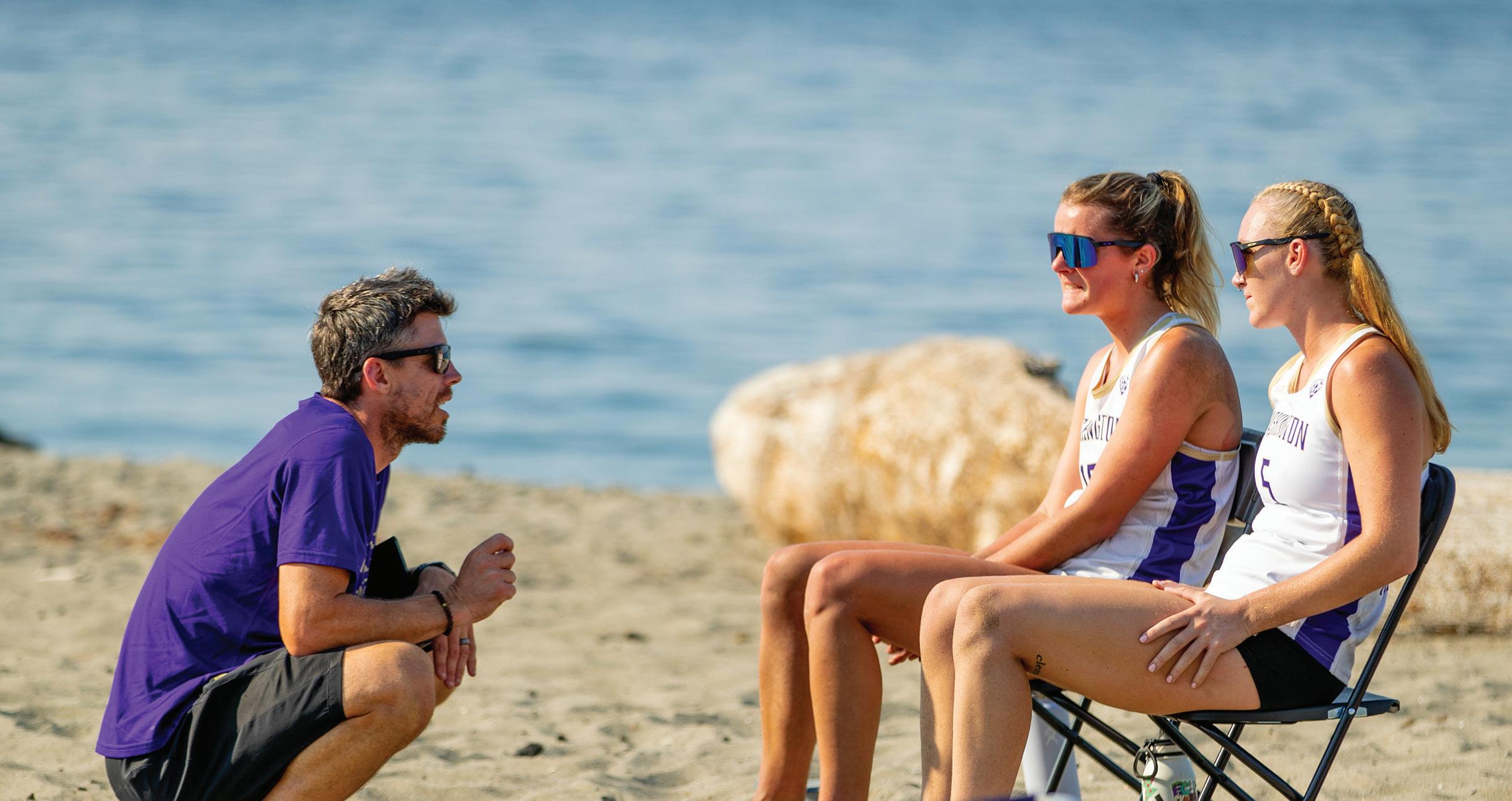
How did you get interested in volleyball?
I grew up in Eugene with a dad who played and coached volleyball. I was that annoying kid who interrupted his practices.
How did you get involved with beach volleyball?
What’s it like being the coach at UW?
Very few schools know how to balance academics and athletics to give student-athletes the best possible experience. Washington really supports its student-athletes. And the sport itself is exploding. One of the challenges in recruiting and playing, of course, is the weather. It will take patience and consistency to make beach volleyball more prominent at the UW, it won’t happen overnight. And it will take a lot of hard work. We need to create a strong culture for support.
Where does the team play its matches?
After guiding the Huskies to their first 20-win season last year, Coach Derek Olson doesn’t want the UW to take a back seat to anyone.
I started playing at 19 on an indoor club team in Oregon. But I knew that as soon as I graduated, I was heading south to San Diego for the lifestyle, the sunshine and the challenges of having to be an all-around athlete in a physically demanding sport.
What was it like playing professionally?
Surreal. Really stressful, really rewarding, but I got to visit a lot of places around the world.
How did you become a coach?
I started coaching high school athletes and found myself focusing more on developing them than my own game. That’s when it dawned on me that coaching was becoming my passion.
You coached at Cal and you coached the Moroccan National �eam. �ell us about it.
Morocco was quite the experience—a five-week stint leading up to the most important tournament of the year. It was the team’s shot to qualify for the Olympics.
Alki Beach. And we practice at Golden Gardens and sometimes on two courts on campus. There is a home-court advantage in beach volleyball, mainly depending on the different sand depths and the wind. Arizona State has deep sand. At Alki, the sand is shallow, and the weather is all over the place. But we draw big crowds if it isn’t raining or hailing.
Indoor volleyball,
beach volleyball. What’s the difference?
On the beach, players need all of the skills. Indoors, players have very specific skills for their roles. Middle blockers, for instance, might have a real challenge switching to beach ball. And it can take a while for a pair in beach ball to work great together.
What’s the outlook for next season?
We have 11 new student-athletes. We do return a couple of starters, but we have many new freshmen. In the first two years, we recruited a lot of transfer students but now we were able to bring in freshmen so we can really build the program. The Pac-12 is stronger than ever and is the toughest conference in the country. (Note: �his interview took place before it was announced that the Huskies would be joining the Big �en in 2024.)
ATHLETICS COMMUNICATIONS (2) 22 UW MAGAZINE
A New Day Dawns
UW’s move to the Big Ten brings stability and more national exposure
By Jon Marmor
It was bright and sunny the first Friday of August. Maybe it was a sign from above that the University of Washington’s monumental decision that day—leaving the Pac-12 Conference to join the Big Ten beginning in 2024—meant blue skies were ahead for the Huskies.


The decision made headlines for days. After all, the Huskies (who were joined in moving to the Big Ten by the University of Oregon) had been a founding member of what became the Pac-12 more than 108 years ago. But as the college sports landscape has evolved dramatically over the past couple of years, it became clear the Pac-12 fundamentally had changed to the point where it could not meet the UW’s needs.
“The Big Ten is a thriving conference with strong athletic and academic tradi-
tions and we are excited and confident about competing at the highest level on a national stage,” said UW President Ana Mari Cauce. “My top priority must be to do what is best for our student-athletes and our University, and this move will help ensure a strong future for our athletics program.”
The move by the UW and Oregon to the now 18-member Big Ten conference means there will be four former Pac-12 institutions in the Midwest-based league. Last year, USC and UCLA were the first Pac-12 schools to announce that they were making the move. The UW decided to join the Big Ten because that conference offers a more robust and stable media rights deal as well as the opportunity to compete on a national stage.
“We are proud of our rich history with the Pac-12 and for more than a year, have worked hard to find a viable path that
would keep it together,” Cauce explained. “I have tremendous admiration and respect for my Pac-12 colleagues. Ultimately, however, the opportunities and stability offered by the Big Ten are unmatched. Even with this move, we remain committed to the Apple Cup and competing with WSU across all of our sports.”
As of this writing, the Pac-12’s future is uncertain. In addition to Washington and Oregon leaving to join USC and UCLA in the Big Ten, four other Pac-12 schools (Arizona, Arizona State, Colorado and Utah) opted to join the Big-12 Conference.
The UW was one of four founding members of what started in December 1915 as the Pacific Coast Conference, which over the years grew to become the Pac-12. Joining the Big Ten means the UW will be a member of the Big Ten’s Academic Alliance. “Our dean of the College of Arts & Sciences (Diana Harris), who participated in it in one of her previous jobs, told me what a great network that is,” Cauce explained.
Added head football coach Kalen DeBoer: “The clarity associated with a stable home [in the Big Ten] really helps. I know that our guys are excited about the future.”
FALL 2023 23 UW+YOU GEAR UP FOR FALL WITH UNIVERSITY BOOK STOR E ubookstoreseattle ubookstoresea ubookstore.com
�ight end Jack Westover hurdles a defender in the Huskies’ 27-20 Alamo Bowl victory over �exas in a matchup of two high-profile programs.

24 UW MAGAZINE
HE CAN DIG IT
The Rock-Obsessed Rocker

With a MacArthur “genius grant,” a handful of popular science books, and six albums with the local band Big Dirt under his belt, geology professor David R. Montgomery brings balance to his life, and big ideas to the masses
BY RACHEL GALLAHER PHOTO BY ANIL KAPAHI
There’s a popular saying, repeated over dinner tables and latenight snack sessions, that humans are what they eat. Often uttered in jest, the ubiquitous idiom evolved from a line in the 1826 book by French lawyer, politician and noted epicure Anthelme BrillatSavarin that stated: “Tell me what you eat, and I will tell you what you are.” If perhaps a bit reductive, it’s not altogether wrong. But when I pose the idea to award-winning author and University of Washington geomorphology professor David Montgomery, he pauses for a moment before declaring: “Actually, it turns out that it’s what your food ate that you’re made of.” Montgomery has done the research. Collected in his book, “What Your Food Ate: How to Restore Our Land and Reclaim
{
}
FALL 2023 25
Our Health”—released in 2022 by W.W. Norton & Company and co-written by biologist and environmental planner Anne Biklé (who happens to be Montgomery’s wife)—the findings look at ways in which soil-rebuilding practices affect food growth and in turn, our health. The couple’s second book (the first was 2015’s “The Hidden Half of Nature: The Microbial Roots of Life and Health”), “What Your Food Ate,” builds on the idea that there are relationships between systems in nature, systems created by humans and systems within the human body.
Montgomery isn’t a farmer, but he’s intimately acquainted with how humans grow food. Over his three-decade career, he has traveled the globe from equatorial Africa and Central America to locales closer to home, including the Dakotas, Pennsylvania and Ohio to study methods of farming from subsistence to conventional. Peel back the academic layers, and it makes sense. As a geomorphologist, Montgomery looks at the processes that shape the Earth’s surface and how those processes affect geological systems—and human societies.
“When I got my MacArthur, that’s one of the questions everyone asked,” Montgomery replies when I ask what a geomorphologist actually does. (In 2008, Montgomery received a prestigious MacArthur Fellowship—known as the “Genius Grant.” It came with an unrestricted $500,000 prize meted out over five years). “I’m a geologist who studies what shapes the surface of the Earth. For my academic career, I’ve focused on things like what controls the height of mountain ranges, what makes rivers so bendy and why do fish care about that?”
you’re studying shapes in topography.”
Since Montgomery’s father taught marketing at Stanford University, he grew up familiar with the rigors of academia. In 1979, Montgomery enrolled at Stanford to pursue a biology degree. But after two years, he felt disenchanted with the intense competition and the cut-throat nature of his peers.
“There were only two of us in a class of 400 who didn’t want to become medical doctors,” he recalls. “I burned out— students were sabotaging each other’s experiments in the lab to try and come out on top, and that wasn’t the kind of environment I wanted to be in. So I ended up taking a year off, moving to Australia and working in a series of mines.”
would
take a pessi- mistic outlook on the world,
Montgomery is laid-back and easy to talk to, even if you don’t have an advanced science degree. It’s not hard to imagine him in a classroom explaining complex ideas in a straightforward and engaging way. His late-career rocker look— flowing, shoulder-length hair and a salt-and-pepper beard—suits his other passion: He’s the guitarist, singer and songwriter in a local band, Big Dirt, which released its sixth album, “Trip Around the Sun,” earlier this year. Playing local and regional gigs for two decades, Big Dirt comprises a rotating group of musicians, including several UW faculty members. Their sound is a hybrid of folk, pop, rock and psychedelia wrapped in a feel-good, makeyou-want-to-get-up-and-dance veneer.
“In college, geology was my backup plan if my band didn’t make it big,” Montgomery says. Although he never played soldout stadiums or headed off on world tours (for music, that is), the rock-obsessed rocker found a balance between his academic and artistic lives—and has written a handful of popular science books along the way (three of which have won Washington State Book Awards in the General Nonfiction category).
“I first met David when I was a grad student at UW and he was a new faculty member,” says Eric Steig, ’92, ’96, a glaciologist and isotope geochemist who is also the chair of the UW’s Department of Earth and Space Sciences, where Montgomery works. “I remember thinking that he looked like a young Jerry Garcia. We used to play music together. I knew he was a bit of a genius from Day One.”
Before the music and the MacArthur, there were maps. Growing up in California, Montgomery spent time hiking in the Sierra Nevada mountain range with his Boy Scout troop, sharpening his map-reading skills and contemplating landforms and how they came to be.
“My love of maps and landscapes is probably the root of what got me into geomorphology,” Montgomery says. “I really liked maps, and I was always the navigator on family trips. I could easily relate to things spatially, which is a good skill to have if
easy
Before leaving the U.S., Montgomery took an intro-level geology class that would change the course of his academic career. “We went on field trips out in nature and cooperated with other students on homework,” he says. “The class was about learning things, not beating each other out. It showed me how I like to approach research problems, and I’ve mostly worked collaboratively since then.”
After a year in Australia, which he describes as both informative and fun, Montgomery returned to California determined to pursue a career in geology. But he quickly learned that there were limited job opportunities in the field for someone who has only taken one class on the subject. “It was a very motivating moment for me to go back to school,” he says.
In 1984, Montgomery graduated with a B.S. in geology from Stanford and started a job with a geotechnical engineering firm specializing in investigating the causes of landslides in Northern California. “I was the entry-level geological grunt who would go out and see what was happening at a site,” he says. “I learned a lot at that job, but after two years, it was clear that if I wanted to advance, I would have to go to grad school.”
Montgomery enrolled at the University of California, Berkeley, in 1985 with the intent of earning a master’s degree, but about a year and a half into the program, he decided to go for his doctorate. After writing a thesis about the problem of where stream channels start (a stream channel is essentially the path for water and sediment flowing within the stream banks), Montgomery was awarded his Ph.D. in geomorphology in 1991.
Later that year, Montgomery received a two-year appointment from the UW via a grant from the state—four years earlier, Washington had released the Timber/Fish/Wildlife Agreement: a document that “provides the framework, procedures and requirements for successfully managing our state’s forests so as to meet the needs of a viable timber industry and at the same time
26 UW MAGAZINE
It
be
to
provide protection for our public resources; fish, wildlife and water, as well as the cultural/archeological resources of Indian tribes within our state.”
In his role at the UW, Montgomery studied the effects of various forestry practices on streams and the salmon populations migrating through them—as well as the overall issue of diminishing salmon populations. In 1999, three years after receiving tenure, Montgomery was appointed to Washington state’s independent science panel on salmon recovery. Gary Locke, the governor at the time, assembled the panel to look into the health of the area’s salmon populations. Montgomery’s resulting work led to the 2004 publication of “King of Fish: The Thousand-Year Run of Salmon.” The book looks at natural and human forces that shape the rivers and mountains of the Pacific Northwest and how those forces have affected the evolution and near-extinction of regional salmon populations.
Montgomery laid out four arguments why salmon populations were drastically declining: overharvesting, habitat loss, migration blockage by man-made dams and the increase of fish hatcheries. The book, while popular, ruffled feathers across several sectors— political, economic and civic. As a result, Montgomery lost his state funding, but he stands behind his findings. “Unless you’re taking steps to address these four issues, you’re just managing the decline, not turning it around,” he says. “Sadly, ‘King of Fish’ is as relevant today as it was 20 years ago.”
After “King of Fish” was published, Montgomery realized that “I wasn’t going to be getting a renewal on my funding, so I asked myself, ‘OK, what else am I going to work on?’” That something else turned out to be his next book. Published in 2007, “Dirt: The Erosion of Civilizations” explores the idea that humans are—and have long been—using up Earth’s soil and that history has seen many societal collapses created by the compound effects of erosion. It was Montgomery’s second book to win the Washington State Book Award. In 2008, he won the MacArthur, which he credits as giving him “the freedom to write books.”
Montgomery has found a niche for himself in the popular science field. His writing is open, accessible and funny at times, and he excels at explaining problems—and connecting dots—in an easy-to-understand manner. Whether describing the complexities of microbial biomass in soil or talking about the history of salmon in the Northwest, the narratives push us to grapple with issues they might otherwise be unaware of but in a way that makes us care—or at least think more deeply.
“David is one of the most creative thinkers I’ve ever met,” his colleague Steig says. “This comes across in his scientific work, in his popular books and in his teaching. His students rave about his classes.”
In 1997, Montgomery and Biklé bought a house in North Seattle, intending to grow a large garden.
“I was the chief gardener,” says Biklé, who studied biology and natural history during her undergrad years. “When we set about building this garden, neither one of us thought to look too much into the soil to see if it was good or bad.” But when Biklé and Montgomery started digging, they discovered a layer of variously sized rocks packed in hard clay—glacial till. “Our soil was like a lot of soil in the Seattle area, full of these weird jumbles of rocks that make it hard to garden,” Biklé says.
neighbors’ yards, coffee grounds from the local café, and the famed Zoo Doo (composted manure from grazing animals at the Woodland Park Zoo). She mixed everything together and layered it on top of the garden beds. She also created a homemade concoction called soil soup, which amounted to trillions of cultured microbes to improve soil fertility.
By the second summer, mushrooms, beetles and other insects appeared in the garden. Fat earthworms wriggled around between the roots of some of the plants, and eventually insect pollinators, then birds, arrived.
According to Montgomery, it took nearly half a decade for Biklé to restore the soil in their yard—a feat so impressive that three years into the project, the organizers of a North Seattle garden tour asked to include their house. Aside from healthy soil and a verdant garden, the project sparked the idea for the couple’s first book: “The Hidden Half of Nature: The Microbial Roots of Life and Health,” which hit shelves in 2016.
“I’ve had a lot of people say, ‘You guys are crazy!’” Biklé says when asked about the challenges of working and living together. “But we never said, ‘Hey, we should write a book together.’ We started talking about these ideas in 2012, and honestly, it just sort of happened.”
Those ideas, which focus on communities of beneficial microbes (bacteria, fungi, viruses, etc.) in soil and humans were on full display as Biklé transformed her garden. When she was diagnosed with cervical cancer part way through writing “The Hidden Half of Nature,” it led her to ask questions about sources of health. Part of the answer emerged from finding that the microbiomes perform similar functions in soil and our digestive systems—and may hold the key to improving both human health and soil health.
“Geology and biology are closely enough related that there is a lot of overlap and connectedness,” Biklé notes. “I would say that neither Dave nor I knew what we were getting into with ‘The Hidden Half,’ but we had the right foundation and added to it when we wrote ‘What Your Food Ate.’”
For Montgomery, it all goes back to the interconnectedness of, well, everything. With extensive studies on soil degradation,
but copsMontgomery to the exact opposite.
landslides (after the tragic landslide in Oso in 2014, Montgomery appeared on various news segments to discuss the science behind landslides), desertification and salmon population degradation, it would be easy to take a pessimistic outlook on the world, but Montgomery cops to the exact opposite.
Without the budget to bring in the truckloads of compost needed to make the garden more hospitable for plants, Biklé started a years-long crusade to transform the soil. First, she collected materials to make mulch. She called arborists asking for wood chips they didn’t want to pay to dispose of. Then she started gathering other organic matter: dead leaves from
“I’ve become an optimist through writing these books,” he says. “There are ways to turn things around, to stop soil degradation and restore it, to increase salmon populations. Habit tends to be the biggest problem standing in the way—from what people are taught to people’s perceptions of how things work. I hope my work helps open some people’s minds and bring about change.”
FALL 2023 27
TRIBE AND TIMBER
 BY CAITLIN KLASK
Tom Hinckley learned to see the forest for the trees
PHOTO BY RON WURZER
BY CAITLIN KLASK
Tom Hinckley learned to see the forest for the trees
PHOTO BY RON WURZER
For his work with the Yakama Nation, �om Hinckley received the Golden Graduate Distinguished Alumnus Award for sustained, long-term and meaningful engagement with the UW. With the help of Polly Olsen, ’94, left, and other Yakama members, he taught his students to broaden their understanding of natural resource stewardship.
Anyone who keeps up with their grade-school science lessons knows that a forest ecosystem is a complex balance between living organisms and their environment. When we alter that balance, whether through harvesting timber or camping in the backcountry, we may (or, more often, may not) feel a responsibility to cover our footsteps—to leave no trace, to plant a tree for every tree harvested—so that the ecosystem continues.
But what if we considered ourselves as an integral part of that ecosystem? What if our culture, our families, and our economy connected us more intimately and personally with the land we occupy?
The Yakama Nation reservation consists of 1.6 million acres in south central Washington state. Approximately two-thirds of these acres are forested, and three UW School of Environmental and Forest Sciences (SEFS) alumni hold deep passions for that land: Phil Rigdon, ’96, deputy director of natural resources for the Yakama Nation; Everett Isaac, ’96, ’99, Yakama Nation assistant superintendent of natural resources; and Steve Rigdon, ’02, general manager of Yakama Forest Products. When they invited faculty at the UW—including Professor Emeritus Tom Hinckley, ’71—to learn about their forests and their approach to its stewardship, Hinckley and others eagerly accepted their invitation.
In early October 2003, 62 UW undergraduate students and four faculty visited the Yakama Nation for two days, hosted by Yakama elder Arlen Washines and other tribal members, to share stories and cultural practices. This October will be the 21st consecutive visit.
“They had an approach that was strongly based on tradition but was also a merging of modern technological tools and traditional knowledge,” says Hinckley. “It was this braiding of two ways of knowing about a forest, a forest that has been part of their history since time immemorial, to which they felt our students should be exposed. As a student, you need to know that there are other ways of knowing and practices associated with landscapes and places.”
Hinckley and the Rigdons initiated a formal partnership between the SEFS and the Yakama Nation that included many shared responsibilities, of which the tribal-hosted field trip to the Yakama reservation was central. On the field trip, students and faculty heard and witnessed how tribal members embody cultural, social, ecological and economic values for the purpose of sustaining their people and their land. The visitors witnessed the harvesting and preparation of culturally significant plants for meals and food ceremonies. Similarly, they saw the full spectrum of forest stewardship, including the use of prescribed fire and the transformation of a log into lumber. “Most students at the UW don’t have these kinds of experiences when you go and talk to Weyerhaeuser or the U.S. Forest Service about a forest,” says Hinckley.
The class, titled “Role of Culture and Place in Natural Resource Stewardship: The Yakama Nation Experience,” touches on environmental and social injustices, like federal laws that conflict with cultural practices, or the prioritization of saving second homes versus saving reservation forests during wildfires.
“When part of the Department of Natural Resources state-managed land burns, they have other lands in other parts of the state that they can use to extract wood to meet trust obligations,” says Hinckley. “Whereas with tribal lands, that’s their only land,
which is a very small part of their original homeland.”
More than 800 students have visited the Yakama Nation lands as part of these UW field trips. For the past decade, Hinckley— who retired in 2012—has sustained the course as an unpaid volunteer. The reins are now in the hands of former co-instructors Ernesto Alvarado, a SEFS faculty member and fire ecologist from Mexico, and Polly (Rigdon) Olsen, ’94. Olsen has assumed a critical instructional role over the last three years, including guiding students and tribal participants.
Olsen, who came to the UW in the late ’80s, followed by her brothers—Phil and Steve Rigdon—took the course to the next level. “We’ll keep the basic framework,” she told Hinckley, “but I’m going to add some other voices to it.”
Hinckley speaks passionately about Olsen’s changes to the class. “You hear from a very broad cross-section of the tribal leadership and elders involved in all sorts of social and environmental and health-related issues with the Tribe, integrating that into our understanding of how Native people think about their culture and their homeland—where they’ve been, where they are and where they’re going.”
Before the three siblings invited Hinckley to think differently about teaching forestry, he taught from his own perspective, that of a white researcher from Pennsylvania who loved the outdoors. “My brothers just called him in,” says Olsen. “They said, ‘You’re talking about traditional knowledge, and you’re not talking to the people who know the most about it.’” She tells a story of Hinckley on the first field trip: He arrived on Yakama Nation lands, hopped out of the bus and immediately began teaching—both to his own students and the Yakama people. “He starts telling Yakama people and guests the importance of this land, and he caught himself! Because everybody was looking at him, especially the Natives. So, with that, he started his own journey of looking at whose voices are being heard, whose stories are being told.
“He’s always listened to the trees and the forests and the plants, but he started listening differently,” says Olsen.
Olsen and her brothers admit it was a risk to bring Hinckley and his field-trip participants to their ancestral lands. But all three of them agree on one thing: He kept showing up. “Tom just stayed in the journey, and he didn’t get distracted,” says Olsen.
“It gets back to the saying that you have two eyes, two ears and one mouth, and you strive to use them in that proportion. Because you listen and because you witness, you become much more sensitive,” says Hinckley. “Being persistent. Showing up. Being the consistent face that people saw.” Hinckley showed up by sponsoring a campus gathering for a relative, and a UW student, who died in a car accident. He showed up by prioritizing the recruitment of Native students to the UW. He showed up by creating a support fund for students who need money to support their lives and learning at the UW, enabling them to honor the deep familial ties in Native and BIPOC families.
“The important part is the scholars that we touch and impact,” says Olsen, adding that “education is always going to be worth it. The hope for the future is that more instructors will teach as Tom has learned—to value other innovations, other contributions, to give credit where credit is due.”
When he taught forestry during his 43-year career at the UW from his own perspective, Hinckley didn’t see the forest for the trees. By listening to the original stewards of the land, adding their voices to the course and eventually handing over the reins, he became a true part of the forest ecosystem.
FALL 2023 29
The
tough, turbulent and victorious story
of uw women ’ s rowing
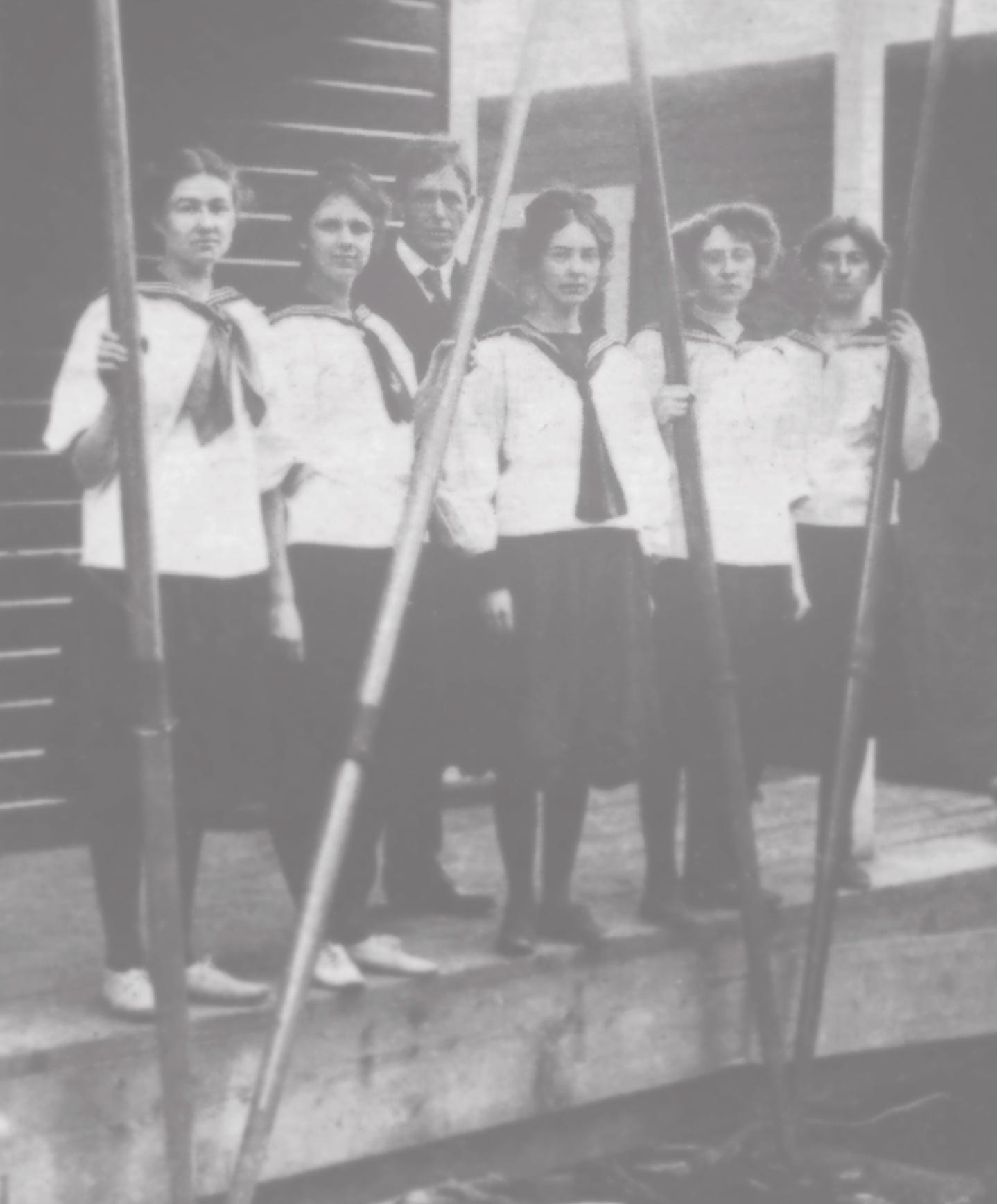
MAKING WAVES
B y H annelore s udermann
As excitement grows for the new major motion picture featuring the men’s crew of 1936, it’s time to acknowledge the “girls in the boat.”
30 UW MAGAZINE
Almost as soon as UW men started rowing, women did, too. Here, women’s crew members from the early 1900s join coach Hiram Conibear in front of the boathouse on Lake Washington.
Despite pressure from the UW’s academic leaders, Conibear supported the women students’ efforts.
What couldn’t women do?
At the turn of the last century, that was the big question. Shaking off Victorian strictures, young women were challenging gender roles, demanding the right to vote, climbing mountains and attending college.
Why shouldn’t they, then, partake of one of the most popular sports at the University of Washington?
Despite resistance from campus leaders, they did. The sweet-scented pages of an old Tyee yearbook reveal that in 1903—one year after the men’s crew was formed—a women’s rowing team was out on Lake Washington in four-oared barges. The entry names 10 students “in training” and describes them as rising early to be at the dock by 6 a.m. and using “the same boat as the boys and under the same conditions.” To do this, the women hiked down muddy, wooded trails in their woolen exercise uniforms to learn and master a sport that was just catching hold on the West Coast. The story of women’s rowing at the UW—rife with hardship, gumption and elite athleticism—is every bit the classic Northwest tale as the men’s.
Former men’s coxswain, Eric Cohen, ’82, has spent the past two decades chronicling the history of rowing at the UW. He was at first challenged by the paucity of details about the early years of women’s crew at the UW. In addition to relying on the research of only a few other historians, he dug into old yearbooks and newspapers to find details of the early efforts.
“I think we need to mention Hiram Conibear (the head rowing coach from 1907 to 1917),” he says. “He was fairly eccentric—so curious and adept.” “Connie,” as he was known, had the personality of a company founder, an energy and charisma that easily won people over. He cut a dashing figure on the dock with his crop of thick hair and dapper tweed jackets. While making rowing an official sport of the University, Conibear didn’t hesitate to include women—welcoming them to train just as rigorously as the men and pushing them to be varsity athletes. “No question, he wanted women to row at Washington,” Cohen says. “And the women themselves wanted it too.”
Conibear resisted the voices from “upper campus” where the faculty and administrators held sway. They said women didn’t have the physical fortitude to row, and that it was unladylike. Undaunted, he armed the women with oars and sent them out in sun, rain or wind to train. As demand among the students grew, Conibear invited the more experienced rowers, like Gretchen O’Donnell from the class of 1912, to help coach.
As it plays out in the pages of The Daily and the Pacific Wave, the student newspaper and magazine, respectively, Conibear fought for years against a pernicious countercurrent from the administration to disband the women’s crew—or at least limit participation to upperclasswomen. At one point, a campus committee found “rowing is a strenuous sport and unless the persons indulging therein are in good physical condition, it is capable of doing harm.” Conibear and the students pushed back, protested
and petitioned. And in some cases, they simply ignored the restrictions. In 1909, more women turned out to row than did men.
Then came Lucy Pocock. The English immigrant from a family of boat builders was 24 and over 6 feet tall. She had helped finance her family’s relocation from Kingston upon Thames to the West Coast by winning races along the river. Her granddaughter Heidi Danilchik found details of Pocock’s story going through memorabilia after her mother died. “I found all these boxes of tarnished silver, all these awards from meets,” she says. “I realized she really did something amazing.” She found news stories about her grandmother competing—in full corset—and winning in the first women’s sculling championship to be held on the Thames. Pocock was a skilled oarswoman, and Conibear urged her to coach the women’s team. “Lucy was already working for the UW and cooking for the men’s crew,” says Danilchik. Pocock’s younger brother George had recently been recruited by Conibear to build racing shells for the men’s crew. George Pocock had a genius for crafting nimble, lightweight racing shells. In his later years, he often reminisced about Lucy. “He talked about her stroke and how beautiful she was rowing,” Danilchik says. “She was so tall, he didn’t have to modify the boats much from the ones he made for men.”
In fall of 1913, with a prize-winning rower as coach and a reintroduction of women’s crew to campus, students turned out en masse to join. Thanks to Conibear’s media outreach, the newspapers took notice. A headline in the Seattle Star exclaimed “Women’s Champion Teaching University Girls to Row.”
Unfortunately, the administration pushed back again, allowing the women to row, but forbidding them from racing. Frustrated, Pocock resigned, though the community support for women’s rowing continued in her wake. “It was such a strange time,” says Cohen. “Women were being given the opportunities to pursue college educations, but they couldn’t vote and were prevented from participating in certain sports.” While the men’s team was racing, the women wanted to compete. “We know from later interviews that once they got out of the eyesight of campus, they’d race each other,” says Cohen.
Maybe they could have persevered, but in 1917, their greatest campus ally, Conibear, died suddenly—breaking his neck while picking fruit from a tree in his yard. And the United States had joined in World War I. Soon the south end of campus was turned into a military camp. All rowing was halted.
While the men’s program was revived as quickly as possible, the women’s was dismantled. From there, women’s rowing during the span of time between 1920 and the 1960s, was pretty much nonexistent, Cohen says. Just a few pictures and yearbook mentions suggest women ever went out in the boats, he says. For decades, “it all but disappeared,” he says.
Then came the ’60s, a decade defined by change. It was a boom time for women demanding stronger roles across American culture. Like their predecessors a half-century earlier, women were challenging their exclusion from boardrooms, classrooms and—in the case of the UW—boats.
In the fall of 1968, a transfer student named Joan Bird wondered why there wasn’t a women’s crew. When she learned that she simply needed to find enough women interested in forming a club and that the Intramural Activities Center (IMA) would provide some resources, Bird got to work. Thirty women signed up, a coach was hired, and the students started borrowing training boats from the men’s freshman crew. They drove to Oregon in spring of 1969 for their first race—the Corvallis Invitational at Oregon State University.
In the summer of 1970, while registering for classes for her freshman first quarter and exploring campus, Jan Harville spotted a flyer that put her on the path to greatness. “I had walked into the HUB and there was this sign that said, ‘Join Women’s Crew. No experience necessary,’” she says.
FALL 2023 31
W
�he UW 1972 Open 8+ team at the National Women’s Rowing Association championship at Green Lake. Left to right: Susan Wayne, Pat Gustke, Debby �onge, Claudia Wells, Jan Holman (Harville), Linda Cless, Susan Bowen, Shelley Benoit, and Jean �urney (coxswain). Harville was the UW women’s head coach from 1988 to 2003.

Harville remembered watching a race in the Montlake Cut with her dad. She also enjoyed sports in high school but found few opportunities to do them competitively. “There really wasn’t much,” she says, listing PE, afterschool basketball, gymnastics and putt-putt golf. “I had lots of exposure to sports, but there was no competition for girls.”
She wasn’t alone in the crowd of new students looking for an outlet. “There was a pent-up athletic demand,” Harville says. So, she and dozens of other young women found their way down to the Montlake Cut, into a boat and onto the team.
It was a hardscrabble start. While the men had the Conibear Shellhouse, the women athletes were based out of a shack on the side of the old ASUW Shell House—the building the men’s crew had used from the 1920s until 1949. Their equipment was limited to a couple of wide tub fours (stable boats used for training), not the sleek racing shells used by the men’s team. Their oars were hand-me-downs from the men. And they weren’t allowed in the men’s crewhouse.
“It was an organized team in the sense that we had a coach,” Harville says. But that was about where the support ended. “We raised the money for our shirts and travel. I remember going with two other rowers to JCPenney to find matching shirts. We had the bake sales, and after the first year, we got some money from the IMA.”
It would be hard to set the scene of change without Kit Green, says today’s women’s rowing coach Yasmin Farooq. Green came to the UW in 1960 as a PE instructor, but she was soon heading
department—had their own shell house, with a kitchen, dining hall and new dormitory, the women were hiking to their practice site and changing clothes in a portable toilet.
Since they needed to train for racing in eights (eight-rower racing shells), the women would rise before dawn, meet at their shed and then walk their oars up the shoreline to arrive at the men’s dock at the Conibear Shellhouse by 5 a.m. “We had to be out onto the water by 5:30 because we had to clear the dock before men’s team started their practice at 6,” Harville says. Then they had to be back on land before the men returned.
Without their own trailer or shells, the team would simply drive to races with their oars strapped to the top of their cars and draw lots to see who got what local boat. “It wasn’t without some fights, and it wasn’t without some struggles,” Harville says of those early years. “When I started off, I didn’t quite get all that. I was excited to have the opportunity. But then, we thought, wait a minute, the guys had all these things, and we didn’t have anything.”
In spite of the early mornings and the hard work, as well as the jeering and teasing they endured from members of the men’s crew, Harville and many of her teammates were hooked on the sport.
“I think it happened pretty fast,” she says. “I was learning something new. I was on the water. And I loved being outside.” One day, after figuring out how to hold the oar, stroke and work together out in one of the tub fours, it happened—not just for Harville, but for the other women in the boat. “We had learned to row a little bit better and a little bit harder and all of a sudden, we could feel the boat run. All of our catches were together. You might call it the swing of the boat or the run of the boat. It really is a magical feeling. You pull as hard as you can, and you just fly,” she says. “To this day, we remember that moment.”
In 1971, the Huskies won four divisions in the National Women’s Rowing Association championships. They did it again in 1972, putting them solidly on the path to consistently dominating national rowing competitions.
In 1975, thanks to Title IX and people like Kit Green, women’s rowing became a varsity sport for the second time. Their first Varsity 8 win came in 1981 and was followed by four more consecutive years of championships. By this time, the men’s and women’s programs were working together as UW Rowing, sharing resources and paying their coaches and trainers equitably.
Harville graduated in 1974 and went to work as a microbiologist, but she and a few of her old teammates couldn’t break the habit of rowing. “Some of us just really enjoyed it.” she says. A few years later, she tried out for the national team, and joined the U.S. Olympic teams in 1976 and 1980. In fall of 1980, Bob Ernst, who had coached Olympic teams (which included several Huskies) from 1976 to 1988, was hired as the women’s head coach and tapped Harville to be the assistant coach. “The UW was in a phase of making things more equitable for women,” Harville says.
In 1987, Harville became the women’s head coach. Over 16 seasons, she directed the team to three NCAA championships. Joining the NCAA in 1997 meant the program could offer scholarships and recruit elite athletes.
the Intramural Activities program, at the time, the only outlet for women athletes. The UW’s athletic department only funded men’s sports, so women didn’t have scholarships, lockers, coaches, trainers, uniforms or transportation.
But times were changing, and Green was positioned to turn limited funding for women athletes into significant support. To honor her, in April, the crew named its newest varsity eight racing shell the “Kit Green.”
As the women’s crew was reforming locally, Title IX was coming into effect across the nation. The federal law, passed in 1972, prohibited discrimination against students based on sex. With Green’s help, the UW began directing more resources to women’s teams. Still, while the men—supported by the UW athletic
While the book and upcoming motion picture, “The Boys in the Boat,” features the men’s crew of 1936, it is part of the bigger story of UW Rowing, Harville says. “I think the movie is going to be awesome. The book was so good. The book gave us a way to help our families and the University and other people we work with understand the sport and its history.”
While rowing on the East Coast and in Europe might be seen as something as elite, “I never felt that here,” Harville says. It’s much more about kids from working-class families finding something resonant in the sport.
“Even today, you can come in not knowing how to row and become an Olympic athlete,” she says. “Our history is one of both excellence and opportunity.”
32 UW MAGAZINE
DEBBY TONGE JACKSON

The Shape of Things
Icons of innovation, these industrial designers who trained at the UW enjoy a reunion in an Art Building workroom. From left: Steve Kaneko, Dell King, David Smith, George McCain and Harold Kawaguchi.
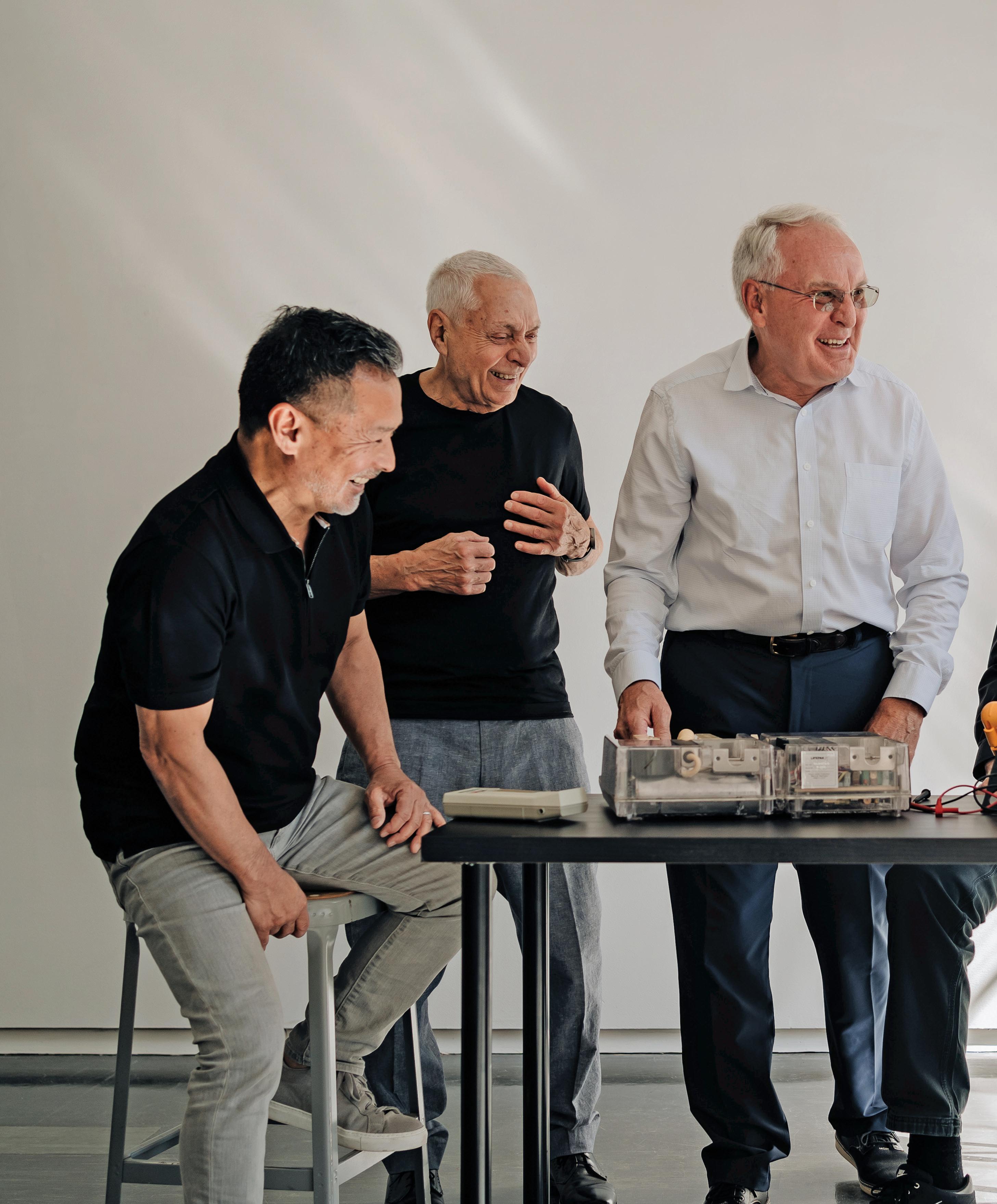
Things to Come
Stop and look around you. If you’re sitting in an Aeron chair, in the kitchen using a garlic peeler made by OXO or listening to a podcast on your Apple AirPods, thank (or blame) an industrial designer.

Almost every object made today has been defined by a designer making careful decisions on your behalf, balanced with both business and engineering forces that push and pull at them.
Industrial design is simply the profession that performs the role of an architect. But instead of designing a building, they create products that are mass-produced in the hundreds of thousands or multiple millions. Like artists who express the zeitgeists of the day, designers act as corporate storytellers and composers of solutions that distill thousands of decisions into singular objects that solve a human need, hopefully elegantly.
If these halls could talk
In the 1950s and 1960s, a collection of wide-eyed students roamed the halls of the University of Washington School of Art + Art History + Design, wondering if their futures could be different than the careers of lawyers, doctors, accountants or engineers their parents dreamed for them. Their renderings of cigarette lighters, MG cars and aircraft interiors destined for future Boeing airplanes, were an exhilarating mix of colored pencils, gouache and pastels that looked like they were inspired by Michelangelo. Mechanical drawings done with graphite pencils looked like Da Vinci’s. Up close, they noticed the odd errant line or smudge, and drew in the unmistakable perfume of inks and paints that gave them permission to share the air with the fine-art students in the classrooms next door.
They were hooked, unable to resist the allure and romance of creating wonderful things that would find their place in the world for others to experience. Twenty-plus years later in the early ’80s, those same hallways hooked me. Although then there were stereos, lamps, Xerox machines and recreational gear that were pinned up on the walls with the new Flo Master inks and lighter-fluid-and-pastel washes on acetate. Some rudimentary computer-generated mechanical drawings were just starting to make their way up there.
BY STEVE KANEKO Photos By Kris Ladera
Walk the halls today, and it’s photo-realistic digital renderings that don’t smell like Prismacolor markers or Flo Master inks—something that the “old guy” in me laments. Having spent almost three decades at Microsoft from the early days of the PC to the internet to holograms, I feel a bit

FALL 2023 35
Five industrial designers, five decades of influence and one message for tomorrow’s designers
guilty about being a part of the explosion of digital tools now made accessible to these students designing the future.
My daughter Maya is one of those designers. She’s pursuing a master’s in design in those same UW hallways, at a time when technological change is accelerating exponentially, making the world we live in so unpredictable. This new generation of designers will have to grapple with problems spanning from climate change to AI, while having to discern between new realities—ones that are mixed—with physical people, places and things coexisting and interacting with digital things.
At such a pivotal time in history, I think about the past and what helped designers and engineers adapt, survive and even flourish amid so much change. Reflecting on these hallways and pinups today, I think about what is the same, what is (very) different and what should give us hope that today’s students will be prepared to take on the challenging problems of tomorrow.
NW design pioneers with a side of enchiladas
For the past three years, I’ve been having lunch with four of some of the region’s pioneering industrial designers at Cactus in Madison Park. The men, once my mentors and now friends, were the ones walking those halls at the UW between 1956 and 1972 in the industrial design program started by Frank Del Giudice in 1952. A few years earlier, Del Guidice moved here from Back East to establish the Walter Dorwin Teague studio in the Northwest, which figured out how to design a converted Boeing B-52 Stratofortress bomber into the civilian-friendly 1946 Stratocruiser, which later became the iconic 707. Over chips and salsa, Harold Kawaguchi, ’61, ’65, Dell King, ’60, ’69, George McCain, ’69, David Smith, ’70, ’72, and I catch up on life and discuss our shared interest on the state of industrial design as well as design education. We try (and usually fail) to dial down our healthy concern for the material design world that is quickly losing its emphasis on three-dimensional craft due to an expanded notion of “experience design” or “design thinking” that has muddied the once clear delineation between design disciplines and their curriculums.
My lunchmates, who all grew up around the Seattle area and studied or later taught at the UW, played an instrumental role in making the Pacific Northwest a progressive product-design center of excellence for both hardware and software products ranging from consumer goods to medical diagnostic equipment, computer technology and recreational gear.
Selfishly, their stories give me context for my own story a full generation later, and provide insights about the design education we received in the UW School of Art + Art History + Design that I believe can endure in the future for my daughter and her classmates.
Dell King, ’60, ’69
King is the central, pioneering figure in industrial design on the upper left coast. Any electrician worldwide will know Fluke Digital Handheld Multimeters as the premium tool for measuring voltage, resistance and current. They are designed, engineered and mostly fabricated at the Fluke Corp. in Everett. King was hired by its founder and fellow UW alum, John Fluke Sr., ’35, and went on to design the world’s first handheld digital multimeter, the Fluke 8020, that set the industry standard.
At Fluke, King insisted on an extraordinary attention to detail, something he both uncovered and developed through his passion for model-train building he’d harbored since being a young boy growing up in Seattle more than 60 years ago. As kind of the “godfather” of Pacific Northwest industrial design, he established Fluke as a premium international product-design house that was
not just known for its standard-setting products, but also for its world-class corporate design-management program.
Later, as the CEO of Teague and as a beloved professor of industrial design at Western Washington University for 37 years, King singularly influenced more industrial designers here than anyone else. Back at Fluke, one of his most inspired decisions was to hire his complement, George McCain, who mastered the art of influence with a smile and created a disciplined team that would educate more product-design leaders in the Northwest in those years than any other company. Because of them, working there became known as getting the “Fluke Master’s in design.”
George McCain, ’69
In 1968, George McCain wondered why Dell King was watching his class presentations from the back row with such interest. McCain had just returned after serving in the military and working at Boeing for a couple of years to make ends meet as a newly married man. The answer was that King was looking for designer No. 2 at Fluke, someone who could help him extend and scale his design vision for years to come. McCain, who dreamed of being a car designer, embodied and created a culture that reinforced King’s mantra of “Evolution, not revolution.”
McCain was a designer and group manager who saw design as a disciplined act that would be guided by a set of rules, whether they be universal design principles or the corporate guidelines he helped create. Like a familiar piece of music, it consisted of familiar notes that you feel without having to think, and McCain was the orchestrator of this culture of collaboration and accountability.
This leadership would take him to Almelo, in the Netherlands, to lead the design team at Fluke’s partner company, Philips, where he would spread his design wings before returning to the Northwest to finish his 38-year career at Fluke.
My cohorts and I have always considered McCain to be the father figure in Northwest industrial design. His commitment to giving back to the profession is evident through his teaching at the UW for a decade and holding multiple positions in the Industrial Designers Society of America, where he is chair emeritus and an IDSA Fellow.
Harold Kawaguchi, ’61, ’65
For anyone who has suffered an acute heart incident and survived, it’s likely because of a heart defibrillator designed in Redmond, made by Physio-Control. Harold became employee No. 3 there after a short stint working for Frank Del Guidice at Walter Dorwin Teague. Just 23 years earlier, Kawaguchi was 5 years old and had just witnessed the destruction of his family’s Seattle farm before they were sent to a Japanese American incarceration camp in Northern California. As a young man, he thought he might become a doctor, not a designer. But, one day he walked into the UW art building, went down the hall, and he never looked back.
A key moment in Northwest business history is when Kawaguchi designed the LifePak 33 defibrillator out of a series of existing components on a piece of plywood (called a breadboard), in a miraculous 90 days, and proved its commercial safety to the FDA. For someone whose family lost everything, he had everything to gain by doing this as a volunteer, banking on the idea that this startup would pay dividends. That model kicked off critical funding to keep alive the vision of its founder, Seattle cardiologist Dr. Bill Edmark. And Physio-Control became a worldwide reference standard for direct-current, heart defibrillation. As the area’s first vice president of industrial design, he fought to make Physio a place where design mattered top to bottom, and a place that would lure the best design talent.
About the Author: Steve Kaneko, FIDSA, holds a BFA in industrial design from the UW, where he completed his studies in 1985. He has been a Fellow in the Industrial Designers Society of America since 2005. During his 28 years at Microsoft Corp., he has been credited for pioneering and leading the company’s design disciplines across both hardware and software. His 1991 Mouse 2.0 has been inducted into the Museum of Modern Art in New York City. In 2019, he was recognized with the Anne Focke Arts Leadership Award for his contributions to the arts in the Northwest. He has just started a passion project to document PNW product design history through the eyes of its designers at nwidarchive.com.
36 UW MAGAZINE
Kawaguchi credits Dell King as his inspiration. As an investor in design, and always comfortable starting from scratch, Kawaguchi co-created Manifesto (now Resolute Lighting) with UW graduate Doug Varey, ’82, and engaged with a startup called Stratos Product Development group, which helped design and engineer some of the earliest Microsoft hardware products. He then taught for years at the UW. A humble man from humble beginnings, he played the role of the “statesman” to the idea that design means serious business. His wisdom was knowing that he could make a larger impact by surrounding himself with world-class talent and designing the path for them to succeed. His first key hire, David Smith, went on to design the industry-changing LifePak 5. Smith could build anything he put his mind to, and his trajectory was powered by individual drive and the love for speed.
David Smith, ’70, ’72
There’s no question that if you belong to a fitness center or have a state-of-the-art treadmill, you will be running on a Precor machine, designed and fabricated in Redmond. An alum of Physio-Control, and Quinton Medical, and the designer of many of the street-lighting fixtures on Seattle’s Broadway, Smith started Precor in 1980 with an uncompromising vision that designing wasn’t just for products, it was for whole businesses—a philosophy that he learned from Kawaguchi.
Smith put everything he had on the line several times to see it succeed and became a bit of a folk hero for my generation, who saw him as a designer who made it big-time as a self-made entrepreneur. The design award-winning Precor line of exercise equipment became such a successful business that Smith would go on to sell Precor to Dart and Craft, Inc. in 1984, making his risk the story of legend. It’s now owned by Peloton Interactive.
He put himself through UW design school by crewing racing boats, being called upon to be a model maker for the CIA during Vietnam, and always proving that he could carry out his vision because he could just make the thing himself. His stories are littered with moments where he has been doubted by engineering or business types, where he proved them wrong by being able to see things 30 steps ahead, the skill of a fabricator. Never afraid of getting his hands dirty, he rode along with paramedics on MedicOne while at Physio to better understand how to design the LifePak 5, which went on to change the defibrillator industry worldwide. Today, the fancy term for this is “contextual design or inquiry.” Back then it was just the practical sensibility of an exceptionally good designer. Today, you’ll find him still in the shop, with his passion for restoring Concours de Elegance-winning Ferraris, and Alfa Romeos, for clients worldwide.
STEAM, not STEM
Having spent considerable time both researching Northwest corporate-design histories and the human stories behind them, I realized that although technological and business landscapes keep changing, the education to learn how to think critically and creatively in times of ambiguity has always been bedrock.

The fact that these pioneers studied design in the UW School of Art + Art History + Design, where exploration and experimentation reign, is a key point. They were trained to create things that make others think, feel, or simply admire for their ingenuity. Could it be that art, and the exposure to the humanities, remain central to what makes us human? I emphatically say, “Yes.”
Outside of the long debate about the role of creaft in design education, I’m betting on Maya’s generation and the next to ensure that the future is imbued with compassion, craft, and beauty that elevates us—and one that these midcentury pioneers of product design have shown us is worth fighting for.

Designers act as composers of solutions that distill thousands of decisions into singular objects.
David Smith rode along with MedicOne paramedics to better understand how to design the LIFEPAK5 heart defibrillator.
A Passion for Public Health
George Counts wanted to protect people from infection. He became a visionary
By Hannelore Sudermann
The first time George Counts came to the University of Washington, it was to start his career.
Although he retired decades ago, George Counts continues to be recognized for fighting infectious disease and addressing racial inequities in medicine.
The year was 1965, he had just finished medical school and was seeking an internship and residency in infectious disease. When he heard from the UW that he would be welcome as a fellow, “I was ecstatic,” he says. “It was one of the best programs in the country.” He worked in a lab for two years and developed an affinity for Seattle with its “drizzly rain and occasional mountains,” as he describes it.

The second time he came, in 1975, it was as an associate professor. He delved into teaching, patient care and research, succeeding in the competitive realm of academic medicine. After 10 years of focused work, he became the first Black full professor in the UW School of Medicine.
But that was just the next step in his
journey to international recognition in the field of infectious disease. Counts left the UW in 1989, early in the AIDS epidemic, to lead the nation’s clinical trials program for HIV drug treatments.
From the headquarters in Bethesda, Maryland, he developed a national network to conduct the clinical trials, expanding the outreach in testing to include Black people and women. Responding to the dearth of women and non-white participants in clinical studies, Counts also created and led the institute’s Office of Research on Minority and Women’s Health.
In 1999, Counts led a national Centers for Disease Control and Prevention campaign to end syphilis. “The irony that the agency that conducted the infamous Tuskegee syphilis study would now be working to eliminate the disease with my involvement was patently obvious,” Counts
says. Over 40 years, without informed consent, Black participants in the Tuskegee study were either not treated for syphilis infections or treated with toxic drugs like arsenic and mercury. The study is now considered one of the most heinous and racist research projects in American history. While the CDC campaign that Counts led did not succeed in eradicating syphilis, it did significantly reduce incidence for both adults and infants.
The third time Counts came back to the UW, in 2002, he joined UW colleagues running the HIV Vaccine Trials Unit at the Fred Hutchinson Cancer Research Center. As a senior adviser for special populations, he committed not only his expertise and experience, but also his interest in bioethics. The unit was conducting worldwide clinical drug trials, and Counts helped ensure that the term “informed consent” carried the same meaning around the world.
“It has been a long and wonderful journey,” he says. Counts was among the first epidemiologists around the country who recognized the growing need to improve infection control in hospitals. He helped develop the discipline and expand the Association for Professionals in Infection Control and Epidemiology, which focuses on preventing outbreaks of infection among hospitalized patients. In 1983, he was the organization’s president.
Throughout his career, Counts has addressed health and health-care inequities. In 2020, two younger doctors highlighted Counts’ roles and influence in an article in the national Journal of Infectious Diseases, recognizing his decades of effort advancing diversity and inclusion throughout the field of medicine. They pointed to his efforts to bring more Black and brown doctors into the field of epidemiology and to his pushing colleagues and national health organizations to include more women and minorities in their clinical trials. Even in retirement, Counts continues the battle against infectious disease. As COVID-19 was spreading through the Northwest, he met with an advisory board daily to control the spread of the virus in his retirement community.
For all his work helping individuals, communities and his field of medicine as well as for his teaching, mentoring and vision, the Infectious Diseases Society of America Foundation honored Counts with the Walter E. Stamm Mentor Award in 2020. Now the organization of 12,000 physicians, scientists and public health experts has named a conference room in his honor: The Dr. George W. Counts Executive Conference Room at the organization’s headquarters in Arlington, Virginia.
MERYL SCHENKER
38 UW MAGAZINE

SKETCHES ANDREA
REAY, ’01
A Legacy of Leadership
Cary Bozeman overcame a childhood full of obstacles to become mayor of not one, but two Washington cities
By Rachel Gallaher
One day, at the end of June, I checked my mailbox and found, among the bills and grocery store coupons, a small white envelope hand-addressed to me and marked in the upper left-hand corner with an official-looking stamp from the Port of Bremerton. Inside was a 4-by-6-inch laminated card with two typed lists. On one side: The Four Fundamentals of Change (under each subhead—Vision, Discipline, Trust, and Passion—was a short description); on the other: Core Values of Leaders (Learning, Choice, Feedback, Comfort Zones—again, each with its explanation). Even without the return address or any identification on the card, I would have immediately known who sent it.
A couple of weeks prior, I had coffee with Cary Bozeman, ’65, now in his second six-year term as a commissioner for the Port of Bremerton. Known best for being one of the only persons in Washington history to hold mayorship in two cities—Bellevue and Bremerton—Bozeman made a name for himself, thanks to his steadfast commitment to community
and penchant for doing what he considers the right thing, even if it goes against the status quo. I was struck by his genuineness, his open manner, and his willingness to discuss all sides of an argument—not just shut down opposing viewpoints. One of his strengths is meeting with people on their level and letting them know he’s rooting for them and that he’s there to help.
The laminated card that Bozeman sent me contains two sets of principles that have guided him through a nearly 40-year political career that, despite his age (Bozeman is 82, but you would never guess it), doesn’t seem to be nearing its end.
“Cary has a story that is so different from so many other mayors,” says Tom Luce, Managing Principal at Inveris Partners. Luce worked as a senior aide for U.S. Rep. Norm Dicks, ’63, ’68, from 2000 to 2007, during which Bozeman was Bremerton’s mayor. Dicks, who is from Bremerton, and Bozeman worked together to completely revitalize the city’s downtown core, and Luce had the opportunity to work with the
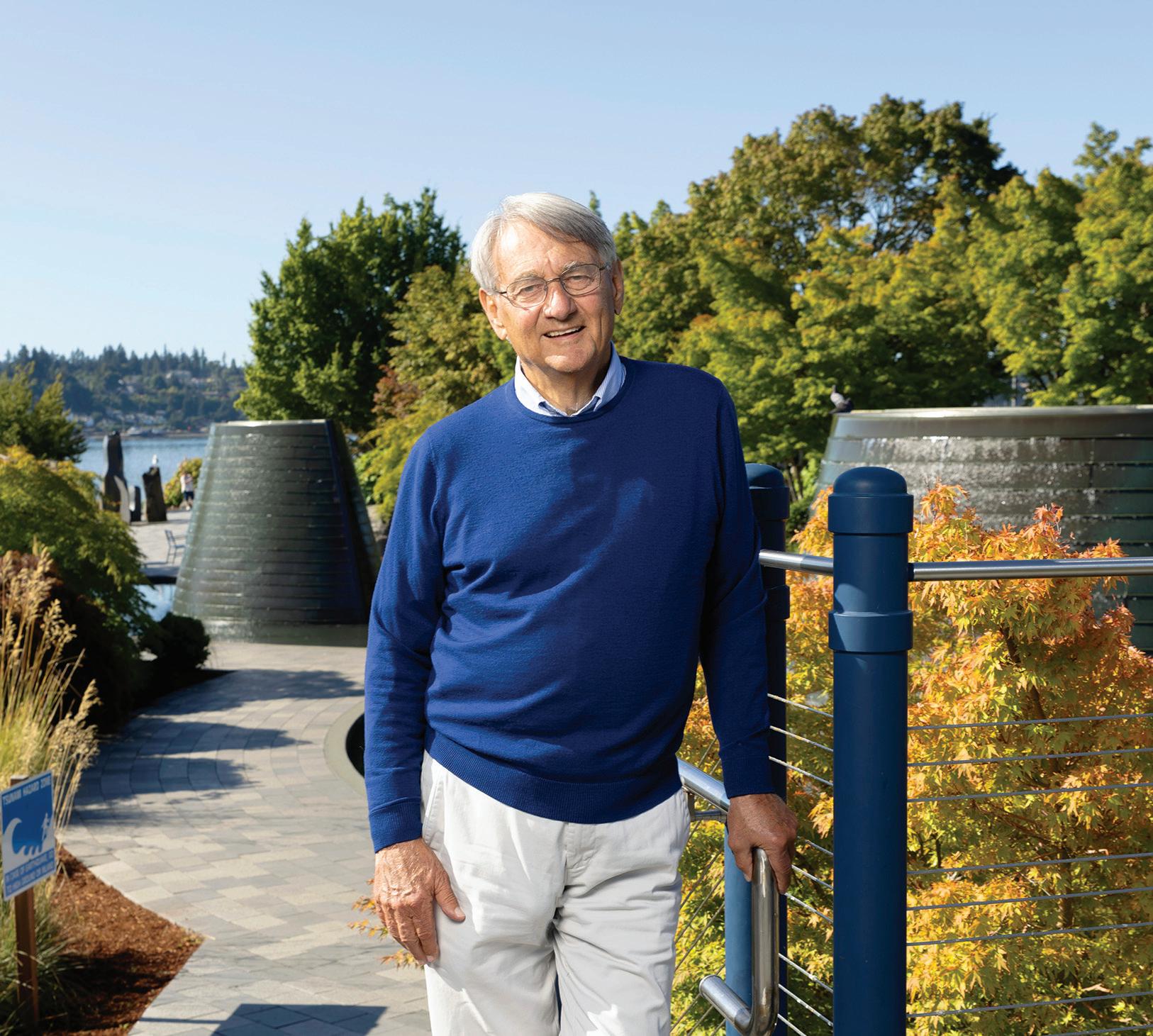
latter as well. “Cary Bozeman is someone who was not just the mayor of Bellevue or the Bremerton—he’s someone who thinks differently about how public service is supposed to be. He is there to get things done.”
Cary Bozeman’s story doesn’t begin in Bremerton, or Bellevue, or even Washington, for that matter. Born in New Orleans, Bozeman and his two siblings were left at a Catholic orphanage when he was just 6 years old. Taken in by their aunt and uncle, the children were shuttled around the country (and to Guadalajara, Mexico, and back) as their uncle relocated for his government job. (Bozeman also ended up in a series of foster homes, living in 12 cities before age 14). Eventually, the family landed in Seattle, and Bozeman attended Hamilton Junior High, then Lincoln High School, where he was a quarterback on the football team.
“I couldn’t read or write very well,” Bozeman recalls. “When you go to that many schools when you’re that young, it’s hard to build on language and math skills. I graduated with a 2.8 GPA, but I was still able to get into the University of Washington—someone like me would not get into UW today. That experience changed my life. Getting that diploma gave me a lot of confidence to go on and accomplish the things I have.”
After receiving a bachelor’s degree in education (“I still have my diploma sitting right in front of my desk at home”), and with plans to become a teacher, Bozeman worked a night job at the Boys Club of Bellevue (a branch of what is now known as the Boys & Girls Clubs of America). Shortly after graduation, he received an offer to teach at Tyee Junior High School, in Bellevue, for $6,500 a year.
“One day, one of my board members came by,” Bozeman recalls, “and he said, ‘Cary, we’re going to have an opening here for the director of the Boys Club of Bellevue. You should think about it. We’ll pay you more than if you were teaching.’”
It was the opportunity to continue to work with youth—many who had grown up in circumstances similar to his own— that hooked Bozeman. “I knew I was impacting people’s lives,” he says.
For the next 30 years—11 of which spent as the president and CEO of the Boys & Girls Clubs of King County—Bozeman worked with the organization. Three years into his directorship, Bozeman, who claims that “the trait of challenging the status quo is part of who I am,” posed a question to his staff: “Why don’t we start taking in girls as members?”
To read more about how Cary Bozeman succeeded in challenging the status quo, go to uwmag.online/bozeman.
40 UW MAGAZINE
Creating Fountain Park in Bremerton (above) was one of Cary Bozeman’s favorite projects when he was mayor in 2005.
RON WURZER
The Spratlen Family’s Support Lives On
Transferring ownership of a book on African American nurses to a professional organization will raise scholarship funds
By Jon Marmor
Thad and Lois Price Spratlen’s generosity continues to have an impact for University of Washington nursing students and the nursing profession, years after they died.
The couple were not only beloved UW professors, but benefactors who for decades underwrote student scholarships provided by the UW Alumni Association’s Multicultural Alumni Partnership. Now, the Spratlen family has generously transferred ownership of all rights of Lois’ book, “African American Registered Nurses in Seattle: The Struggle for Opportunity and Success,” to the Seattle-based Mary Mahoney Professional Nurses Organization. (Thad, a professor of marketing in the Foster School of Business, died in 2021 and Lois, a professor of nursing, died in 2013.)
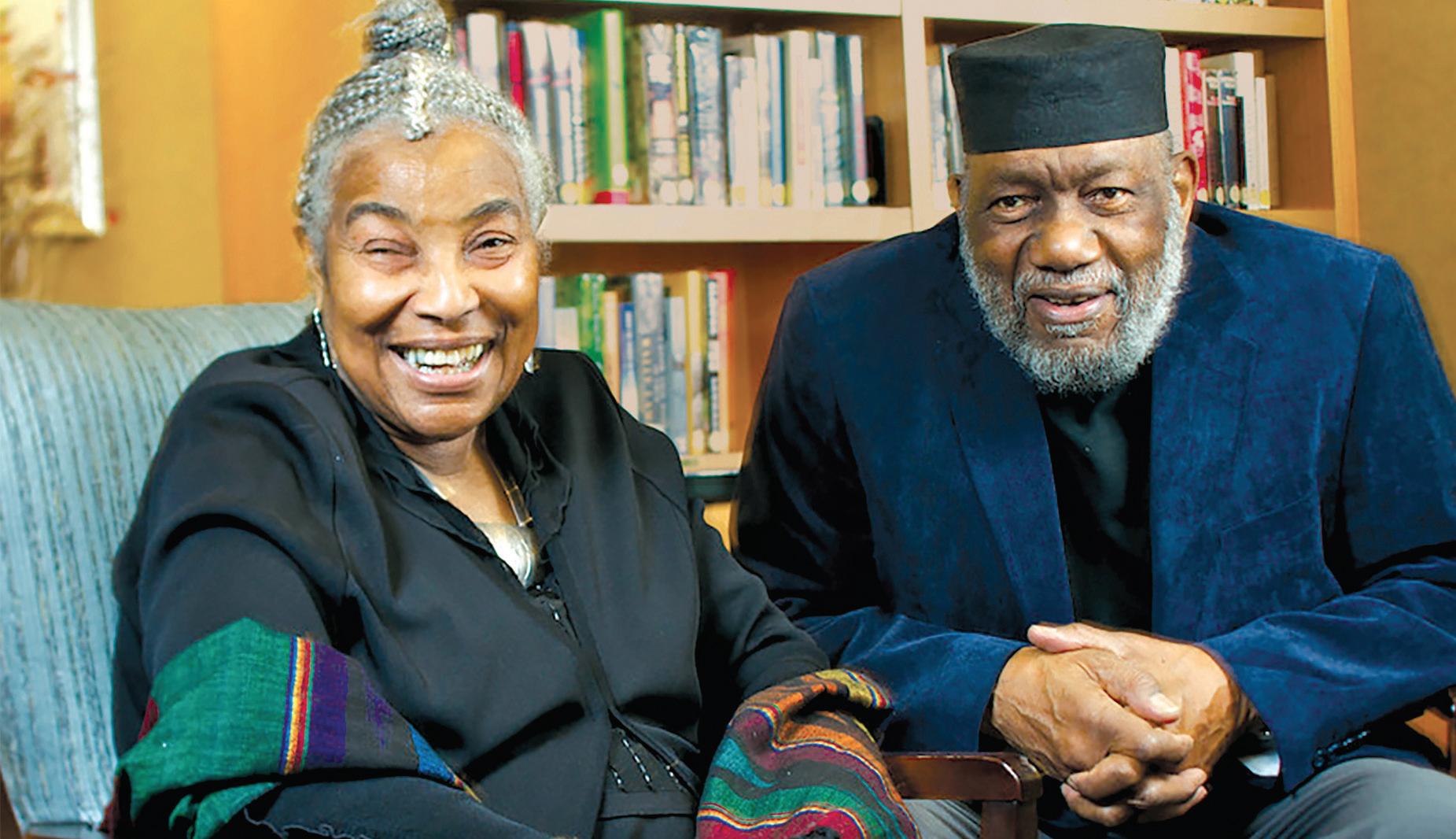
The Mary Mahoney Professional Nurses Organization started in 1949 in honor of Mary Mahoney, the country’s first African American professionally trained nurse, who graduated from the New England Hospital for Women and Children in Boston in 1879. In 1949, Anne Foy Baker invited 12 registered nurses to discuss the possibility of establishing a professional organization for Black nurses. Its goals: to provide information and support to one another, and provide scholarship support to students pursuing education
and careers in the field of nursing.
Lois Price Spratlen learned of the organization from one of its founders, Maxine Haynes, who moved to Seattle in 1972 to join the UW School of Nursing faculty. Spratlen soon became the organization’s president. In 1993, she founded a scholarship endowment for the organization, which has awarded scholarships to African American student nurses during its 74-year history. “Lois was acutely aware of the struggles and successes of the members of the organization that dated to the 1940s and 1950s and into the present days,” says former public health nurse Vivian Lee, ’58, ’59, one of the UW’s biggest supporters of programs supporting scholarship of African American students.
In 2000, Lois began interviewing members of the organization and wrote the first and only book on the history of African American registered nurses in Seattle. The book highlights the lives of 26 African American registered nurses, including 11 of its 13 founders. Many of these nurses are still living and are proud alumni of the UW School of Nursing.
Proceeds from book sales support the MMNPO Endowment. The book is available for purchase at uwmag.online/ MMPNO.
Illuminated Creatures
By Angela Sucich, ’07 Finishing Line Press, September 2023
This chapbook of poetry takes a modern approach to medieval bestiaries, illustrated books that described real and fantastical creatures. It recently won the New Women’s Voices Chapbook competition. Sucich, who completed her Ph.D. in English at the UW, wrote her dissertation on medieval beasts and continues her exploration of animals, humans and human behaviors through her creative writing.
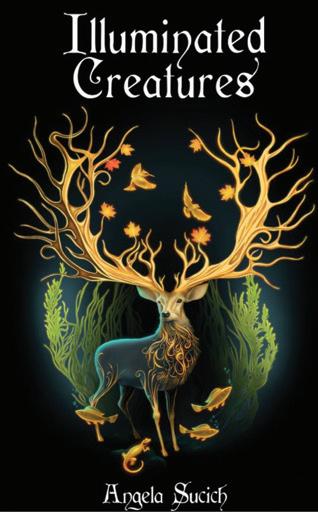
Heartbreak City: Seattle Sports and the Unmet Promise of Urban Progress
By Shaun Scott
UW Press, October 2023
This history of sports in Seattle covers 170 years of actions and events, segregated golf courses, and the 1987 NFL players strike that included the Seahawks. Scott studied film and history at the UW, then threw his energies into filmmaking before he branched out into writing essays and books. He has also become a figure in Seattle-area politics.

Morning People
Mason Lowe, ’97 Killroom Records, June 2023
Musician Mason Lowe, best known as the drummer for the Seattle band Bread and Butter, recorded this debut solo album in his home studio, creating it during the pandemic. Despite its bleak basement origins, “Morning People” features short, positive songs with a touch of grunge. “I dived into music in a way I never have before,” he said in a recent news release. “This was a super serious time but the songs that came out are really poppy and fun. I don’t know why. I’m not a sunshiny person.”

MEDIA
FALL 2023 41
MATT HAGEN
Adventures to Egypt, Patagonia and Finland Await You

Summer is behind us, school is in session, and that means it’s the perfect time to plan trips for 2024. UW Alumni �ours has its usual collection of adventures for the new year. So don’t put your suitcases away yet. Grab your passport, your bags and figure out where you want to go. And remember: You don’t have to be a UW graduate to travel with UW Alumni �ours.
Egypt & The Eternal Nile
January 29–February 12, 2024
Tour operator: Odysseys Unlimited
Accompanied by an expert Egyptian guide, this singular small-group journey through antiquity travels from vibrant Cairo and the Great Pyramids to Abu Simbel and the Upper Nile for a fascinating cruise on Lake Nasser. Then, you’ll embark on a classic voyage along the lower Nile from Aswan to Luxor before returning to Cairo.
Patagonian Frontiers: Argentina and Chile by Land and Sea

February 16–March 2, 2024
Tour operator: Odysseys Unlimited
Relish face-to-face encounters with two of the world’s last great frontiers on this remarkable 16-day, small-group journey showcasing South America’s diversity. Experience vibrant Buenos Aires during a three-night stay, attending a tango show. After exploring Ushuaia, the world’s southernmost city, board the M/V Ventus Australis for an extraordinary four-night cruise that includes the Beagle Channel, Cape Horn and the Strait of Magellan. With three nights in breathtaking Torres del Paine, explore the park’s pristine wilderness. In Santiago, the final destination, enjoy a home-hosted dinner and visits to a winery and Valparaiso.
Check out these highlighted trips and plenty more at Washington.edu/alumni/travel.
Finland, Arctic Magnificence
March 15–23, 2024
Tour operator: AHI Travel
Embrace Finland’s majestic beauty and Nordic charm on this seven-night, active journey! Explore vibrant Helsinki and indulge in the quintessentially Finnish tradition of a rejuvenating sauna. In northern Lapland, gaze at the awe-inspiring Northern Lights from your glass-domed cabin, plus enjoy a snowshoe trek by moonlight and a fast-paced dogsled ride across the pristine fjells. You’ll also tour the splendid old town of Tallinn, Estonia. Includes first-class hotels and a round-trip flight within Finland.
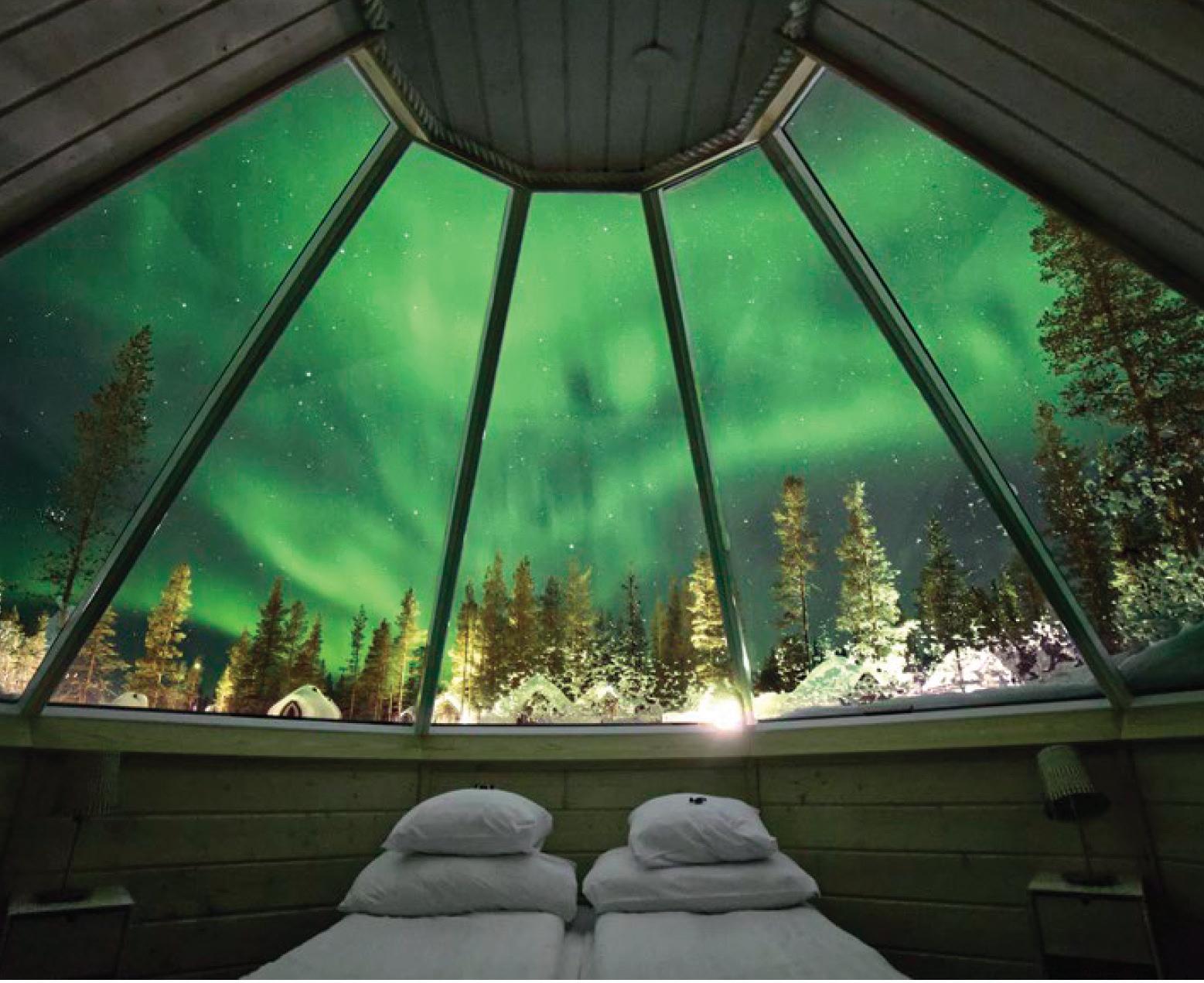
42 UW MAGAZINE
Beyond the Basic Benefits
UWAA members receive discounts from 15% to 20% at many alumniowned businesses.

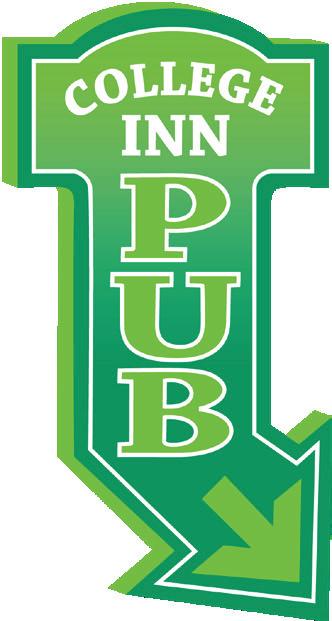
THE NEXT GENERATION
Jaden Manjarrez, ’22, knows what it means to purchase with purpose. As the UW Alumni Association’s Membership Coordinator, he is the person in charge of building out the organization’s robust member benefits program. Offering a diverse mix of access and discounts to businesses and organizations with a strong connection to campus and the Pacific Northwest, member benefits is just one incentive for alumni joining UWAA. Perennial favorites like Husky football ticket deals, access to UW Libraries and discounts to the University Book Store are mainstays. A growing number of the most popular benefits are coming from unique businesses with strong alumni connections. Sweet Alchemy is a U District favorite for ice cream indulgences begun by UW art graduate Lois Ko, ’04. From the Ground Up Socks, featuring images of Mount
Rainier, Mount Baker and the Olympics, began because Rami Nasr, ’16, wanted a stylish option for hiking socks. Keep it PNW is a fun card came developed by Sarah Cabrarteja, ’21, and Rhama Kamel, ’21, as an extension of a company started in the UW’s Create a Company Program. Everyone’s favorite Seattle haunt, the College Inn Pub, is under ownership of proud UW alums Jen Gonyer-Donohue, ’01, and Al Donohue, ’99, ’02.

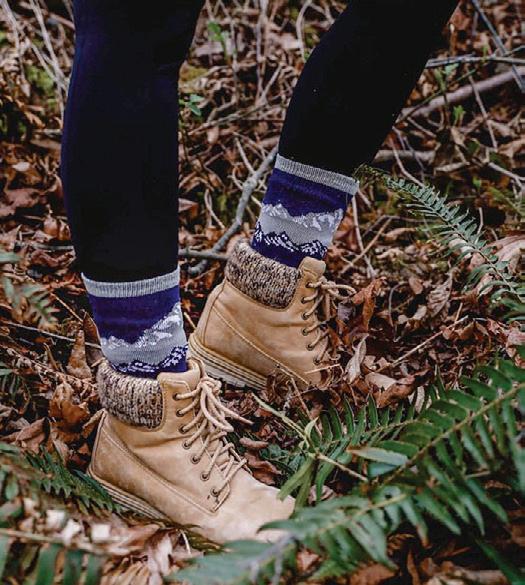
Marjarrez enjoys welcoming more Huskies into the program: “As an alum with my own small business, I understand the importance of uplifting fellow alumni to provide a greater sense of community.”
Interested in learning more about the UWAA member benefits program? Contact jadenm18@uw.edu.

FALL 2023 43 NEWS FROM THE UWAA
FALL 2023 43 UWAA
JOIN THE PACK UWALUM.COM/JOINUWAA CHAMPION
membership dues help support students through mentoring connections, campus activities and scholarships.
Mental Health Gets REAL
By Malavika Jagannathan
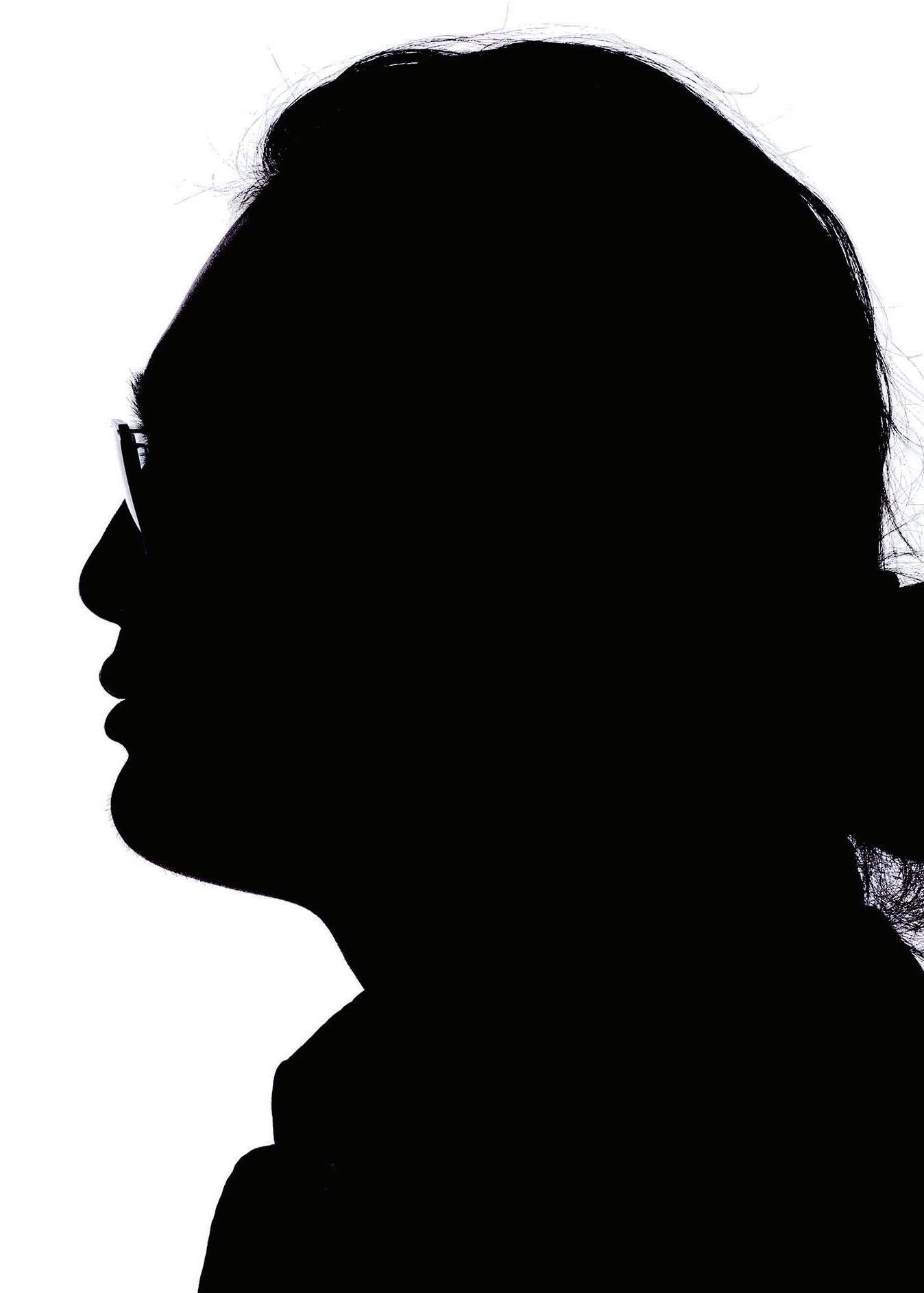
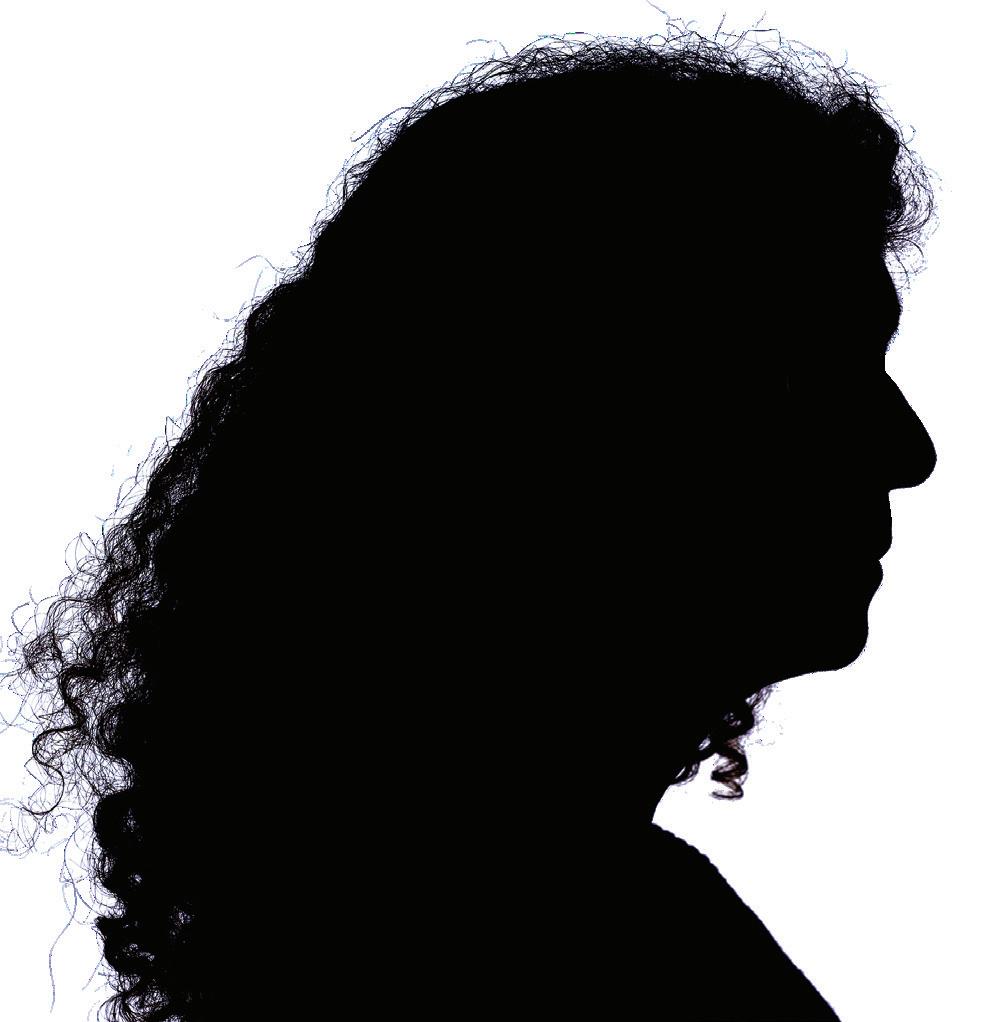
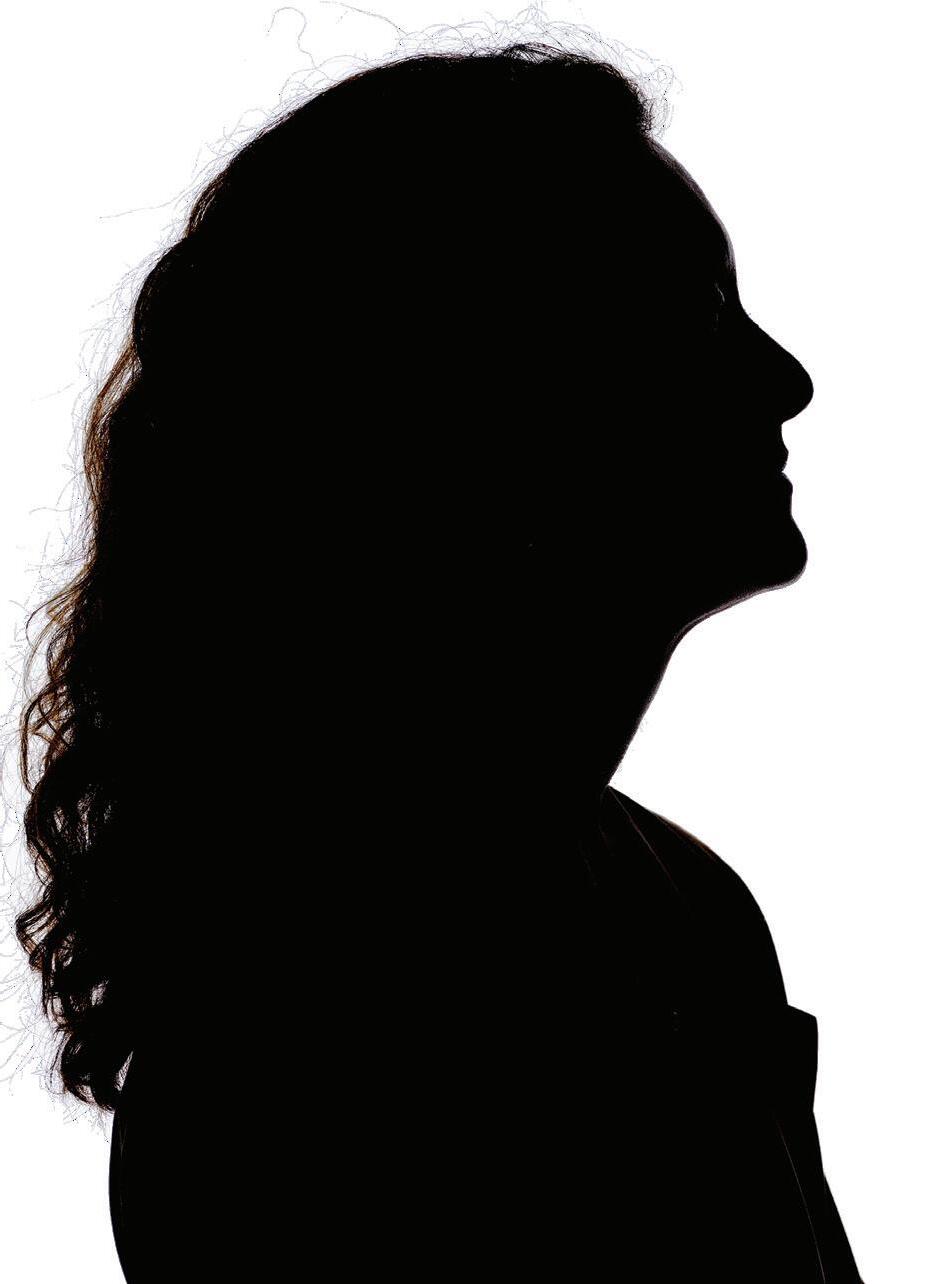
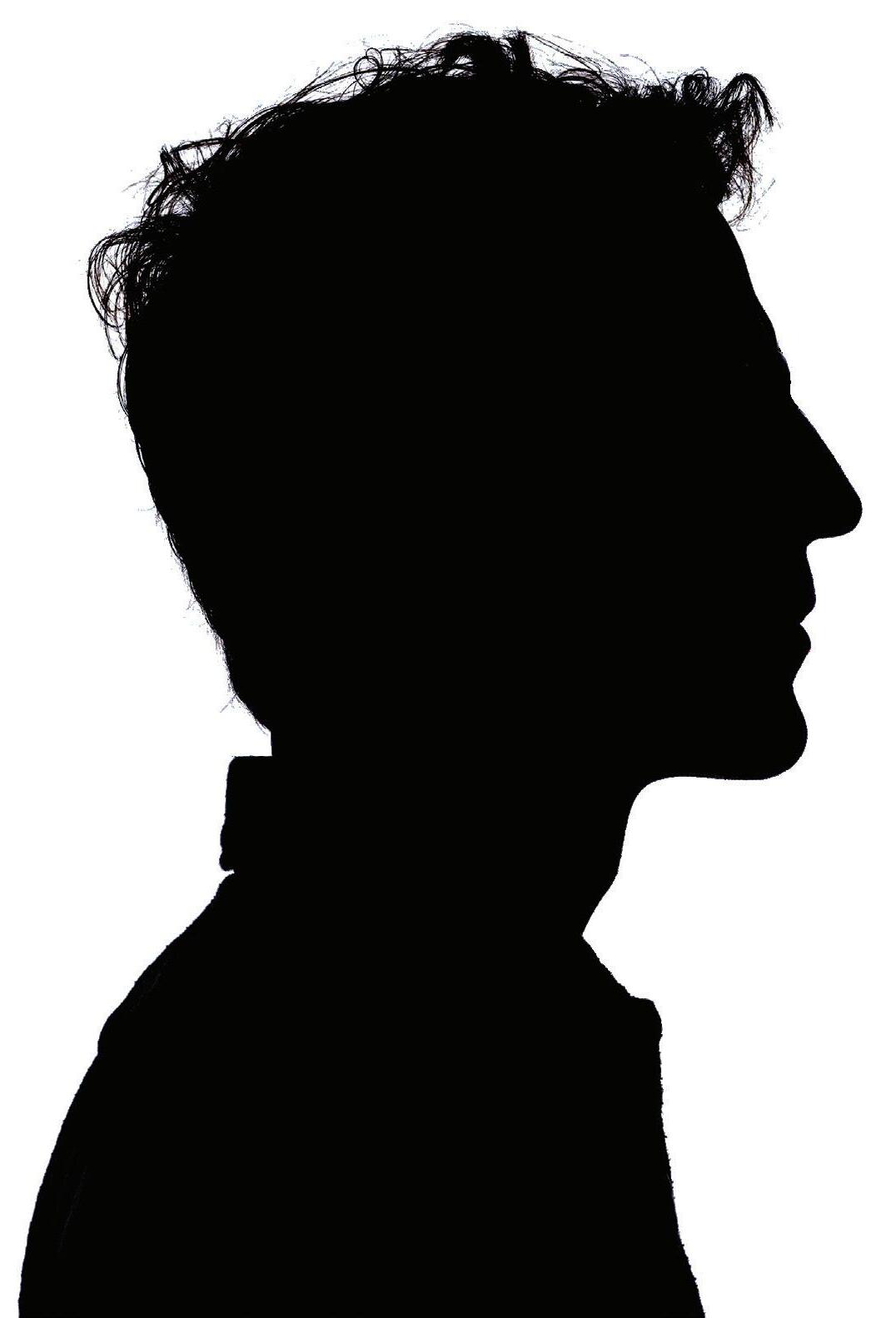
In late 2022, Rodrigo “Rudy” Gallardo, ’25, was warming up for a wrestling meet with Western Washington University when his nerves kicked in. Instead of pushing his anxious thoughts away, Gallardo pulled out his journal and started writing down what he felt.
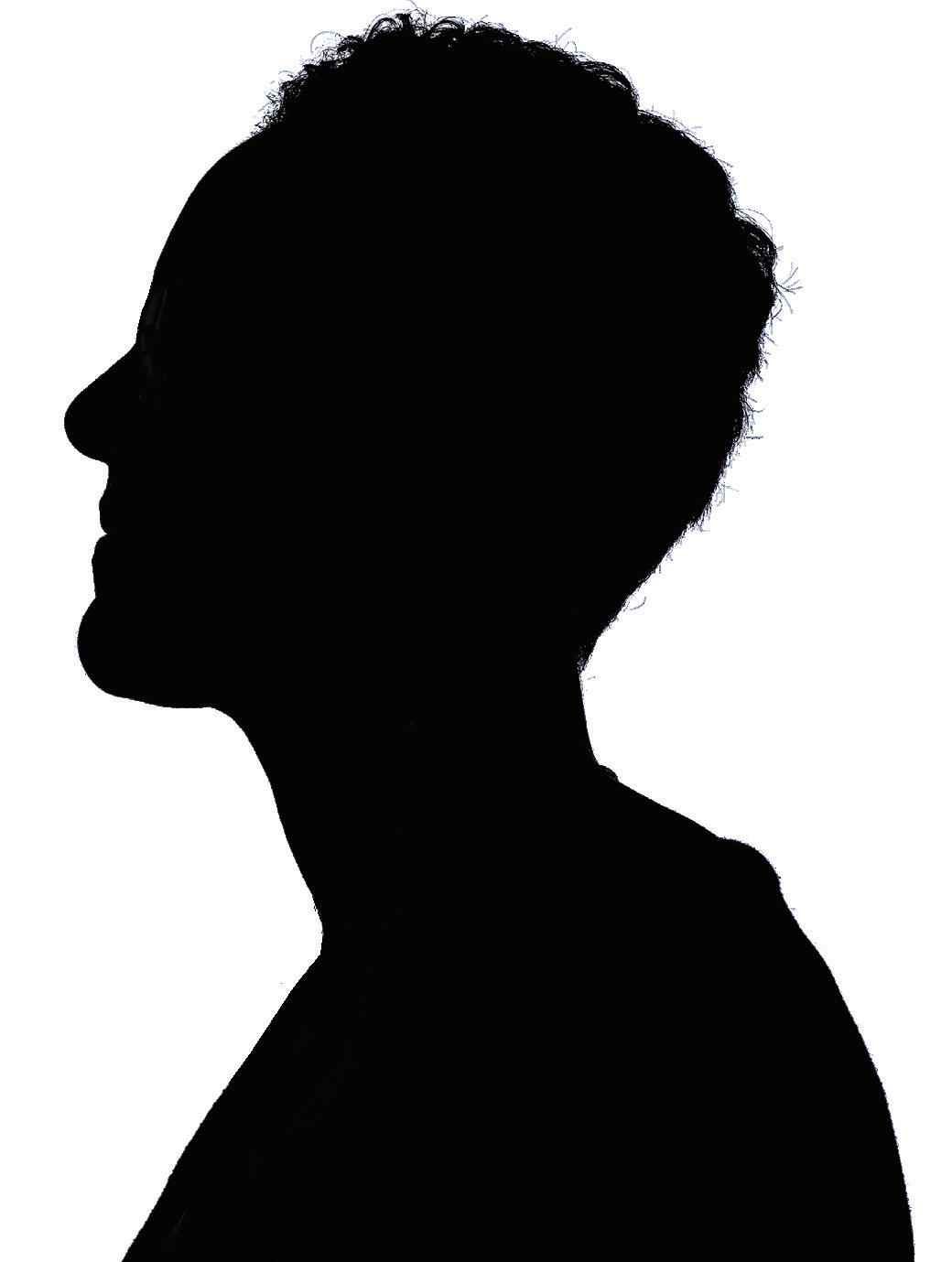
Suddenly, he realized his anxiety was rooted in the fear of letting his team down. Naming that fear helped him work through it—and he went on to win all three of his matches that day.
Gallardo discovered this journaling technique through Be REAL (REsilient Attitudes & Living), a six-week wellbeing program that combines mindfulness, self-compassion, neuroscience and cognitive-behavioral coping strategies. Participants meet in small groups for 90-minute weekly sessions with a trained facilitator who guides them through discussion, activities, contemplative practices like meditation and journaling, and cognitive-behavioral practices such as reframing and unpacking thought patterns.
It was eye-opening for Gallardo to learn what worked for him in stressful situations like that wrestling match, because he didn’t have much experience talking about his men-
tal health. “I would have appreciated it as a freshman,” he reflects, recalling the burnout and social disconnection he faced in his first year at the UW. “It felt like a support group and made me look forward to it.”
He’s one of more than 1,000 UW students across all three UW campuses who have participated in the research-based program, a partnership between the UW’s Resilience Lab and the Center for Child & Family Well-Being (CCFW). In 2022, University President Ana Mari Cauce designated resources from the UW Fund to expand the program’s reach— part of an effort to combat the mental health crisis facing the nation’s college campuses, including at the UW.
Current undergraduate students are navigating the transition to college during a time of major social, economic and political uncertainty, explains CCFW director Liliana Lengua. “It shouldn’t puzzle us why there is a dramatic rise in anxiety and depression,” says Lengua, the UW Maritz Family Foundation Professor of Psychology. “There’s a sense of threat in our youths’ lives right now. They feel uncertainty about the future. Their bodies feel threatened, especially
44 UW MAGAZINE
GENEROSITY AND OPPORTUNITY
AT THE UW
PHOTOGRAPHY: DENNIS WISE ILLUSTRATION: MELISSA MAXWELL
The research-based Be REAL program helps Huskies feel less stressed, more connected—and happier.
Create a culture of well-being. When you support the work of the Resilience Lab and the Center for Child and Family Well-Being, you help equip students, staff and faculty with the tools to succeed by coping with stress and adversity. giving.uw.edu/sept-2023
Be REAL came into Professor Michelle H. Martin’s life during the COVID-19 pandemic, offering her a necessary space to slow down and connect with others. She loved the ability to choose which strategies worked for her. “It draws on so many different practices that if there’s something that doesn’t feel like you, you can skip it and do something else,” says Martin, the Beverly Cleary Professor for Children and Youth Services in the Information School.
Martin instantly saw the benefits of being able to create that space for her students and academic colleagues and signed up for facilitator training. She incorporated Be REAL into a study abroad program she led to New Zealand this past summer and intends to make it part of a retreat she’s helping plan for Black faculty.
Liliana
Director, UW Center for Child & Family Well-Being
if they’re women or people of color.” She notes that students also lose their connections to traditional support systems and relationships when they go to college, particularly if they’re far from home.
The annual Healthy Minds study, which surveys college students worldwide about their mental health, found that in the 2021–22 academic year, 44% reported symptoms of depression and 37% reported anxiety disorders. Those percentages are often higher for groups subjected to systemic barriers and oppression, including Black and transgender students.

The charge of mental health care often falls to university counseling centers, which have the capacity to serve only a percentage of students, explains Resilience Lab Director Megan Kennedy. Be REAL supports students before they may need clinical treatment or intervention—and aims to “create a culture of well-being on college campuses,” she says.
Research shows the program is working. In 2017, Lengua and her CCFW colleagues rolled out Be REAL to more than 200 students in UW residence halls. The results from that first study were overwhelmingly positive, with students reporting more happiness, resilience and social connection— and less stress and anxiety. Those results, plus student and facilitator feedback, helped fine-tune the program and amplify the most effective parts in its next iteration.
One of the program’s goals is to reach groups that have been historically or institutionally excluded, so the Resilience Lab offered Be REAL in affinity spaces like the Q Center, which supports LGBTQIA+ students. Partnering with advisers and mentors within those groups, and training them to facilitate Be REAL, helps create a setting where students feel supported and understood, Lengua says.
The next logical step was to extend Be REAL to staff and faculty working directly with students. “If we can build the resilience of staff and instructors, we might also improve the culture of well-being overall for everybody,” says Kennedy. “By mobilizing staff members to lead groups, we’re able to reach more students, specifically those who might not go to the counseling center.” Of the 400 staff and faculty who have participated in Be REAL, 70 are now trained facilitators.
Both Kennedy and Lengua say they’re excited to see facilitators like Martin make Be REAL their own. Some departments are offering Be REAL as a credit course, while other instructors are integrating Be REAL content into their curriculum. Lengua notes, “It really gives students the maximum flexibility in terms of where it fits into their lives to access the program.”
Be REAL is also expanding to other campuses in Washington and across the country. With support from a UW Population Health Initiative grant, CCFW collaborated with the Resilience Lab to train facilitators at 18 other institutions, including Washington State University, Western Washington University, Seattle University, the University of Texas at Austin and Johns Hopkins University.
This cross-campus collaboration is key to Be REAL’s success in creating lasting culture change, Kennedy says. “Students are more resilient because they know how to cope with stress more effectively,” she adds. “But our entire community is working toward that outcome, too. That’s something we can’t capture in the research.”
— Megan Kennedy Director, UW Resilience Lab
FALL 2023 45
“It shouldn’t puzzle us why there is a dramatic rise in anxiety and depression. There’s a sense of threat in our youths’ lives right now.”
“By mobilizing staff members to lead groups, we’re able to reach more students, specifically those who might not go to the counseling center.”
Lengua
By Jamie Swenson
Dan Baty’s business success has relied on his talent for anticipating trends and meeting the resulting needs. From services for America’s aging population, to the need for affordable health care in parts of Asia and Africa, to Washingtonians’ thirst for wine produced in our home state, Baty saw opportunities and responded—and his business investments thrived along with the people and sectors he served. Today, Columbia Pacific Management, which Baty co-founded in 1989, is a leader in health care, and the Baty family’s Precept Wine is one of the Northwest’s largest private wine companies.
Running a business well also requires building a strong culture and a solid team. “I’m a huge delegator,” Baty once said. “I give people responsibility and expect them to fulfill.” But as a self-described “walk-around-the-office guy,” he also knew his companies inside and out.
It’s no surprise that these qualities characterize the volunteerism and philanthropy of both Dan, ’65, and Pam, ’69, Baty at the University of Washington. The Batys have helped identify the University’s upcoming needs and made wise investments to help meet them. They’ve supported strong teams. And they’ve stayed involved behind the scenes, offering advice, creating connections and fostering collaboration.
Since 1977, the Batys have given generously to their alma mater, powering revolutionary change in health care at UW Medicine, helping create a top-tier teaching and learning environment at the UW Foster School of Business, and ensuring an unparalleled experience for Husky student-athletes and fans. They’ve given the gift of their time as well, always striving to set up the UW—and those it serves—for success.
For their lifetime of philanthropic giving, volunteerism and impact, the University of Washington Foundation is honoring Dan and Pam Baty with the 2023 Gates Volunteer Service Award. The award is given annually to those who shape the University’s trajectory with their philanthropy and service, and who encourage others to do the same.
Pam Baty was born and raised in Seattle. Dan grew up in Tacoma and from a young age wanted to go into business. (Fittingly, he and Costco co-founder Jeff Brotman, ’64, ’67, met as boys on a Tacoma playground and remained lifelong friends.)
After Dan graduated from the UW and went on to Harvard Law School, a Husky fraternity brother of Dan’s connected him with Pam, then a UW student. The friend thought they’d be a good match, and he was right.
Once Dan finished his law degree, he and Pam married and moved to Tacoma, where Pam used her UW degree in education to teach first grade at Lowell Elementary. Dan, who’d studied accounting at the UW, worked in the tax department at Price Waterhouse. Soon he struck out on his own as an entrepreneur, and Pam stepped back from teaching and devoted more of her time to raising their sons—Stan, ’94, and Brandon, ’97, who followed their parents’ example and became generous UW philanthropists themselves.
Pam also began giving her time and support to childhood education, a cause that remains important to her. She was an early supporter and volunteer educator at the Eugene P. Tone School in Tacoma, the first publicly funded school in the U.S. for children experiencing homelessness. She and Dan are longtime champions of the arts, especially the Pacific Northwest Ballet.
Eventually the family moved north to Seattle, continuing to contribute to and guide many local organizations— including the UW, where their smart investments helped meet upcoming needs.

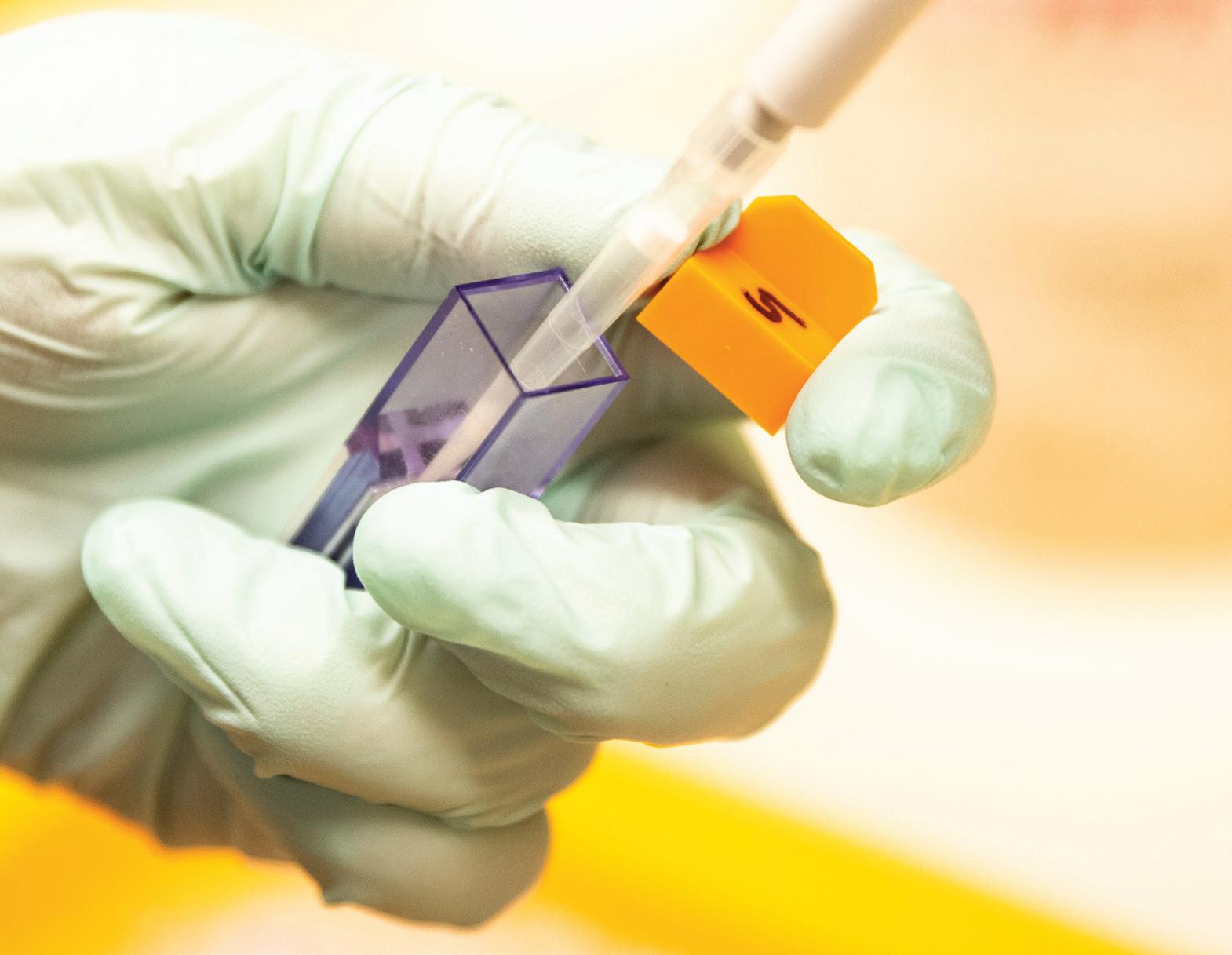
Take the renovation of Husky Stadium a decade ago: In addition to providing generous financial backing and encouraging others to get involved, the Baty family helped UW leadership navigate the project’s complexities. “Dan was a driving force behind the strategic plans,” former UW
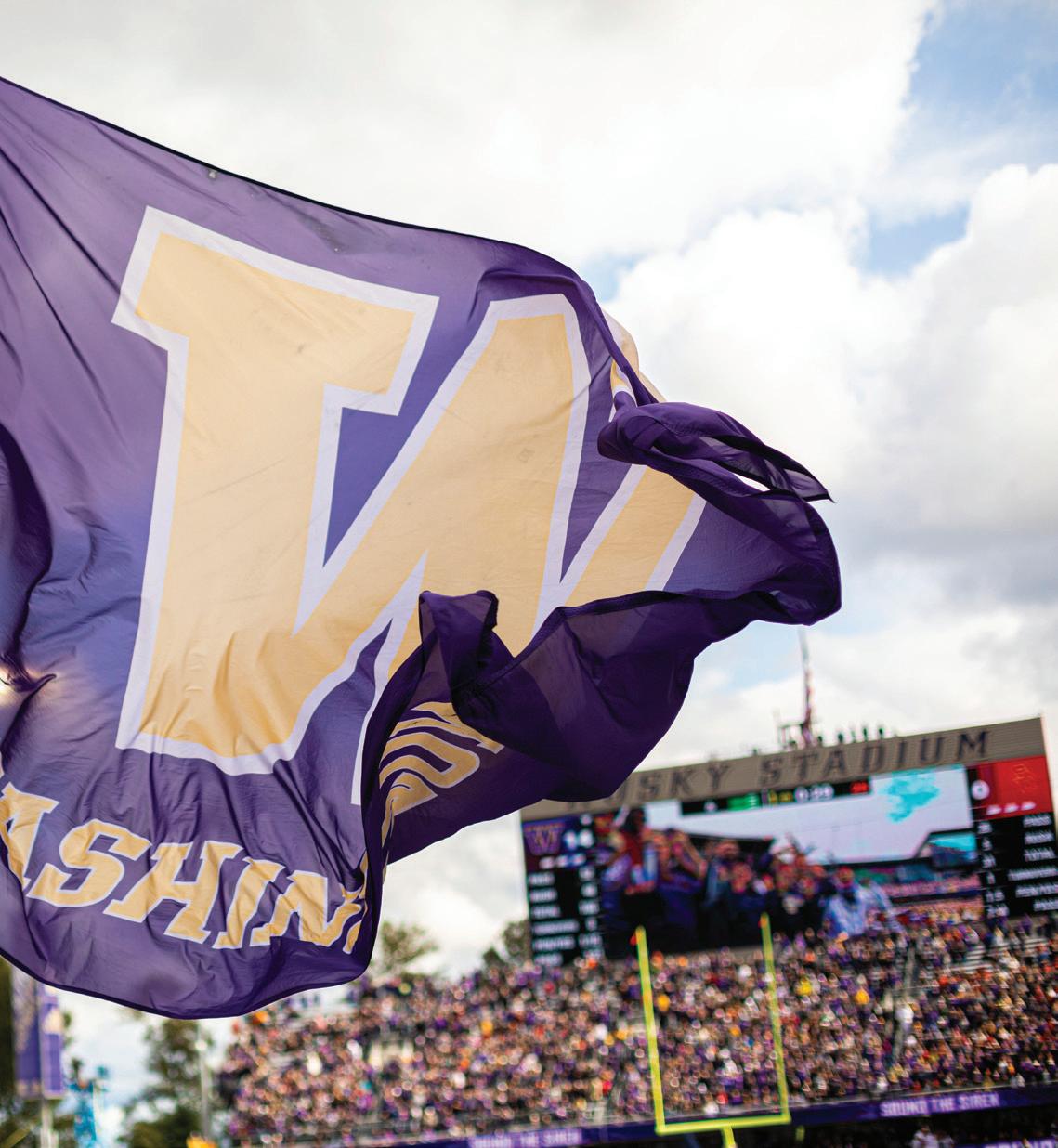
46 UW MAGAZINE PHOTOS: DENNIS WISE
Dan and Pam Baty, recipients of the 2023 Gates Volunteer Service Award, have spent nearly five decades supporting UW programs—and letting their impact speak for itself.
Athletic Director Jen Cohen recalls. “His guidance over the years that the project was developed, designed and executed was a key part of its success.” The Batys’ advice helped UW Athletics ensure the financial stability of all Husky sports programs. Adds Cohen, “I consider myself so fortunate to have had their support and counsel.”
The Batys also left their mark at the Foster School of Business making instrumental gifts toward the construction of PACCAR Hall and Founders Hall, and participating in the fundraising campaigns for both buildings. Dan, recognized with the Foster School’s 2014 Distinguished Leadership Award, gave the keynote speech at the school’s 2019 graduation ceremony.
Peering Deeper
By Patrick Crumb Chair, UW Foundation Board
Not only does Dan embody how a Foster School education prepares one for the business world; he also lives his dedication to supporting the school, having hired many Foster graduates throughout his career and encouraged many employees to continue their education through Foster’s executive programs.

The Batys’ generosity has had a significant impact at UW Medicine—from helping attract and retain distinguished doctors through endowed chairs to establishing institutes that cultivate collaboration and innovation among UW and community experts.

In 2017, thanks to the visionary leadership of Dan and Pam Baty and Jeff and Susan Brotman, the Brotman Baty Institute for Precision Medicine (BBI) was launched. Since then, BBI scientists have made significant discoveries in precision medicine to treat cancer and many other diseases. The BBI laid the groundwork for responding to the COVID-19 pandemic; its work to monitor the spread of COVID-19 and other respiratory diseases allowed for quick public-health interventions.
The Batys paved the way for the 2019 founding of the UW Medicine Diabetes Institute, which has already advanced treatment and dramatically increased the number of patients served. Pam, whose sister has Type 1 diabetes, has spent several years on the UW Medicine Diabetes Committee. UW Medicine Professor Irl Hirsch, chair of diabetes treatment and teaching, wrote about Pam, “Because of her vision, we have built one of the best research, clinical and teaching programs in the country.”
Over nearly five decades, Pam and Dan Baty have led by example at the UW, anticipating opportunities and helping position strong teams to make the most difference. They have preferred to stay out of the spotlight, letting the University’s work speak for itself. And it speaks loudly.
“Our family is a large contributor to different schools at the University because of the large contribution the University makes to the community,” Dan has said. “It goes beyond any specific school or people—it’s the importance of the University to the community.”
If you look at the night sky from the city, you may be able to pick out the Big Dipper. If you gaze upward from a remote area, you might see it clearly against a backdrop of smaller, fainter stars. And if you train a telescope on it, those fainter stars come into full view against a sea of even more stars beyond. The deeper you peer, the more you’ll see.
In the past two years as chair of the University of Washington Foundation Board of Directors, I’ve been peering deep into the work of the UW. I’ve learned that any given project is usually part of a constellation of efforts that create positive impact— connected to even more brilliant people, researchers and programs all doing the same.
A perfect example: UW astronomers and data scientists are on a quest to gather unprecedented amounts of data about the stars, then use advanced tools to interpret it and shed light on some of the great astronomical mysteries of our time. On p. 48, learn about the immense promise of the new Vera C. Rubin Observatory, the Legacy Survey of Space and Time, and the UW Institute for Data Intensive Research in Astrophysics & Cosmology.
But there are many other frontiers the UW is exploring—not just out there, but within us and among us.
On p. 44, read about the research-based Be REAL (REsilient Attitudes & Living) program, teaching students, faculty and staff across campus how to harness strategies to care for their own mental health. Be REAL equips participants with an extensive toolbox of mindfulness, compassion and wellbeing practices—and aims to create a more empathetic and inclusive campus culture.
Whether you’re taking your first steps as a UW donor or volunteer, or have shaped the University’s trajectory for decades—as have this year’s Gates Volunteer Service Award recipients, Dan and Pam Baty, whose inspiring work you can read about at left— your spirit of generosity makes a difference throughout the University and in the lives of those we serve. As my tenure as board chair ends, I’m grateful to have worked with and learned from so many of you. I can’t wait to see where our stellar community takes us next.
Thank you.
FALL 2023 47
DENNIS WISE
“It goes beyond any specific school or people—it’s the importance of the University to the community.”
— Dan Baty, ’65
AN ASTRONOMICAL AMOUNT OF DATA
In northern Chile in 2025, the Vera C. Rubin Observatory will begin gathering images of the night sky. “First light” (as astronomers call the moment a telescopic eye first opens) will inaugurate the Legacy Survey of Space and Time (LSST)—the most ambitious and comprehensive optical astronomy survey ever undertaken. The UW was one of four founders of the LSST project, which will capture panoramic images of the entire visible sky twice a week for 10 years, making 30 trillion observations of 30 billion astronomical sources and measuring the positions and properties of nearly 20 billion stars.

That’s a lot of data.
So much data, in fact, that it’ll take powerful new tools to manage and analyze it all. Enter DiRAC: the UW’s Institute for Data Intensive Research in Astrophysics & Cosmology.
DiRAC, based in the UW Department of Astronomy in the College of Arts & Sciences, was launched thanks to a gift from the Charles and Lisa Simonyi Fund for Arts and Sciences. The Simonyis anticipated that cameras and telescopes—like the Rubin’s cutting-edge Simonyi Survey Telescope—would soon become so powerful that we wouldn’t be able to keep up with the data they brought in. Since then, DiRAC’s growing team of UW scientists, software engineers, data science specialists and students have been crafting software to comb through vast amounts of information.
Once DiRAC begins interpreting the LSST data, scientists may have answers to questions that fundamentally reshape our understanding of our place in the universe: Is there a Planet Nine? When will the next “killer asteroid” come close to Earth? What are the origins of dark matter and the structure of the universe?
And perhaps the biggest question of all: What is out there that we aren’t even expecting to find?
By Jamie Swenson PhotobyBrunoC.Quint,RubinObservatory
Read more: uw.edu/first-light
Expand scientific knowledge. When you support UW faculty and students, you can help them shed light on some of the greatest mysteries of the cosmos. giving.uw.edu/sept-2023
48 UW MAGAZINE

FALL 2023 49
A Path Less Traveled to the University of Washington
Different experiences provide meaningful lessons
By Joe Davis
Everyone has a unique Husky experience, and mine is no different. When I was growing up, higher education was not a topic discussed in my household. I joined the military at the age of 18, young and impressionable. My first duty station was Fort Lewis, Washington, and I thought I knew everything, but in fact knew nothing at all. One day, my platoon sergeant instructed me to go to the education center and enroll in college. He explained one of the benefits of serving your country is access to tuition assistance. As a young Black man in the Army, I didn’t think I had much choice, so I enrolled in Pierce College, located 30 miles south of Seattle.
Soon after, I was deployed to Iraq and Afghanistan. Despite this break from higher education, I knew that attending the University of Washington was my goal and I looked at ways to make that dream a reality. I finished my first two years at Pierce College and because of the long-standing transfer student pathway to Washington’s four-year colleges and universities, I successfully applied to UW Tacoma (UWT) and completed my undergraduate studies.

UWT was the perfect fit for me. As the
board president of a local nonprofit in Tacoma, I had worked with UWT alums and was impressed with their ties to the community. UWT is one of the region’s leading institutions for military veterans, first-generation and transfer students. And with a student to faculty ratio of 16 to 1, my academic and extracurricular experiences were second to none. The relationships I made with faculty and fellow students remain as strong as ever. As I reflect on my own experiences, I encourage you to reminisce and share with others the stories that made your Husky experience meaningful.
A deep commitment to public service is a core value of our alumni association board leadership. Since graduating from UWT in 2016, I’ve served as a full-time law enforcement officer in Snohomish County and criminal investigator for the U.S. Army. My story, like so many others across our three campuses, reflects the diversity and life experiences of our students and alumni, each of whom contributes to UW’s rich tradition and impact. Please join me and 60,000 UWAA members in making the difference an organized alumni community has on the life of its university.
UW President Ana Mari Cauce often encourages non-traditional routes to public higher education. I’m a living example of those paths less traveled: a Black veteran, first-generation, transfer student, and UWT graduate. I speak from personal experience when I say: Everyone belongs here. Go Huskies!
UWAA TRUSTEES
2023 – 2024
EXECUTIVE OFFICERS
Joe M. Davis II, ’16
President
Kris Lambright, ’86
Past President
Sabrina Taylor, ’13
President-elect
Mark Ostersmith, ’90
Vice President
Skyler Brown, ’19
Treasurer
Mina Sylvia, ’12
Secretary
Erin McCallum, ’89
Assistant Secretary/LAC Chair
Paul Rucker, ’95, ’02
Executive Director, Ex Officio
AT-LARGE TRUSTEES
Courtney Acoff, ’10
John Amaya, ’01, ’05
Caelen Ball, ’18
Danielle DuCré, ’08
Matt EchoHawk-Hayashi, ’00
Deborah Fournier, ’95
Patrick Jenny, ’86, ’91
Solynn McCurdy, ’01
Janet Phan, ’09, ’13
Heather Ratcliffe, ’97
Roman Trujillo, ’95
Cristian Wulf, ’88
REGIONAL TRUSTEES
Kyle Stanton Smith, ’98
Washington State Trustee
Eugene Saburi, ’93
International Trustee
UNIVERSITY REPRESENTATIVE TRUSTEES
Jacque Julien, ’15
UW Bothell Trustee
Alishia Agee-Cooper, ’15, ’17
UW Tacoma Trustee
50 UW MAGAZINE
ANIL KAPAHI
Joe Davis is the first UW graduate not from the Seattle campus to serve as president of the UWAA Board of �rustees. His degree is from UW �acoma.
Proudly cheering on our hometown and Husky Nation since 1971. Go Dawgs.
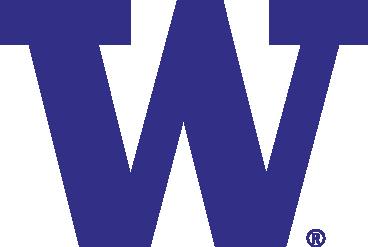


Big Honors for Walker, Goldberg
UW Foundation Board members recognized by two organizations for impact in the community
By Jon Marmor
Staying Tuned
Alum and actor Garret Dillahunt takes the stage with the UW’s student orchestra
By Hannelore Sudermann
Actor Garret Dillahunt joins the UW Symphony orchestra for an end-ofyear performance. An audience of more than 500 were treated to his narration of ‘l'Histoire de Babar, le Petit Éléphant.’
In early June, several unlikely things happened. For its last concert of the school year, the UW Symphony orchestra took on an unusual piece of music with narration. Then they decided to bring in an outsider to help perform the piece. Finally, they found a Hollywood alum with enough time on his schedule and enough Husky spirit to jet up from L.A. and step on stage.
Just how did they get Garret Dillahunt, ’87, movie and TV star, to tell the story of the little elephant, Babar? It started with symphony director David Rahbee.

“I had ideas for years to work with a piece of music that calls for a narrator,” Rahbee says. “But there aren’t that many of them.” When he landed on “L’Histoire de Babar, le Petit Éléphant,” a sweet musical arrangement created around the children’s book of the same title, he knew it could be something extra special, especially if
Two alumni leaders long known for their commitment to advocating for the University of Washington have been honored for their positive impact serving the greater Seattle community.
The leadership of UW Foundation Board Member David W. Goldberg, ’96, was a major reason his Seattle-based company, Mithun, received the prestigious 2023 AIA Architecture Firm Award from the American Institute of Architects (AIA). This national honor celebrates exemplary design and practice and is the highest honor the AIA bestows on an architecture firm.
“This accomplishment is a testament to our incredible project partners—clients, contractors, engineers, collaborating designers, researchers and community members,” said Goldberg. “Together, we’re working to make a positive impact every day for the communities we serve and the health of the planet.”
Another UW Foundation Board member, Clyde Walker, ’77, was honored with the 2023 Spratlen Legacy Award given by the Michael G. Foster School of Business. The selection committee, which includes UW Foster School students, faculty and staff as well as a member of the Spratlen family,

were impressed with Walker’s enduring commitment to the Black community at the Foster School and the innumerable ways he has led the UW community over many decades. Walker served as president of the UW Alumni Association Board of Trustees from 2016 to 2017.
Walker earned his UW degree in business administration and started his career working at the Rocket Research Co., an early developer of rockets and thrusters for space exploration, before joining Primex Aerospace, a manufacturer of liquid and electric propulsion units for satellites and spacecraft. He capped his career leading human resources at Continental Mills (now the Krusteaz Company), and he chairs the board of directors of First Choice Health, an organization he has served for nearly three decades.
“My dad told me, when I was very young, if you want to be good at something, pay close attention to people who already are,” he said. “I’ve always followed that advice in terms of leaning on people’s expertise and knowledge to help me navigate and make decisions. Build a community. Rely on each other. Uplift each other. Support each other. But do it in a very honest, authentic way.”
they could find the right narrator.
A colleague who works with alumni suggested the actor, beloved for his portrayal of the goofy patriarch on the sitcom “Raising Hope,” and admired for disappearing into two different characters on the drama series “Deadwood.”Hailing from Selah, Washington, he had studied journalism at the UW in the mid-1980s. In an acting class his senior year, he found his calling.
It was a dream request, but Rahbee reached out and Dillahunt was game. The actor arrived the afternoon of the
performance and rehearsed with the orchestra at Meany Hall. He delivered on the piece’s humor and nuance. He also visited with the students, many of whom were not music majors.
“It’s inspiring to know that you may be studying one thing and then you give something else a try and that might be the thing for you,” Rahbee says. “I thought his story was a neat example of what can happen. Who knows what one of our students might become? They just need to be given the chance to let that spark take hold.”

FOSTER SCHOOL OF BUSINESS UW BOARD OF REGENTS 52 UW MAGAZINE
�he American Institute of Architects recognized David Goldberg, left,
COURTESY DAVID RAHBEE
while the Foster School of Business honored Clyde Walker, above.
Puppetry, Theater, Joy
Former UW drama professor’s indelible impact still delights us today
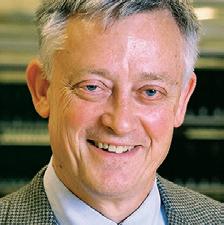
Most people are lucky if they excel at one career in life, but for Aurora Valentinetti, ’43, four was the magic number—and she pursued each simultaneously. Born in 1921, the daughter of Italian immigrants, Valentinetti, who died July 20, 2022, was well known as a professional singer, puppeteer, community theater director, and professor of speech, children’s theater and puppetry at the University of Washington. With a teaching career that spanned 50 years, ending in 1992, Valentinetti touched many lives, introducing students and the community to the art of puppetry.
“Aurora was a small woman, but she was full of energy, a tireless worker and she had a larger personality,” says Stanley Hess, ’64, curator of the Aurora Valentinetti Puppet Museum in Bremerton. Hess took classes from Valentinetti at UW and opened the museum—which houses more than 2,000 puppets and related items—in 1999. Valentinetti’s entry into puppetry began in the 1940s while she attended UW. “Many of the male students and instructors were
being drafted [to serve in World War II],” Hess recalls, “so she stepped in and helped in many roles, and that was the beginning of her teaching career.”
As an undergrad, Valentinetti toured with the UW Puppeteers troupe. Following graduation, as a teaching fellow, she assumed responsibility for the tours and the teaching of the puppetry classes. Throughout her career, she performed locally at the Showboat Theatre, St. Mark’s Cathedral and Bumbershoot. Valentinetti even had a show, “Puppet Playhouse,” on KCTS-TV. In 2018, the UW awarded her the Distinguished Teaching Legacy Award. Although puppetry might seem like an antiquated art form, Hess argues that it—and the lessons Valentinetti offered through her work—are relevant today. “Puppetry in general—and this is something I know Aurora was very conscious of—is very inclusive,” he says. “It is an important part of storytelling, and the work continues through her students and their students.”
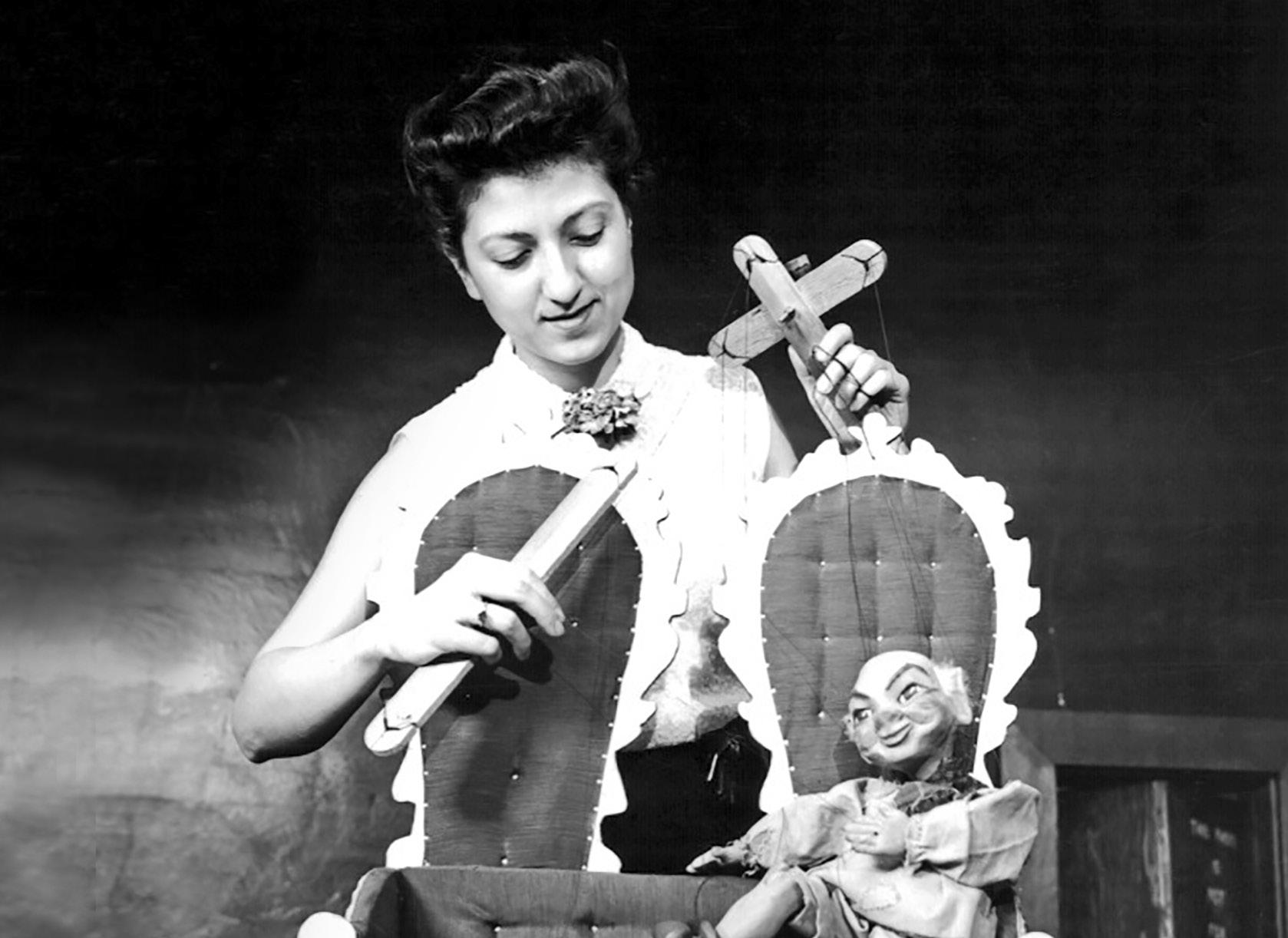
WILLIAM RODGERS JR. was an environmental law pioneer who served the UW as the Bloedel Professor of Law and then the Stimson Bullitt Professor of Environmental Law. He represented the Puyallup Tribe to ensure legal recognition of Native American treaty fishing rights in the Pacific Northwest. He died April 10 at the age of 83.
YEEN-MEI WU was a Taiwan native who came to the U.S. in 1959 with her husband and two children. Ten years later, she was hired as a Chinese Studies Librarian at the UW’s East Asia Library. She spent 32 years working at UW Libraries, developing a database of full-text searchable Chinese histories. She also helped found the Taiwanese Association of Greater Seattle. She died Nov. 29 at the age of 87.

RECOGNITION
O.
FALL 2023 53 TRIBUTE AURORA VALENTINETTI, 1921-2022
JAMES
SNEDDON
ALUMNI
JOHN GREGORY BAILEY SR. Redmond, age 88, April 10
MICHAEL DENNIS RYAN Los Angeles, age 78, May 15
SHARON JEANNE SOLBERG Lynnwood, age 79, March 29
1940
DONALD K. DUNCAN ’49, Woodinville, age 97, May 15
1950
JAMES KELLEY MARSHALL ’50, Seattle, age 96, April 26
ROBERT JOSEPH TALLER ’51, Lynnwood, age 95, June 14
ARTHUR F. GOLLOFON JR. ’52, Woodinville, age 92, April 18, 2023
JOHN HICKS ’52, Portland, Oregon, age 98, May 16
FRED ROY CLINGAN ’53, Shoreline, age 93, Feb. 9
JACK KENNETH TUTTLE ’54, Issaquah, age 90, March 27
JUSTUS WINFRED GEORGE ’55, Queen Creek, Arizona, age 94, April 18
GLORIA CLAIRE MACKAY ’55, Camano Island, age 89, May 8
M. GERALD “JERRY” HERMAN ’57, ’60, Bellevue, age 87, May 30
MICHAEL RICHARD BUTLER ’58, Seattle, age 87, May 10
NANCY STENDER CRIM ’58, Redmond, age 86, March 23
ROBERT R. ELWOOD ’58, Sun City West, Arizona, age 87, Feb. 23
HENRY F. SCHWARTZ ’58, Seattle, age 90, Dec. 8
In Memory 54 UW MAGAZINE
DONALD GEORGE ANACKER ’59, Kirkland, age 86, April 7
JAMES FREDERICK BURTT ’59, ’66, Mercer Island, age 87, June 24
ALLEN WESLEY HODGE JR. ’59, Monterey, California, age 91, April 3
RICHARD MITCHELL ’59, Seattle, age 90, April 28
LYNDEN WATTS ’59, Fall City, age 97, May 19
1960
DEAN ENYEART ’60, Bellevue, age 89, March 28
J. DAVID KROON ’60, ’79, ’82, Vancouver, Washington, age 84, May 18
STEPHEN BAYNE III ’61, Seattle, age 86, Dec. 23
MAXINE VALERIE DUNCANSON ’61, Normandy Park, age 89, March 22
PAMELA FRIEZE COBB ’62, Shoreline, age 83, April 19
GOSTA EMIL DAGG ’62,,’64, Everett, age 83, April 20
FREDERICK FREDERICKSON ’62, ’65, Kirkland, age 82, March 28
VIRGINIA LEE GABELEIN ’62, Seattle, age 83, June 15
MARSHA ROME MILLER ’63, Eugene, Oregon, age 81, Feb. 24
NED NELSON JR. ’63, Issaquah, age 82, June 5
SANFORD MYERS BERNBAUM JR. ’64, Seattle, age 81, July 1
SHEILA M. KNUTSEN ’64, ’93, Seattle, age 84, Feb. 18
RANDI H. SABOE ’65, Bellevue, age 94, March 26
BARBARA DIANE BAUER ’66, Everett, age 79, June 8
RUTH STRANGE ’66, Des Moines, age 95, June 21
AZILE HARTLEY SWAFFORD ’66, Snohomish, age 93, March 25
JERRY MINZEL ’67, ’72, Lewistown, Montana, age 82, June 8
LOWELL KLARK HALVERSON ’68, Arlington, age 81, May 8
1970
CHARLES JOHNSTON ’70, ’74, Seattle, age 74, June 6
JEANNE CORLISS SNYDER ’70, Bellevue, age 76, April 2
ROBERT DEAN WELDEN ’70, Palm Springs, California, age 78, May 23
DANIEL JOSEPH BOUC ’71, Edmonds, age 74, Nov. 22
EVELYN “GAYLE” DIMMITT ’71, Bothell, age 75, June 13
CLYDE THOMAS KIRKMAN ’71, Seattle, age 96, May 4
BETTY CURBOW COWAN ’72, Auburn, age 97, May 10
CHRISTINE DAY LEONARD ’72, Seattle, age 74, March 11
EDWARD DAVID MOYA ’72, Normandy Park, age 87, May 12
JANET ANN JOHNSON ’73, Edmonds, age 77, April 21
TONY PUMA ’74, Bainbridge Island, age 81, May 2
ERIC JOHN RENSTROM ’74, Sequim, age 71, March 15
JOHN HOWARD OWEN JR. ’75, Seattle, age 75, Jan. 30
ALLEN LOWELL HAYNES ’76, Bothell, age 77, April 16
MARILYN HOLM ’76, ’78, ’80, Burien, age 78, Dec. 3
MARY ANN BARKSHIRE ’77, San Clemente, California, age 68, March 12
GEORGE DOUGLAS BECK ’77, Woodinville, age 70, April 9
NANCY FOX ’77, Seattle, age 68, May 24
ELAINE JONES ’79, The Dalles, Oregon, age 92, June 5
CAMILLE OHLSON ’79, San Diego, California, age 64, Dec. 20, 2022
1980
JOHN GOWDY ’81, Bellevue, age 82, April 16
DOUGLAS HUGH POLONIS JR. ’81, Kirkland, age 65, June 25
MAMIE ROCKAFELLAR ’82, Seattle, age 81, Jan. 25
KARL SKOTT STINGL ’82, Ketchum, Idaho, age 64, April 23
ALLEN DYKES ’88, Spokane, age 58, April 2
JIM VINCENT ’88, Seattle, age 69, March 29
CELESTINE MASSEY ’89, Bellevue, age 95, June 9
1990
DEREK DOHN ’90, Seattle, age 56, April 20
MURIEL JEAN MCLEAN ’92, Bellevue, age 90, June 2
PAMELA MARGARET AMES ’96, Seattle, age 64, Nov. 22
2000
JOHN EMERSON BARLOW ’08, Seattle, age 38, June 4
2010
MARY COLLEEN HOFBECK ’11, Lynnwood, age 52, June 18
FACULTY AND FRIENDS
TOSHIO AKAMATSU was chief of obstetric anesthesia and professor of medicine at the UW in the 1970s and continued his medical career in Tacoma. He died May 31 at the age of 89.
DAURIL ALDEN was a renowned UW professor emeritus of Latin American history. During World War II, he saw combat as a member of the Navy in the Philippines and Okinawa. A prolific author, he
was the recipient of a Simon Guggenheim fellowship. He died March 16 at the age of 97.
ALFREDO ARREGUIN, ’67, ’69, was the most famous Mexican American painter in the Pacific Northwest. He was one of the most recognized artists ever to come out of the UW School of Art + Art History + Design, and his works are in the collections of the world’s most prestigious museums and galleries. His generous donations funded scholarships provided by the UW Alumni Association’s Multicultural Alumni Partnership (MAP) for nearly three decades. He died April 24 at the age of 88.
JERE L. BACHARACH, who served the University from 1967 to 2004, made an incredible impact as a professor emeritus of history and former director of the Jackson School of International Studies. He chaired the history department, was director of the UW Middle East Center and founding director of the interdisciplinary Ph.D. program in Near and Middle East Studies. He established the Jere L. Bacharach Fund, Middle East Center, Jackson School of International Studies. He also started the first human rights initiative where activists from Russia and Eastern Europe were invited to the Jackson School for various lengths of time. He also held the Stanley D. Golub Endowed Chair in International Studies. He died April 9 at the age of 84.
RYNE DALE BAKER, ’81, didn’t let his love for the UW dim after he moved to Texas. He worked for Boeing in Seattle until he was transferred to Houston to work on the International Space Station. He sat on the UW’s Houston Alumni Board and hosted Houston Husky viewing parties for many years. He died June 8 at the age of 63.
MARILYN KAY BRENNEMAN, ’79, was a fierce King County prosecutor who handled some of the office’s most challenging criminal cases. She was also a role model for women when the office was dominated by male lawyers. She died May 2 at the age of 74.
NICOLETTE BROMBERG was UW Libraries’ visual images curator for more than two decades. A prolific grant writer, she was largely responsible for finding support for the libraries’ major initiatives, such as the preservation
of materials of the Seattle Camera Club. She died April 5 at the age of 73.
LOWELL BROWN spent most of his career as a professor of physics at the UW until his retirement in 2001. He died April 5 at the age of 89.
CHARLES “CHUCK” BURGESS was a professor emeritus of education at the UW. He died June 13 at the age of 91.
KUEI-SHENG CHANG was a UW professor emeritus of geography who served the University for 22 years. A China native who joined the Chinese Nationalist army to fight invading Japanese forces, he moved to the U.S. in 1947 to further his education. He joined the UW geography faculty in 1966 and taught here until 1988. He died June 2 at the age of 100.
SALLY DAVIS worked as the director of continuing education at the UW School of Social Work from 1977 to 2000. She spent her life advocating for unions and women’s rights. She died in 2023 at the age of 86.
MARY ELLEN DENMAN, ’51, was a member of Kappa Kappa Gamma who loved to volunteer and play golf and bridge. A major supporter of the UW, she died March 21 at the age of 94.
MAXINE VALERIE DUNCANSON, ’61, was a Husky song leader and president of her sorority, Alpha Gamma Delta. She was married to Neil P. Duncanson, a UW medical school professor. She died March 22 at the age of 89.
BOB EDIE dedicated his career to serving higher education in the state of Washington. For 10 years, he was the UW’s vice president for university relations. He left the University to take a high-level higher education position within state government and later served as an executive at Western Washington University. He died March 21 at the age of 75.
MARVIN L. GRAY JR. was a Harvard-educated lawyer who served as an instructor in trial advocacy at the UW School of Law. He died March 26 at the age of 77.
PATRICK M. HOGAN, ’70, ’74, graduated from the UW School of Dentistry in 1974 and spent three years as a captain in the Army Dental Corps at Fort Bragg, North
Carolina. He taught at the UW School of Dentistry. He died May 31 at the age of 74.
AKIRA “AKI” HORITA, ’50, ’51, ’54, joined the UW faculty in 1956 and spent 40 years as a professor in pharmacology and psychiatry and behavioral sciences. He maintained an active research laboratory and co-authored more than 185 publications before retiring in 1996. He took great pride in teaching, and mentored many graduate students, postdoctoral researchers and visiting scientists. He died April 23 at the age of 94.
LOIS LEE HORN, ’44, ’52, ’56, served in World War II as a Navy communications intelligence officer. She returned to the UW on the GI Bill to earn an MSW and teaching certificate to prepare for a career as a school social worker. She played a key role in the creation of the UW’s World War II Memorial. She died May 31 at the age of 100.
THOMAS HORNBEIN was a UW professor of anesthesiology and a renowned American mountain climber. He scaled Mount Everest in 1963, pioneering a route up the treacherous West Ridge before surviving a night at 28,000 feet without a sleeping bag or tent. His 1965 book, “Everest: The West Ridge,” has been hailed as a classic. He died May 6 at the age of 92.
BETTE KEENHOLTS spent nearly 30 years working at the UW until her retirement in 1982. She loved golf, being poolside and playing bridge. She died May 18 at the age of 102.
CHARLES “CHIP” MARGELLI, ’74, ’76, was considered a mainstay of the Orange County, California, Husky group. He consistently attended Orange County viewing parties, was known for always wearing his Husky hard hat. He died May 26.
GEORGE MAYER was a native of Hungary who emigrated to the U.S. as a refugee with his parents, became an American citizen and served in the Air Force. He was a longtime UW research professor of materials science and engineering. He died May 12 at the age of 89.
JAMES K. MISH’ALANI was a UW professor emeritus of philosophy who taught here from 1963 to 1999. “He had
The University of Washington and UW Alumni Association mourn the loss of an everyday Husky whose love for the UW was unmatched.
THOMAS CRARY SYMONS, ’53, was not a political luminary or captain of industry. He was an everyday fellow whose devotion to the UW knew no bounds. A former Husky rower and fraternity member, dedicated husband and loving father, he was for 70 years a supporter of the University and an avid Husky sports fan. As his friend Dr. Bob Hauck said, Tom was “a true mensch.” Symons died April 7 at the age of 92.
an almost magical rapport with his students, helping them to feel philosophy’s appeal and appreciate the pertinence of philosophical study,” says his colleague, professor Ron Moore. Mish’alani died March 29.
HAROLD MODELL was born to Jewish immigrants, served in the Army Reserve and in 1975, joined the faculty of the UW physiology and biophysics departments. He died April 8 at the age of 79.

JIM MOLNAR was a longtime travel writer for the Seattle Times who also taught writing courses at the UW. He died May 20 at the age of 73.
GILBERT BUCKHANNAN PAULEY, ’62, ’65, served as a professor of in the UW School of Fisheries, where he taught, conducted research and mentored graduate students for more than 25 years. He died June 20 at the age of 84.
SCOTT PELLUER was a WSU linebacker who later served as an assistant football coach for the Huskies from 1995-99 and 2003-05. He died June 26 at the age of 64.
GARY ROBERT PETERSON worked for 20 years in the UW Creative Communications Department. He died March 18 at the age of 73.
DANIEL PORTE, who spent 35 years on the UW School of Medicine faculty, was a giant in the fields of endocrinology and diabetes. The New York City native joined the UW faculty in 1965 and his lab and he retired in 2000. He died May 14 at the age of 91.
JOHN R. PRICE was dean emeritus of the UW School of Law as well as a professor and legal scholar in the field of estate planning for almost three decades. He served as dean
from 1982 to 1989, a time of tumult when the UW and the law school dealt with severe budget cuts. He responded by engaging alumni and the Seattle legal community to build a robust private giving program that grew from tens of thousands of dollars to millions of dollars. He also led successful efforts to recruit and support women and minority faculty and students. He died May 21 at the age of 88.
RICHARD “DICK” RAMSEY, ’56, was an ROTC student and fraternity president at the UW who served two years in the Army defending France from Soviet invasion. When he returned to civilian life in 1957, he worked as a pharmacist until 1963, when he purchased Ostroms Drug & Gift in Kenmore. He was named an alumni legend of the UW School of Pharmacy and was a major supporter of UW athletics. He died June 4 at the age of 90.
DICK ROSE was a UW graduate who on KUOW hosted a weekly sports radio talk show and did play-by-play of Husky football games. He also was president of the Kiwanis Club, Chamber of Commerce and an avid salmon fisherman. He died April 25 at the age of 90.
H. JON RUNSTAD, ’65, was a Seattle visionary, civic leader and philanthropist whose impact was felt throughout the UW and the greater community. A former Husky rower, he was the CEO of Wright Runstad & Company, which developed nearly 20 million square feet of commercial real estate for such tenants as Amazon, Facebook and Microsoft. He also provided the funding to create the Runstad Department of Real Estate in the College of Built Environments. He served as chair of the UW Board of Regents and was a
key member of the boards of the UW Foundation and Fred Hutch Cancer Center. He died June 20 at the age of 81.
HELEN SARDAROV worked in the Department of Computer Science and Engineering for 11 years and as a secretary at UW Libraries. A 30-year member of the UW Retirement Association, she died March 4 at the age of 101.
JANET STOEBE was married to Tom Stoebe, a UW professor of engineering, and served as president of the UW Faculty Auxiliary. She died May 6 at the age of 85.
WILLIAM J. TALBOTT JR. spent 33 years as a UW professor of philosophy. He was honored with the UW’s 2011 Distinguished Teaching Award. He died May 17 at the age of 74.
BEVERLY JO TOROK-STORB was a postdoctoral fellow at the UW Division of Hematology and later became a researcher at Fred Hutch Cancer Center. She died May 5 at the age of 75.
JOAN CONNELLY ULLMAN was a UW professor emeritus of history who joined the faculty in 1966, when it was rare for a woman to hold a full-time, tenure-track position in the Department of History. In her 29 years on the UW faculty, she was a distinguished historian of modern Spain. She died Jan. 30 at the age of 92.
MARLYS SWENSON WALLER served as head coach of the UW women’s ski and field hockey teams. She met her future husband of 66 years, Lynn Waller, when they co-managed the Seattle Ski Club on weekends. She taught skiing for more than 35 years. She died March 9 at the age of 98.
FALL 2023 55
COURTESY MARGARET SYMONS
THINGS THAT DEFINE THE UW
Top Score for Peace Corps
The UW among the top three universities for Peace Corps volunteers
By Caitlin Klask
At the height of Cold War tensions, President John F. Kennedy noticed that the Soviet Union was sending hundreds of scientists, teachers and health-care workers abroad in the name of goodwill. That inspired him to ask future doctors and teachers amid a crowd of 10,000 students at the University of Michigan whether they’d be willing to use their skills in Ghana, to travel the world in service of the greater good.
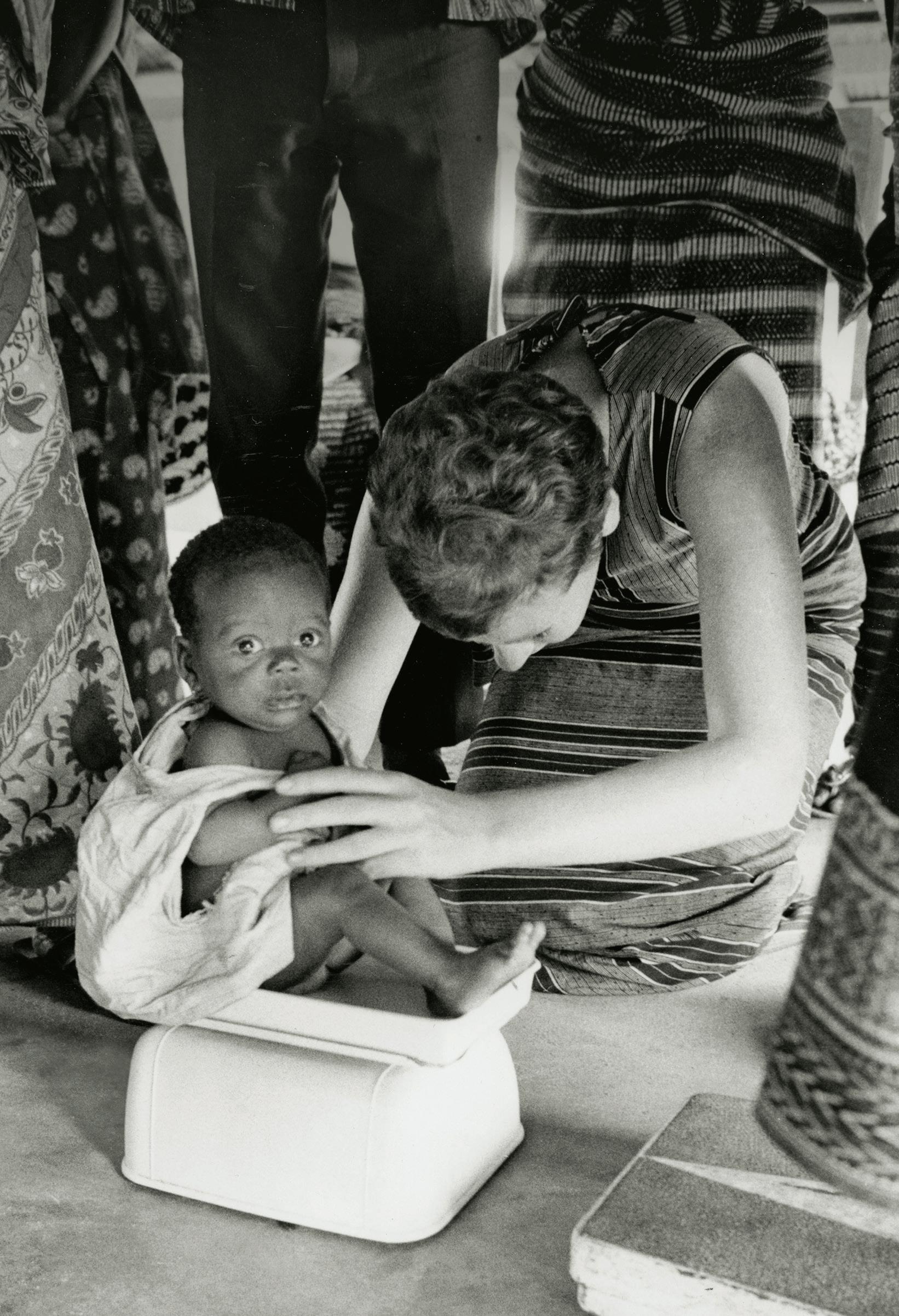
One year later, in 1961, Kennedy signed an executive order creating the Peace Corps, a U.S. government program that trains and deploys volunteers to provide international development assistance. The goal (aside from world peace) was to compete with the Soviet Union by promoting a better understanding of America while giving Americans a better understanding of the world. That opportunity took off at the UW, which, since 2001, has consistently ranked in the top three volunteer-producing universities in the nation.
“Being situated in the Pacific Northwest, UW students tend to be very keyed into current events and issues,” explains Amanda Li, the UW Peace Corps campus recruiter. Since 1961, the UW has sent 3,132 changemakers all over the world. After a pause in volunteerism during the pandemic, 24 recent UW graduates currently serve in 16 countries worldwide.
Left, volunteer Jean Fink, ’70, weighs a child in Ivory Coast. In the early 1970s, when she was stationed there, the Peace Corps focused on community development and health education.
Right, Stanley Harris, ’66, ’70, sits at the controls at the Belize Radio Station. As chief electronics technician, he repaired equipment and taught residents to use the sound broadcasting system.
�op right, Barbara MacLeod, ’69, and fellow volunteer Carol Rushin exit a cave after a day’s work. �heir job included locating and mapping caves in Belize.
56 UW MAGAZINE
Peace Corps by the Numbers
3,132 volunteers from the UW have served in the Peace Corps

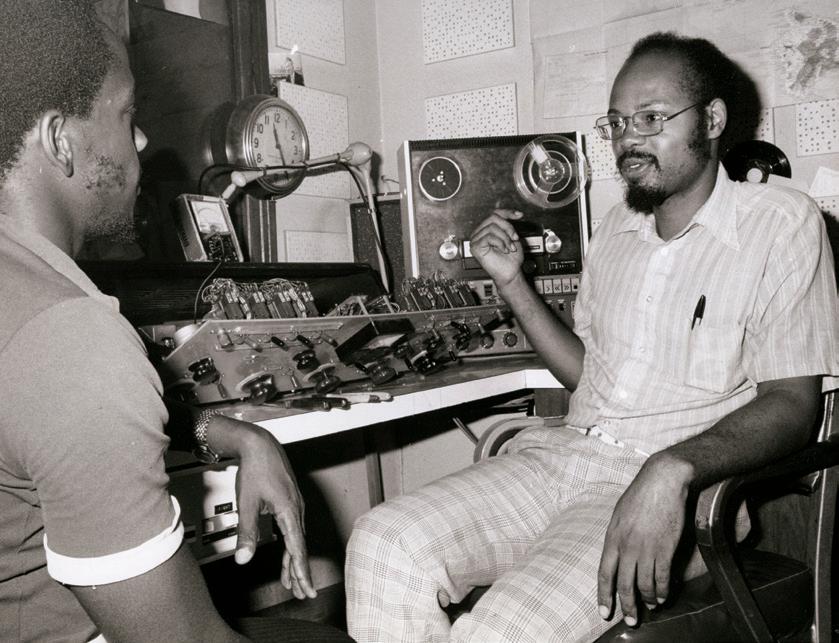

16 countries are hosting UW alumni volunteers right now
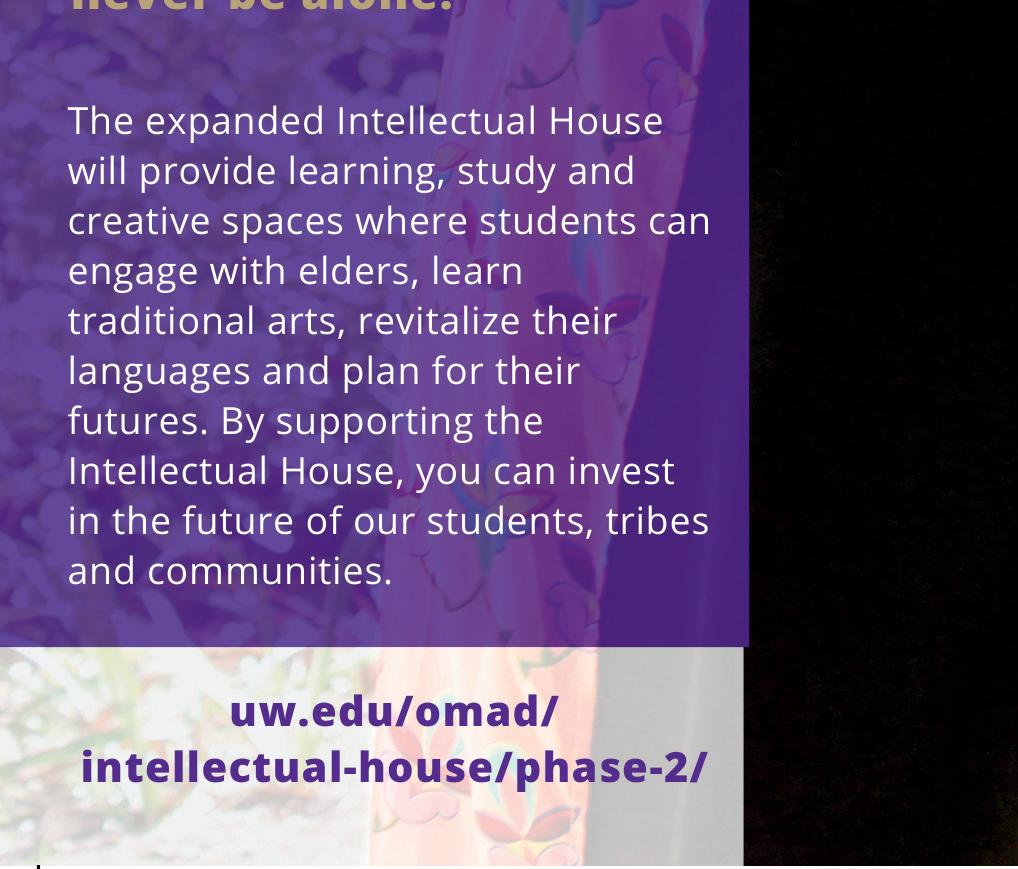


240,000 Americans have served
143 countries have been served
27 months equals length of service

1,000 volunteers worldwide are dedicated to climate change projects
$0 salary provided to volunteers, who recieve a stipend for room and board
COURTESY PEACE CORPS (3)
Untitled-3 1 8/15/23 10:48 AM
DISCOVER WHAT MAKES YOU SHINE
Certificates, degrees and courses for busy adults, with flexible options in the evening and online.

4333 Brooklyn Ave NE Campus Box 359508 Seattle, WA 98195











 By Hannelore Sudermann
By Hannelore Sudermann



































































 Jane Wong browses the shelves at Open Books: A Poem Emporium, a poetry bookstore in Seattle’s Pioneer Square neighborhood.
Jane Wong browses the shelves at Open Books: A Poem Emporium, a poetry bookstore in Seattle’s Pioneer Square neighborhood.














 By Isaiah Brookshire
By Isaiah Brookshire










 BY CAITLIN KLASK
Tom Hinckley learned to see the forest for the trees
PHOTO BY RON WURZER
BY CAITLIN KLASK
Tom Hinckley learned to see the forest for the trees
PHOTO BY RON WURZER




















































